2024-04-14 22:23:46
Soph Dyer
Augarten, Wien, Austria
Austria
NOAA-18




The wind has been squally, like my body. I woke tired. To reclaim my body, I swim one kilometre at the local pool. The full sensory experience of swimming focuses me on breath and rhythm, in ways other sport cannot. I feel my muscles and enjoy imagining the small exercised-induced testosterone boost. I feel back inside my body, home.
2024-06-25 12:36:45
Soph Dyer
Augarten, Wien, Vienna
Vienna
NOAA-18

I thought that I'd overheat but cloud came between me and the sun. It's hot, but not too hot, and the heat is dry. I feel more at peace in my body today. I know that I need to listen to it and respect its limits while it heals. The city building's are no longer cooler inside than out. I am trying to be productive, get work done, but really I want to be lying flat on my bed or dipping in the cool waters of the Danube. How are you Sasha?
2024-06-14 11:36:59
Soph Dyer, Nicola Locatelli
Stefy & C. Market Di Gallizia S. e Valent S. Snc, Moggio di Sotto, Italy
Italy
NOAA-18


I cannot focus on the meteorological weather as a delivery truck arrives to unload at the supermarket, which carefully crop out of shot. In the moment irritated the moment, but later accept my foolishness of my desire to document the mountains without people, cars and the heavy industry that lines the Fiume Fella river valley.
2024-06-12 20:04:12
Soph Dyer
Dordolla, Italy
Italy
NOAA-15





A musician, Pietro, joins us for the satellite pass. The alpine village of Dordolla is so small, we just needed to walk around for word to get to Pietro that we were at the only bar. There is a light drizzle. N makes a beat to the sound of the satellite, tapping the puddle with his foot. Pietro makes a sound recording. He is a drummer. The air is thick with moisture. The energy of yesterday's electrical storm has dissipated, but the clouds have not broken yet.
2024-06-14 21:53:37
Soph Dyer
Tiere Viere, Dordolla, Italy
Italy
NOAA-19


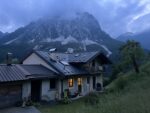

The sky is meeting the mountain. Fair weather, finally. Rain was forecast but did not come. The air smells good. It is a crisp, clear night.
2024-06-16 22:39:42
Soph Dyer
At home, Wien, Austria
Austria
NOAA-18



The tat tat tat of toy machine gun drifts up from the otherwise empty street.
It is warm, comfortable.
When we got home from the holiday the tomato plants were stressed from thirst and had curled their leaves from prevent water loss.
After visiting such radically different climates – the dry heat of Istria and the wet cold of Firuli – and after overhearing my sister swap farming anecdotes of a too wet, too cold spring-summer with our host in the agriturismo, I contemplate how local climate is is and the importance of grounding theories of weather knowledge in specific sites.
2024-06-17 12:37:54
Soph Dyer
At home, Wien, Austria
Austria
NOAA-18


I rush out between Zooms calls to receive this satellite image on the balcony. The weather is warm dry, my mood is light, even joyful. I prop the my phone up on a potted Yuca, so as to get the tomato plants in the frame.
2024-06-18 12:23:59
Soph Dyer
Augarten, Wien, Austria
Austria
NOAA-18
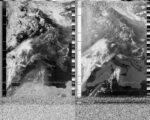


It's heating up. I enjoy how the city radiates heat from all directions, loosening my muscles. I embrace the floppy feeling. Yet Vienna is not yet built for sustained summer heat. Its surfaces are mostly sealed, there is too little vegetation, and it does not cool-off enough at night.
I am standing in the blazing midday with sun cream and sun glasses but no hat. I am still learning how to live in a country that is a little hotter, a little drier than the North of England where I grew up. A group of young school children pass, all wearing matching caps. I take note. Buy a cap. During the satellite pass I try turning on a feature of the software defined radio programme called Automatic Gain Control or AGC for short. Gain is a property of the antenna, which can be manipulated in the software … and this still confuses me. Usually, I use the programme's waterfall display to manually adjust the gain, however today, keen to improve my understanding of gain and the software, I experiment with turning the two AGC functions on and off, and then both on at the same time. The waterfall display turns from blue to yellow to red. To my ears, the signal to noise ratio sounds worse, however the resulting image looks surprisingly uniform. In my studio, M, shares with me a weather forecast from the ORF, Austria's national public broadcaster. She wants me to know that Saharan Dust is forecast for Friday.
2024-07-25 22:53:01
Soph Dyer
Lacknergasse, Wien
Wien
NOAA-18


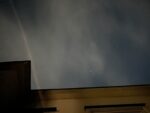
Cool temperature. Still night. There is a thin film of cloud.
Earlier, inn the hospital, I read a draft of Wind’s Animacies by Sasha. The article sweeps me up, taking me far from the fluorescent lighting and airless weather of the waiting room. I turn over her question, "what does the wind remember?" I am moved by it, perhaps because I am grappling with how to reorganise or cohere a messy medical history of ill health with the new knowledge that comes with a diagnosis.
I find myself caught between wanting to forget the lost days in bed with a pillow tucked under my abdomen, or the sleepless nights and listless days that followed. Could an earlier diagnosis have changed the course of my access to treatment? This is is both too painful and utterly pointless to think about.
I want to reorganise my memories into a tidy narrative of endometriosis, cysts and fibroids, rather than the current cluster of unexplained, possibly unrelated symptoms that moved around my body to the extent that I stopped trusting myself as reliable narrator.
I am thinking with Sasha's words: is pain is similar to wind? Neither are immaterial or material. Is pain not energetic, “slippery”, “leaky”?
Thinking about wind’s memory is an analytic move away from asking “where does the wind come from?” (n.d. Engelmmann) A question that forces an artificial cut into time to arrive at a single origin point. I exercise changing the familiar questions “Where does the pain originate?” or “When did the pain begin?" to “What does my body remember?” This new question requires me to relearn to trust it my body and its complaints. To piece it back together.
In a wholly different context, that of the 2016 US presidential election, American essayist and anarchist Rebecca Solnit writes “when the subject is grim, I think of the act of naming as diagnosis.” Diagnosis does not equal a cure, but it is an act of recognition that has the potential to reorganise and make sense of memories.
2024-07-02 21:32:41
Soph Dyer
Sarajevo, Bosnia and Herzegovina
Bosnia and Herzegovina
NOAA-19


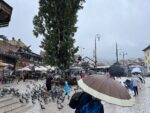
It's been raining. I wait for the weather to clear and capture the satellite's transmission in the dark next to Kovači Cemetery. The low stone wall I am sitting on is cold and damp. The cobbled road near me is empty but at its end, where it opens onto a broader street, people gather at the entrance to a mosque. Uneasy about the location, chosen without knowledge of the city because of it is the closest open space to where we are staying, I attempt blend with the night.
2024-07-09 10:12:00
Soph Dyer
Duboka, Vis, Croatia
Croatia
NOAA-19



Woke surprised by hot the apartment already was. As I set up my antenna on the track leading into the village, an older man and woman came out of their house to offer me local produce. Sweating, declined in stilted English. Perhaps I sounded Spanish as the conversation turned into an exchange of "Mucho calor!"
2024-07-04 21:05:37
Soph Dyer
Miholjače, Bosnia and Herzegovina
Bosnia and Herzegovina
NOAA-19



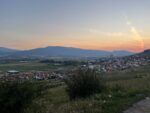

Two fire flies flash. I watch the coal mine and power plant on the plateaux, my radio antenna balanced on a rock above the road. A hazy red sunset bleeds out into darkness. On a walk this afternoon, the owner of the guest house pointed to the where an underground river was being rerouted to accommodate industry. His tone seemed to express a mixture of depression and despair. He did not mention the coal power station, which is not visible from the house. Now I see it, I imagine it thirstily drinking the river.
2024-07-03 21:19:36
Soph Dyer
Sarajevo, Bosnia and Herzegovina
Bosnia and Herzegovina
NOAA-19



I am stood in the backyard of our host's house. Deep greens and reds of a flowering vine frame the midnight blue sky. Today, N and I visited the Museum of Crimes Against Humanity and Genocide, and then rode a cable car built for the 1984 Winter Olympics to a hilltop overlooking the city. In the evening, we walking along the Miljacka River to the book store 'Buybook Sarajevo' we stumbled on the opening of the BOOKSTAN literature festival. Before we realise that there is a festival, the crowd gathered out side felt familiar. Enjoying the atmosphere, we purchased two white wines and sat on a park bench. As N is at the bar buying a second round, I complement the small dog of an elegant older woman. She tells me that she is a translator of an English language book about the siege written by an author living in the United States. She is here to meet the author, she tells me, and will not stay for the festival as she is already looking forward to returning to her home in the countryside. When I later search for the festival programme online, I find its tagline: “A literary festival where there is neither East nor West, but just humans and their stories”. This evening my memories of working on war crimes investigations in Syria, Iraq and Ukraine, mingle with the stories of survivors from the museum displays. As we were entering the last room of the museum, I thought I could hear a video. There was no video, instead an older woman and man speaking in Bosnian. They looked distressed, I think the woman was crying. The couple were being interviewed by a small film crew. The walls of the yard block my view of the Sarajevo below, yet I know that the city I arrived in three days looks different.
2024-07-10 11:46:31
Soph Dyer
Duboka, Vis, Croatia
Croatia
NOAA-19

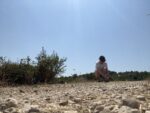



Intense heat stops me thinking. I sweat into my teeshirt and instantly regret exposing myself to the unforgiving sun. "Tomorrow", I note to myself, "wait until nightfall".
2024-07-13 22:42:00
Soph Dyer
Duboka, Vis Island, Croatia
Croatia
NOAA-18


2024-08-29 19:17:00
Prototype Automatic Ground Station 2
Vienna, Austria
Austria
NOAA-15

Satellite not known.
2024-08-28 19:30:00
Prototype Automatic Ground Station 2
Vienna, Austria
Austria
NOAA-15

Satellite not known.
2024-08-28 10:46:50
Sasha Engelmann
Hackney Downs, London, United Kingdom
United Kingdom
NOAA-19


Today the air is still - not so much as a small gust as I orient my Yagi antenna from north to south, tracking NOAA-19. The sky is veiled with light cloud and contrails, and things feel grounded, heavy but not placid. Indeed I feel so unusually calm that I don't leave the house until the satellite pass is actually starting, meaning I am six minutes late to press 'record'. A man is driving around the park with a large tank of water on the back of a truck, watering trees. This feels like such a benevolent and kind thing to do, though I am sure water must be rationed as the trees are turning yellow-brown far too early. As he drives by me, he smiles and gives me a thumbs up from the car window.
2024-08-27 11:52:02
Sasha Engelmann
Hackney Downs, London, United Kingdom
United Kingdom
NOAA-18



Another windy day, with gusts coming from both the south and west across Hackney Downs. Tree branches and pieces of bark have been peeled off trees and lie on the pavement or grass. Once again my tape measure Yagi was pushed and pulled around by the air, and once again I feared the delicate bits of soldering would come undone. When the dipoles bent down at odd angles, lines of noise permeated the audio recording. I realised today that I had never fully explored the fact that antennas could be malleable- able to move and bend with the wind. We associate antennas with very tall steel towers or elaborate metal sculptures that are nevertheless solid and static- but what about an antenna made of flexible material? I've been aware of 'wearable antennas' via the work of artists like Afroditi Psarra or Audrey Briot, and I have seen experiments in metal weaving, but my tape measure Yagi has raised other questions about working with semi-flexible, yet conductive materials that change rather than holding shape when exposed to air.
2024-08-27 19:42:00
Prototype Automatic Ground Station 2
Vienna, Austria
Austria
NOAA-15

Satellite not known.
2024-08-26 20:50:00
Prototype Automatic Ground Station 2
Vienna, Austria
Austria
NOAA-15

Satellite not known.
2024-08-26 12:02:33
Sasha Engelmann
Hackney Downs, London, United Kingdom
United Kingdom
NOAA-18



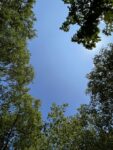
On my way back from the park with my tape measure Yagi, I saw the well-known local character who wears a tracksuit and stands on benches practicing martial arts, every day rain or shine. I smiled and waved hello, and he immediately exclaimed 'there's the aerial!' and for a moment, I think, mis-gendered me, as he called out something like 'oh- a girl!'. He jumped down from his bench and started asking questions- had he seen me before in the park? was I from America? how do I like Hackney? I learned his name is 'Joe' but everyone calls him 'Shaolin Joe' because he practices the Shaolin Arts (martial arts) in public around Hackney and Clapton. I tried to explain why I use my Yagi antenna to capture images from satellites, and he compared my daily satellite passes to the Shaolin Arts... 'meditating with your satellites'. We shook hands and he called out after me 'Have a great day!!' and something like 'good American!'
2024-08-25 18:56:29
Sasha Engelmann
Hackney Downs, London, United Kingdom
United Kingdom
NOAA-15



I awoke to a flood of sunlight in the apartment, though the colder air temperatures persisted. My head and body ached and I wondered about residual tiredness or a travel bug. This was all counter-balanced by a morning of indoor plant gardening: trimming the willow tree in the corner of the living room, crafting support structures for newly grown arms of vines near the ceiling, and watering others. When I finally emerged from me and T's apartment to catch an early evening pass in the park, the wind caused the dipoles of my tape measure Yagi to bend and angle all over the place. I tried to find positions where the antenna would slice through the air rather than be buffeted like a kite, but often gusts came from unexpected directions. It was not stormy, but unusually unpleasant, especially with the recent memory of sun-drenched beaches and warmer air.
2024-08-24 19:20:36
Sasha Engelmann
Hackney Downs, London, United Kingdom
United Kingdom
NOAA-15

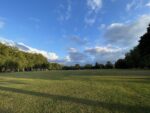


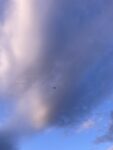
From the heat, humidity and air pollution alerts of northern Italy, T and I travelled back to the UK by airplane in the mid-morning. The previous evening, a thick red and orange layer of particles coated the horizon. It was particularly visible during a long, late afternoon swim to the buoy that marks the limit of the swimming zone at the beach of Lignano Sabbiadoro. Normally, while swimming one can see the coastline of the lagoon and even as far as Trieste, but the haze completely occluded our vision. I read that the air pollution alert would increase in urgency over the rest of the weekend, and wondered whether my asthmatic lungs would react, or whether we were leaving too early on Saturday for my lungs to register. The airplane journey was cloud-free until we reached the agricultural flatlands of Germany, when a few cotton ball clouds appeared. By the time we were crossing the English channel, there were at least three layers of cloud: a thin, staccato layer above the airplane; an intermediary, patchy layer below; and a thicker, grey, monotonous layer close to the ground. We descended through the middle layer but spent another thirty minutes circling above and within the lower layer before landing. As we emerged from the plane, passengers cried out at the cold drizzle and wrapped their bare, tanned shoulders in scarves and other random clothing items - taken by surprise. The rain came and went for the rest of the day. I chose a lucky rain-break to head out to Hackney Downs with my yagi antenna for an evening pass. I noticed yellowed grass; large clumps of maturing chestnuts; and the late-August sunset piercing through the trees to the west, making silhouettes of people gathered around a bench with a sound system. I thought about Soph and urged Soph's cells and molecules to keep binding, smoothing, healing.
2024-08-25 08:37:00
Prototype Automatic Ground Station 2
Vienna, Austria
Austria
NOAA-15
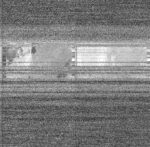
Satellite not known.
2024-08-24 08:49:00
Prototype Automatic Ground Station 2
Vienna, Austria
Austria
NOAA-15
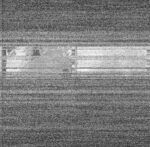
Satellite not known.
2024-08-23 11:04:44
Sasha Engelmann
Belvedere Trabucco in Lignano Sabbiadoro, Italy
Italy
NOAA-19





When I arrived at the Belvedere Trabucco - a wooden pier facing the lagoon north of Ligano Sabbiadoro - I discovered it was full of fishing poles. Some older men and a few teenagers were monitoring the poles and their long, taught fishing lines. One young person re-attached the lure on their line - it looked like a spider or dragonfly. Fixing my radio antenna to the edge of the wooden railing, I fished for signals. The sound of NOAA-19 emerged soon after, and gained in strength quickly, as there was almost nothing between me and the Northern horizon except the lagoon and a thin line of land in the distance. In the greenish water below I could see the characteristic clumps of material called 'mucilagine' in Italy. Though mucilagine has been known for hundreds of years and is caused by a non-toxic microalgae, Gonyaulax, it has increased in quantity with rising Adriatic sea temperatures and it poses a growing problem to small fishing boats and businesses. Apparently, some hotels along the Italian coastline are even sending 'mucilagine weather reports' to tourists and travellers who want updated, semi real-time information on the spread of mucilagine in seawater before arriving at the beach.
2024-08-23 09:58:00
Prototype Automatic Ground Station 2
Vienna, Austria
Austria
NOAA-15

Satellite not known.
2024-08-22 17:29:00
Prototype Automatic Ground Station Wien
Vienna, Austria
Austria
NOAA-15

Satellite not known.
2024-08-21 12:28:55
Sasha Engelmann
Quercia delle Checche near Pienza, Italy
Italy
NOAA-18




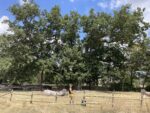
The quercia delle Checche, an approximately 300 year old oak tree and Italy’s first ‘green monument’, is full of dense, perfectly shaped leaves and is apparently thriving despite the dry summer. Planted in the 18th century, the oak was one of the few to survive the rapid landscape changes of the Tuscan countryside as the oak woodland was deforested in favour of agriculture. Rumour has it that Napoleon’s troops stopped to rest in its shade. Numerous local weddings, trysts, rituals and gatherings have occurred under and around its branches. Two large horizontal branches have fallen and now lie like giant bones in the yellow grass. Up close, the dry wood of the branches has whorls and shapes that remind me of Kármán vortex streets caused by wind flowing around islands or mountains. I wonder what events caused the wood to ‘flow’ in this way- what memories does it hold?
2024-08-17 23:02:39
Sasha Engelmann
Jadrolinja Ferry in the Adriatic Sea between Split and Ancona, Croatia
Croatia
NOAA-18





The almost-full moon hung ponderously over the southern horizon of the Adriatic as we made our way slowly across it in an overnight ferry from Split to Ancona (Italy). T and I had hustled on with our car and luggage around 21:30 and by 23:00 we were in the open sea. Languages swum between Croatian, Italian and French as we qued for dinner and wandered around. People had hung hammocks up between stairwells and railings. Others had blown up mattresses on the landings between stairwells, and others were just lying on a thin layer of blanket, exposed to the wind and weather of the sea. As I set up for a 23:01 satellite pass, the air was so humid and sticky- touching the metal railing of the ferry felt like touching liquorice. The darkness of the sea at night felt ominous and limitless.
2024-08-17 18:24:32
Sasha Engelmann
Jadrolinja Ferry between Stari Grad and Split, Croatia
Croatia
NOAA-15




The inside deck of the Jadrolinja ferry from Stari Grad to Split was far too crowded, so me and T sat on the floor of the upper deck. The air rushed around us, but the humidity stuck to our hair and skin. We said goodbye to Hvar for the summer. I said goodbye to my Baba.
2024-08-17 10:39:33
Sasha Engelmann
Zaraće, village of Gdinj, island Hvar, Croatia
Croatia
NOAA-19




A thin veil hung over the bay this morning, making the sunlight a little bit weaker and more silvery. Me and T had slept in after a hot and sweaty night during which both of us sat up awake at 3am. I squeezed between the bunk beds and tiptoed outside with my radio antenna before any coffee was brewed. As I suspected, leaving out the extension cable meant that I could receive the pass easily and clearly from the rooftop terrace. I hooked the antenna tripod on the edge of a plastic beach chair and held the android phone on my lap, watching the patterns of the mid-morning current in the bay. By the time I was done, I could see the grills starting to smoke to the left and across the water, preparation for a fish lunch.
2024-08-16 18:53:42
Sasha Engelmann
The rocks of Zaraće, village of Gdinj, island Hvar, Croatia
Croatia
NOAA-15
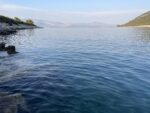



A school of tiny black fish swirled around the rocks, and island swallows swooped and dived for insects above. I sat on a rocky perch at the edge of the sea, under the fisherman’s chapel, where someone had left a bouquet of olive branches, Tradescantia pallida, yellow cow parsley and long grass. A fisherman walked past me on the rocks and I suspected I had taken his usual spot, but he didn’t ask me to move, and he climbed on further, somewhat awkwardly navigating the steep Karst with its jagged edges and slant into the sea. I meditated on the deep time histories of Hvar - how my memories of Zaraće were so bound up with every edge of these rocks, and how far back in time they had emerged from the ocean floor, pushed up by tectonic and geomorphic processes. As I faintly recorded NOAA-15 at only thirty degrees to the east, the tide was coming in, and by the time I packed up, the sea was waking up the limpets and sleeping snails where my feet had been.
2024-08-20 19:28:00
Prototype Automatic Ground Station 2
Vienna, Austria
Austria
NOAA-15

Satellite not known.
2024-08-18 21:56:16
Soph Dyer
Lacknergasse, Wien, Austria
Austria
NOAA-19


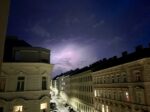


There was a big electrical storm this evening. Bolts of lightening flashed between clouds for hours. As I have spent most of my time indoors over the last two weeks, so to witness this weather event, even from the window, was exhilarating. My recovery from the surgery has been uneven and absolutely nonlinear. I have moments of pure joy, such as when I woke from a nap feeling completely rested, my mind loose but still. But by the afternoon, I miss physical exercise and social contact. I know that I need to ride out this turbulence. Or rather ride with it.
NOTE: I received the satellite image after the storm had passed and the stars were out.
2024-07-18 21:38:15
Soph Dyer
Diepoldplatz, Wien, Austria
Austria
NOAA-19


A soupy night. Warm and still. Older men on park benches smoke and watched as I point my antenna. My phone crashes multiple times. I focus on the long beans handing from the tree in front of me. The last kids of the day shouted in the park, two whizz around on scooters with LED lights in their wheels. I try to ignore the men’s gaze and relax into the warmth of the night.
2024-07-17 21:51:08
Soph Dyer
Lacknergasse, Wien, Austria
Austria
NOAA-19

Mottled cloud mellowed the sun and a breeze prevented the air from feeling too close. On the balcony it is dark, grasshoppers sing. The tomatoes are recovering from a lack of water while N and I were on holiday. The crop is about on third ripe. Despite the stress of returning to medical admin and heavy weather between me and N, it’s been a good first day back at work. Sasha and I spoke for more than three hours. The feeling of pressure on my chest is easing. I will make the most of the cool night and sleep early.
2024-08-12 21:29:05
Sasha Engelmann
Zaraće, village of Gdinj, island Hvar, Croatia
Croatia
NOAA-19

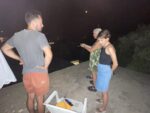



As I set up my ground station on the edge of the concrete terrace at my Mom’s house in Zaraće (a small bay in the village of Gdinj, island Hvar, Croatia) I could feel the concrete emanating heat accumulated over the day. The prior evening a small group of us (friends and family) had ventured out to the warm rocks at night to watch for the Perseids - and we saw several meteors, sometimes so numerous they seemed to speak to each other in the sky. One very powerful meteor passed from 90 degrees above us in a long orange streak to the horizon. Gdinj (and Zaraće) is an origin point for my family - one that stretches back for generations on my mother’s side, through the Čurin family who settled in Gdinj, grew lavendar, cultivated olive trees for oil, and fished in the sea. I remember my Deda (grandfather) waking up at dawn to collect the fish of the day from nets that had been laid out by hand the evening before. It wasn't so long ago that the only way to travel from Gdinj, on the top of the island, to Zaraće at the sea, was by mule or donkey along a narrow dirt path. It wasn't so long ago (only last summer) that I came to Gdinj for my Baba Albina's funeral, an event that drew the whole village, and with people driving from as far away as Belgrade. In the local cemetary, mom and I each read a small passage, and my Mom also read a poem by Vesna Parun. It is always intense for me to be (back) here. I want to forget about the practicalities of life - how to get clean water (the water 'cisterns' aren't always the safest to drink from), how to get food, who to go for ‘kavu’ (coffee) with. I want to just lie without a towel or goggles or rock-shoes on the pale, jagged, karst rocks and stare at the sea. Indeed I have spent so many of my summers doing exactly this, I wonder if my small bones are laced with limestone, seawater, algae, olive, lavender.
2024-07-15 22:12:09
Soph Dyer
Perković Railway Station, Croatia
Croatia
NOAA-19



"I wonder if climate change can be measured in hot tracks?" you reply in response to my photo. N and I are waiting with perhaps a hundred other passengers at a small railway station outside Split. The reason, we are told by a cheery Austrian train guard, is that the railway tracks are too hot for the train to proceed. We must wait for them to cool. It is more of a novelty than an inconvenience to be stranded in the warm night with strangers. Assured by the guard that the train will not leave anytime soon, I made a dash to a local store to buy extra water and two ice creams. The small shop is filled with fellow passengers. The atmosphere is convivial if a little restless as we wait for the shop attendant to finish slicing ham for a local customer. I return feeling victorious, carrying the ice creams, the train has not left and will not leave another two hours.
2024-07-14 23:32:15
Soph Dyer
Duboka, Croatia, Croatia
Croatia
NOAA-18



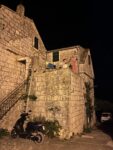

There are even more Mauve Singers in the bay, too many to swim without being vigilant. N and I collect white plastic rubbed smooth by the Mediterranean and bring it back up to the village in bags. Our host is distressed and moved to apologise by the sight of so much plastic. He is an older man possibly no longer unable to make the steep 25 minute hike down to the water. He mentions the heat and then "the Albanians". N is confused and thinks that Albanian tourists have been littering in the bay, as opposed to racialised ocean currents carrying the trash from the Albanian coastline. His misunderstanding lightens my mood.
2024-07-11 22:25:02
Soph Dyer
Duboka, Vis, Croatia
Croatia
NOAA-18




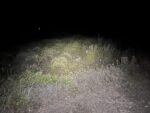
I am getting better at staying cool headed in the heat. Blue skies, a few clouds. A gentle wind brought some relief. Today was hotter than yesterday. Our host said that he installed the air conditioning unit the day we arrived. He complained many times about the heat. It was a reassuring to know, as a Northener, that I was not the only on struggling. Yet it was disconcerting to know that the heat was new. It has not always been this way. N and I waited until the relative cool of the night to receive a satellite pass. We walked down to a track leading away from the village. Using a head torch, I checked for snakes. To my relief, I found a grass hopper laying eggs and a stray cat. Towards the end of the pass, curious to know what other animals might be near, I looked around for more eyeshine. My survey revealed many small green dots. I approached, expecting to find small animals, perhaps lizards warming themselves on the stone? Instead, behind each green dot was a Radiated Wolf Spider. N and I were being watched by tens of spiders. I dislike spiders so quickly packed-up and retreated to the house, eyeing the green dots lining the track.
2024-08-19 20:38:00
Prototype Automatic Ground Station 2
Vienna, Austria
Austria
NOAA-15

Satellite not known.
2024-08-18 20:50:00
Prototype Automatic Ground Station 2
Vienna, Austria
Austria
NOAA-15

Satellite not known.
2024-08-17 06:35:00
Prototype Automatic Ground Station 2
Vienna, Austria
Austria
NOAA-15

Satellite not known.
2024-08-16 08:48:00
Prototype Automatic Ground Station 2
Vienna, Austria
Austria
NOAA-15

Satellite not known.
2024-08-14 17:35:00
Prototype Automatic Ground Station 2
Vienna, Austria
Austria
NOAA-15

Satellite not known.
2024-08-14 10:11:00
Prototype Automatic Ground Station 2
Vienna, Austria
Austria
NOAA-15

Satellite not known.
2024-08-13 06:38:00
Prototype Automatic Ground Station 2
Vienna, Austria
Austria
NOAA-15

Satellite not known.
2024-08-12 19:27:00
Prototype Automatic Ground Station 2
Vienna, Austria
Austria
NOAA-15

Satellite not known.
2024-08-11 19:39:00
Prototype Automatic Ground Station 2
Vienna, Austria
Austria
NOAA-15
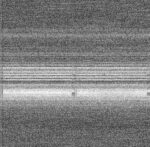
Satellite not known.
2024-08-10 20:50:00
Prototype Automatic Ground Station 2
Vienna, Austria
Austria
NOAA-15

Satellite not known.
2024-06-07 13:41:29
Sasha Engelmann
Hackney Downs, London,
NOAA-18


The sun was rising when I rode my bike through Hackney Downs this morning, coming back home from a club in Dalston. My limbs felt both heavy and light in the very pleasing way that limbs feel when you have been dancing for hours. People were already in the park, or maybe they had been there the whole night. I could see the faint spark of a cigarette in a huddle of bodies between the hedges. I thought about getting my radio antenna and catching a pass at dawn, but sleep was too tempting. Later, at almost 2pm, I re-emerged from my flat and went back to the park. In contrast to the soft, orange-pink glow of the early morning, the early afternoon was warm, hot and dry. As I started the pass, a man in a group of men that normally always stand around a bench at the north-east corner of the park, around thirty-forty metres away from me, yelled "Is that for free internet?!". I could only think to yell back, "No!". As I couldn't explain at such distance, I used my free arm to point to the northern horizon and traced an arc through the sky from North to South. That seemed to help. He yelled again "What are you tracking!!?" and I replied "A satellite!! An image!!". As no members of the group looked like they were going to come any nearer, I walked over to them after the pass was done, and showed them the live-decoded image. They huddled around my computer. I wondered what they might say about the weather, given that the five to six of them are always here at this bench, all day, every day, rain or shine. Instead, they asked me what the weather was going to be like. I said I was not a meteorologist, but the image was showing different patterns of clouds over the Atlantic, maybe coming to the UK. They seemed to like this. One of them said 'nice one mate' and shook my hand in the way men do when they put out their arms, bent at the elbow, with the hand close to the chest. When you close hands you end up getting pulled together in a show of comraderie.
2024-06-06 12:11:30
Sasha Engelmann
Hackney Downs, London, United Kingdom
United Kingdom
NOAA-18



Over these last couple weeks, I sometimes observe the darkness of the landforms in the satellite images, especially in the Infrared Channel, usually on the right side. Though I have not studied infrared radiation scientifically, I know that, in the Infrared channel, the darker the pixels suggest that something is 'warmer' while the lighter pixels suggest 'cooler'. In today's image, even the northernmost part of Norway appears to be relatively dark, emanating and radiating heat against the neutral gray of the Barents Sea. The coastline and interior of the African continent also stands out in the InfraRed channel. Yesterday, a colleague who works in Cambodia studying the lives and labour of brick kiln workers told me about how the workers measure time and seasons by how fast it takes a large ball of clay to dry outside. In some seasons it takes five days, while in other seasons it only takes five hours. Their work rhythms are intimately related to the drying of the clay, and so also the heat and movement of air. In a meeting this morning I was reminded of Michael Taussig's writing on heat. He says, "Heat is a force like color, that sets aside the understanding in place of something less conscious and more overflowing, radiance instead of line, immanence instead of the famous bird's eye view" (Taussig, 2004: 31). As I pored over the 'satellite-eye's view' of today, I wondered about where heat as a 'force' shows up. Does it only show up in the clay ball that tells about heat by how fast it dries? Or does the force somehow also 'show up' in the satellite image, in the darkness and contrast of pixels? Thinking of the ball of clay makes me feel more connected to the idea of heat as 'force', but I keep wondering whether there are ways to use colour ('something less conscious and more overflowing') to demonstrate or express more of heat in the satellite image. In contrast to 'heat maps' where red and dark purple often signify the intensity of heat, how else could colour map heat, how else might it suggest 'immanence' or 'radiance' instead of line?
2024-06-04 09:27:43
Sasha Engelmann
Grassy Field near the Physics Department, Royal Holloway University of London, United Kingdom
United Kingdom
NOAA-15


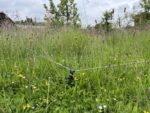


Today has been about rhythms. I organised and choreographed so many rhythms for myself and others, but the most intense was chairing a meeting with Soph and two Croatian scientists with whom I have been in email contact for months, and whose work I have studied extensively in order to include in a recent article on 'wind's animacies' and dust over the Mediterranean and Adriatic Sea. After so many protracted email exchanges and engaging slowly and carefully with their scientific work these last months, meeting them online was an experience of personality-encounter, joy, Croatian-language exchanges and rapid firing of questions (though I didn't manage to ask all the questions on my list). Later, during a research group seminar on ‘research rhythms’, we read aloud and discussed fragments of writing that suggested different rhythms, whether poetic, scholarly, scalar, material, or musical. The notion of ‘rhythming’ in research and a general tuning to the ‘science of the word’ is examined in an essay called "Rhythm, or On Sylvia Wynter's Science of the Word" by Katherine McKittrick, Frances H. O'Shaughnessy and Kendall Witaszek (2018). Starting from the work of poet and philosopher Aime Césaire, the authors write: “Césaire’s observation—that a creative science reckons with how poetic knowledge “is born in the great silence of scientific knowledge”—calls on the harmonious structures of collaborative thought in order to reconceptualize what it means to be human”. In other words, a 'creative science' suggests that there are ways to speak and enunciate research (including science) that are more truly collaborative and so rhythmic. I was immediately reminded of the interdisciplinary collaboration of the Croatian scientists and their willingness to be in dialogue with me and Soph on the call. McKittrick et al (2018) continue: “Like Césaire, Wynter does not turn away from scientific knowledge and privilege poetic knowledge, but rather shows that science of the word is an articulation of science and poetics together. This provides a “fulfilling knowledge,” one that understands the human in its most actualized form through the “climate of emotion and imagination.”” I love the idea of ‘science of the word’, that through a sensitivity to the craft of writing and ‘making’ words we are enacting a science that can perhaps see through the ‘silences’ of normative Science, which as the authors outline, has been responsible for articulating a version of nature that makes it possible to imagine and enact culture as separate to nature. We can ‘think science and poetics together’ in ‘fulfilling’, actualised and emotional ways. This is where I hope the collaboration and conversation with the scientists is going, though I know it is unfair to presume or predict outcomes. In the mean time, I want to return to their articles with an attention for 'science of the word' and 'narrative devices'.
2024-06-03 12:49:14
Sasha Engelmann
Hackney Downs, London, United Kingdom
United Kingdom
NOAA-18



This Monday was full of grey light and low hanging cloud, and after a morning of open-weather meetings, I found myself sitting in the middle of Hackney Downs, happy to be listening to the sound of a satellite but craving some colour. On my way back from the park, a bright burst of lichen caught my eye. I identified the species (or 'collaboration' between species) as within the family of Teloschistaceae which really refers to a large group of mostly lichen-forming fungi that have a 'cosmopolitan distribution' (meaning that they can be found in most places around the world, much like the pigeon and the orca). Most members of Teloschistaceae are lichens that either live on rock or on bark, but about 40 species are 'lichenicolous' – meaning they are non-lichenised fungi that live on other lichens. Apparently, in Spain, a member of this family of lichen-forming fungi has been included in wine-based decoctions for menstrual issues, and infused in water as a remedy for kidney and tooth ailments. Later in the day, I bought raspberries and blueberries entirely because of how they glowed bright-red and blue-purple in the fruit section of the local market.
2024-08-08 23:17:13
Sasha Engelmann
Lignano Sabbiadoro , Italy
Italy
NOAA-18



Acqua! ventisei. Sabbia! trentasette. (Water! twenty six. Sand! thirty seven). A voice called out the temperature of sea and land on a loudspeaker at the beach of Lignano Sabbiadoro on the Italian coast. I placed my towel on the sand next to a lifeguard station and felt the heat. People were running from their umbrellas to the sea (sometimes carrying small children) as the sand burned underfoot. I debated trying a satellite pass, decided not to in this unlikely location, and finally thought I’d try. Something about being in a swimsuit with the ground station immediately felt weird! My radio antenna got the attention of many, even at a distance - I caught several men with beer-bellies and leathery skin staring at me. Sadly I didn’t catch any signal - I had a big view of the sky, and checked and re-checked my settings, but it was difficult to see the tiny numbers in the android radio software in the sunlight. I decided to try again later, and I ended up catching a pass late at night from the balcony of T’s mom’s apartment. The shadowy form of the boot of Italy appeared in the infrared channel, lighter than the water (and therefore cooler). This puzzled me until I realised that land loses heat faster than water; the sea ‘holds’ it.
2024-08-09 21:03:00
Prototype Automatic Ground Station 2
Vienna, Austria
Austria
NOAA-15

Today, I came home from the hospital. The weather was fair and I wore a tee white printed shirt and black slacks, loose at the waist. Satellite not known.
2024-08-06 19:00:00
Prototype Automatic Ground Station 2
Vienna, Austria
Austria
NOAA-19

There was no satellite recording today because N was still troubleshooting the prototype ground station, so a bending of time, this recording is from tomorrow, the day of my operation. As I write this, I am waiting for the 'big day'. It’s raining, I can hear but not see the water cascade onto the hard facade the 1970s hospital building as the long curtains in my room are closed. Possibly for privacy or, I speculate, because the my roommate left for the operating theatre this morning when it was still dark. Either way the yellow glow of the artificial lights makes me groggy before anyone has even laid a finger on my body. A nurse searches for the word in English, “I will tie the bandage tight so as to stop a …. hema-toma." "Your vein opened too wide," she explains. "God", I say, "that sounds bad!" She reassures me, then sticks a cannula above my wrist where there seems too little flesh between skin and bone to cushion its intrusion. It stings. I watch my blood back flow into the two plastic tiny tubes. “I think that I’m going to throw up,” I say as a nurse announces lunch. I am given a cardboard bowl to throw up in and a tray with a clear soup, asparagus, rice, lettuce leaves, and a yogurt. I skip the yogurt and throwing up, and decide that I need sunlight. Opening the long curtains brings into view a drab but solid looking Altbau opposite. The rest of the day passes with time suspended between boredom, anxiety and grief, the sources of which I guess but chose not to give shape to with words.
Satellite not known.
2024-06-02 13:03:32
Sasha Engelmann
Hackney Downs, London, United Kingdom
United Kingdom
NOAA-18


My arms and legs are scraped from nettles and bracken after an afternoon at Richmond Park, but I feel so happy to have these reminders of a day among the oaks, elms and white-tailed deer. After I captured a hurried satellite image from the middle of Hackney Downs, my partner and I took a long overground train from Dalson Kingsland to Richmond station, and once in the park, we followed several trails away from the central lake and 'acid grassland' where most people congregate. The park was golden and shimmering in sunlight, and the greenness of everything was 'overwhelming' as my partner put it. Lying on a log in the sun, I opened my eyes to see a hawk making circles overhead, barefly moving a wing-feather. I heard a sound like a sneeze, and looked to the right, spotting a doe with two fawns. Lime green parrots talked excitedly in the branches and zipped from gnarly twig to tree trunk. A spider with a large bulbous abdomen scrambled over my leg.
2024-06-01 11:34:03
Sasha Engelmann
Hackney Downs, London, United Kingdom
United Kingdom
NOAA-18




As I begin the satellite pass, a young group of friends pass by, and one asks whether I am responsible for the pile of soccer balls a few metres away. This is a little funny, as there is an active young boy's soccer game on the field where we are standing, and I doubt I look much like a soccer player with my radio antenna. A young woman in the group yells to ask what I am doing, and after my one-sentence answer, they turn away and proceed to set up their picnic toward the south edge of the field. As I am packing up ten minutes later, though, the woman runs over and asks to see the image. She is joined by another friend. As I show them the enhancements of the image data, she remarks on the jagged coastline of the northern part of Norway, and the western edge of Scotland, wondering aloud whether the coasts are so complex because they receive the wind of the North Atlantic, whereas the east coasts are 'smoother' because they are more sheltered. As she speaks I admire her sparkly turqoise eyeliner and try not to stare. They are especially impressed by the colour infrared image of the highest cloud tops. They joke about how many times I must have explained this to other people in the park, and it's true, I say, I've met more people in the neighbourhood by waving an antenna at the sky than I might have by going to town hall. Half an hour later, I actually do join a Palestine march to Hackney Town Hall, following the echoes of protest chants through grey skies and an unusually cold wind.
2024-05-31 10:32:35
Sasha Engelmann
Burgess Park, London, United Kingdom
United Kingdom
NOAA-19

Today I am striking in solidarity with Palestine together with other UK-based practitioners and organisations. The strike is organised by Mosaic Rooms and Migrants in Culture, specifically calling for groups and individuals engaged in cultural work to withold labour today, May 31st. My academic work as a cultural geographer is part of the cultural milieu in the UK, as I publish open access articles related to artworks, artistic collaborations and networks. Though open-weather is a fragmentary, precariously funded cultural project, it does participate in the cultural sphere. In lieu of a long-winded 'weather note' or working on a new academic article, I am spending the day doing the following:
- Building an open access resource library on Palestine Geographies
- Emailing my union on moving forward a public statement on Palestine
- Engaging with and applying resources on university action by University and College Workers for Palestine
2024-05-30 12:03:48
Sasha Engelmann
East Park, Southampton, United Kingdom
United Kingdom
NOAA-18



Wind is the subject of a half-day symposium at John Hansard Gallery in Southampton where I am presenting on behalf of open-weather. I am looking forward to the constellation of academics, scholar-artists, and members of the public who are going to share new work and join the conversation. A scientist called Richard Cornes from the National Oceanography Centre talks about histories of weather observation gleaned from the diaries of French and English scientists who kept careful records of temperature and pressure. An artist named Abelardo Gil-Fournier who has just co-written a book with Jussi Parrika presents his sculptures and experiments in the cinematography of wind. Scholars Maximilian Hepach and Bergit Schneider examine the diaries of John Muir, the drawings of Da Vinci and the paintings of Van Gogh to 'read one elemental media ecology against another', for example reading air through a description of ice in Muir's semi-spiritual field notes. JR Carpenter and Jules Rawlinson perform a sonic, poetry and visual piece called An Island of Sound featuring fossils, nautical charts, wind roses, walruses and other characters. We all stay out late at a local pub chatting and catching up, and I am filled with the nourishment of ideas, new reading recommendations, academic gossip, the sharing of intellectual projects and agendas, and generally feeling like we are all participating in an intellectual project around air, weather and wind. As I am rarely in a room with so many fellow air and wind scholars there is something momentous about this, and I am reminded of the ways that scholars used to travel for days, over hundreds of miles on land, to attend conferences together, to feel like they were taking part in a common project. I am by no means naive to the eliteness and exclusivity of this history, but I remind myself that it is also OK for today to be about the joy of shared and generous participation in overlapping academic work.
2024-05-29 12:11:41
Sasha Engelmann
Hackney Downs, London, United Kingdom
United Kingdom
NOAA-18



I have been thinking a lot about how scholars, artists and others investigating air try to 'substantiate' it in their work. In a chapter on 'Air's substantiations', anthropologist Tim Choy makes an analogy between a scholar/artist/practitioner studying air, and a PM sensor on the roof of a building. He writes, "enclosed machines on rooftops and streets ingest millions of mouthfuls of wind a day, calming it so that the particles it holds can be collected to count, to accumulate enough of the particular for it to register as weight, as substance worth talking about" (2011: 146). Choy continues, "miming this method, I collect the details in a diffuse set of contexts" to "turn the diffuse into something substantive" (2011: 146). This comes after a discussion of the ways in which air invites us to trouble binaries of the particular and the universal in cultural theory, both of which end up reifying solidity and 'ground'. 'Miming' the PM sensor, though, aren't we, as scholars and other practitioners, largely falling into the trap of 'particularising' air, counting particles so that our analyses add up to something worthy of empirical and conceptual attention? As I read across social science and humanities writing on air, I notice how often the 'particle' comes up, even when people are exploring the meso-scales of topics like breath and policy brutality. Is there something also about the outpouring of scholarly and artistic work on the citizen science of air quality that makes us feel we can and should be counting particles, even when that's not what we are doing? What if, in efforts to 'substantiate' air, we paid more attention to the fullness of air's aesthetics, its movements, gradients, vacuums, and porosities... the emptiness in between loosely tethered molecules? Rather than 'mouthfuls' of particles we might be substantiating something closer to texture, impressions, traces.
2024-06-10 12:25:53
Ray Dyer and Soph Dyer
Mošćenička Draga, Croatia
Croatia
NOAA-18


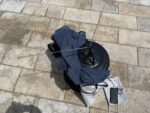

I am on holiday with my sister, Ray, and her partner Ben. When we check into our Airbnb the host, a women a little younger than our mother, apologies for our "bad luck" with the wet weather. We engage in pleasantries about how unpredictable the summer has been, and wet and warm the spring was. "We are not looking after Mother Earth", our host concludes. Her tone is serious. I think I detect fear, but cannot be sure. We say that "we do not mind", that "we will swim anyway", because "we are from the North".
2024-08-03 22:39:31
Soph Dyer
Lacknergasse, Wien, Austria
Austria
NOAA-18

Still, mild, mottled clouds. Clear air. By contrast, there is so much to write about the turbulent, changeable weather of last week. And, yet, I know some weather is ineffable or Unwetter. Together, Sasha, we altered each other. My hormones were so low (by chance) and I was grieving how my body will be changed by the coming operation. You tried to lower the waves of adrenaline and cortisol with empathy, touch and grounding words. It worked, to a point. We were what M Murphy, co-director of the Environmental Data Justice Lab, calls "endocrine participating" (Murphy 2024). Yet the estrogen and progesterone in my body refused to join in, staying stubbornly low, disturbing my sleep, making my recall foggy. You felt so steady and strong, but I know that you too were tired and running on empty. Our boundaries, dangerously porous. Yet, in clear breach of feminist protocol, we worked. We worked on this project: carefully dismantling and debugging 3D-printed prototypes, testing digital interfaces, and making logistical plans for when and how to send hardware to far away locations. We swam and drank too many Weißer Spritzers. You tried to order a doppelter Espresso but instead made-up the word "dooblé". We laughed, mixing caffeine with dopamine, oxytocin and endorphins. We laughed too when, during a beautifully intense dance performance, we saw ourselves in the two dancers' energetic, full-bodied exchange. On the way back from lunch, I quite literally fell over your feet, bloodied my knees, and sat wordlessly gulping for air on the pavement. The activities list I drew-up before your arrival is now half crossed-out. Hungry to share, you and I pushed each other, as always. Next time, I hope for fairer weather between us.
2024-08-02 22:55:42
Sasha Engelmann
Kottbusser damm, Berlin , Germany
Germany
NOAA-18



Berlin, Friday night, August. I peeked off the ledge of my friend Omid's fourth floor apartment on the Kottbusser damm, and set up my ground station looking East. The traffic 'rush' sounds below mingled with laughs, drunken conversation and sometimes yells or screams. I noticed how the antenna reacted to the side of the building, the almost-midnight radio environment, and to being hand-held - it preferred the balcony ledge. I had travelled all day by train from Vienna after an intense week of work with Soph, a week in which we ate market-fresh pickles, swam in the Danube, worked like crazy on open-weather, and sat together with pangs of uncertainty about the future, both immediate and further afield. From my midnight perch, I sent Soph a hug and some calm energies through the body-temperature air.
2024-07-26 19:58:20
Marlene Wagner and Soph Dyer
Seestadt, Wien, Austria
Austria
NOAA-19





Warm wind, residual heat. U-Bahn, aeroplanes, kids on the beach, gravel under our feet. Long shadows where the city meets the landscape.
2024-07-26 10:48:57
Sasha Engelmann
Hackney Downs, London, United Kingdom
United Kingdom
NOAA-19

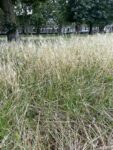

After another colder, misty and rainy day yesterday, and intermittent dark and gloomy clouds this week, it is a relief once again to feel some sun. The air is relatively calm, and a high altitude cirrus or haze makes the light a bit silvery. The ground is still moist in places, though elsewhere the grass has dried and turned a light beige. As I walked down the steps of my and T's house, a man on a bike, whose name I later learned is Duane, did a double take, then stopped and said he had seen me many times in Hackney Downs, and wanted to know about my Yagi antenna. We chatted briefly and, though he had to go toward Clapton, he said the next time he saw me in the Downs, he would come over and see what I was doing. We shook hands twice before parting. As I was leaving the Downs after the pass about twenty minutes later, an older man called out to me. He said he lived close to Hackney Downs and had seen me many times with the antenna, and now wanted an explanation. I showed the satellite image I had just live-decoded and he mentioned his own work as an artist. As his hands were trembling, he asked me to type in the open-weather website to the Notes on his phone.
2024-07-24 10:38:20
Soph Dyer
Danube Canal, Wien, Austria
Austria
NOAA-19



The sun went in and out flooding the lush foliage in a dramatic yellow light. I had run out of time to reach the park, so carried my bike down a flight of steps to the bank of the Danube Canal. To my right two, trees that I did not recognise bore seeds and globe shaped fruit. The uncut grass next to the water's edge was flush with wild flowers. Up stream, almost under a road bridge, a woman wearing a hippy paisley print vest was collecting something from the bank, slowly filling two plastic shopping bags. I assembled the antenna unhurried with the knowledge that in my sunken position the satellite would take need to be almost overhead before I could receive it. It's transmission arrived earlier than I expected but my phone crashed, corrupting the file and forcing me to restart the recording. Once done, I sat on the bank, listening to the satellite's rhythmic presence and enjoying the cool winds and waters of the Danube.
2024-07-22 19:33:19
Soph Dyer
Park bench, Lackerngasse, Wien, Austria
Austria
NOAA-15



What I thought was the beeping of a heart monitor was actually the beeps of a pedestrian crossing. I feel hollowed out. Heavy and exhausted, I sit on the street corner bench. I began the satellite pass stood next to the empty plot beside our house but moved because there was so much radio noise. It has become a mysterious fact that, since the block of flats that stood there was demolished last summer, the void has been filled with radio waves. I imagine live electrical cables buried under the compressed rubbled. Electric snakes hidden under shattered brick. This image has stopped me from venturing behind the flimsy construction site fence to pick wild flowers. A woman walking to beautifully glossy dogs stops to ask if I am listening for bats. For a moment, I wish that I was engaged in a short-range, in-situ sensing that could connect me more directly to the nature that surrounds me. Before the building was demolished there was a large bat population. No, I say, weather satellites. Man-made, metal birds, a thousand kilometres away. One of the three sisters in my building passes and asks what I am doing. I offer a less than satisfactory explanation as I have decided to rush to the nearby supermarket before it closes to buy a 'sports drink' in an attempt to replenish the electrolytes in my body.
2024-07-23 12:28:13
Sasha Engelmann
Tide Square, North Greenwich , United Kingdom
United Kingdom
NOAA-18





We woke up to dark skies again, but the air remained warm, humid. On my way to Southwark Bridge for a morning appointment it began to drizzle-rain and city-workers clutched their goose-bumped arms. Hours later I unfurled my antenna on the 'Tide River Walk' in North Greenwich, and almost immediately began to hear and receive an air traffic control downlink on a frequency overlapping with that of NOAA-18. A young man agreed to take some photos, and then went back to leaning on the railing, meditating on the water. Charli XCX's 'Brat' bounces through my headphones for most of the afternoon as I ride the overground and express mail some open-weather kit to Berlin. "When you're in the party b-b-bumpin' that beat / 666 with a princess streak..."
2024-07-22 11:37:21
Sasha Engelmann
Hackney Downs, London, United Kingdom
United Kingdom
NOAA-19



It is very windy today - the kind of surprising wind that gusts and blows in corridors. It was a struggle with my Yagi antenna, as it catches the air so easily, and at several points almost took me sideways with it. The tape measure joints swung at odd angles from the wood stick. An older woman and a small, white, curly haired dog were meandering nearby and I waved to say hi. We ended up speaking for most of the satellite pass. After considering my antenna for a few minutes she said: "the satisfaction... it gives satisfaction" and then "it's contact". I completely agreed.
2024-07-21 18:59:29
Sasha Engelmann
Hackney Downs, London, United Kingdom
United Kingdom
NOAA-15



I wake up having had a nightmare, but it is really a memory of a real event that was playing out in my dreams. In the memory, I am seeing one of my PhD students get publicly attacked by a senior professor (who is also someone I respect and in some ways depend on). I run through all the ways I could have acted differently in that moment. I visualise myself standing up in front of the room and hitting back. It plays and plays, until I manage to have breakfast. By lunchtime, though, I am lost in the flow of an article I'm trying to finish before holiday. As a visual contribution to the article, after lunch I experiment with making a satellite image (one that features a current of 'Saharan Dust' moving northward over the Mediterranean) into a 'thaumatrope': an analog, double sided, spinning device that creates an optical 'illusion' of blurred borders, animated shadows, and miscible surfaces. It feels good playing with a satellite image not on a digital screen (as I overwhelmingly do in open-weather) and rather in tactile, DIY form, using a tool that is reminiscent of children's games. For me, the thaumatrope creates a kind of optical 'irritation' of moving forms, nebulous shapes and shadows, and disappearing or fading-out land and sea edges. It also seems to 'agitate' the cartographic orientation devices that we use when we see the coastline of North Africa and the 'boot' of Italy. Writing of images of the monsoon, Harshavardhan Bhat writes, "Satellite images empowered by spectroradiometer science and international coalitions begin to not just inform the science of the state but the imaginary that the monsoon unifies the entity called South Asia as part of a planetary system... This is a gift to political theory as the monsoon then becomes this technology through which the planetary infrastructure of surveillance and governance slowly unfold, silencing the complex work of the air of the monsoon" (2022: 240). Does the thaumatrope help to destabilise the 'unified entity' of the Scirocco or Jugo wind that brings 'Saharan Dust' to Europe? Does seeing a satellite image flicker and blur between channels demonstrate something about the 'slippages' of materials and elements in satellite imagery, inviting us to see beyond the 'optical ontology of pixels'? In contrast to a regional 'event', can we recognise something about the 'complex work of the air'?
2024-07-20 21:11:38
Soph Dyer
Postsportverein, Wien, Austria
Austria
NOAA-19


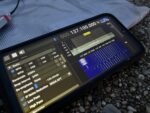
A welcome overcast day with light rain. Inexplicably, I heard air traffic control on the same frequency as the satellite NOAA-19. I was sitting on the concrete bleachers of the local sports ground, beneath a GSM mast for mobile (cellular) phones, but I cannot think think that could have had an effect. The transmission seemed too strong to be a harmonic. Decreasing the bandwidth to exclude the noise worked well. I feel lethargic.
2024-07-19 11:37:22
Sasha Engelmann
Hackney Downs, London, United Kingdom
United Kingdom
NOAA-18



It was too hot to be in the sun so I perched on the edge of a pool of shade made by a plane tree. A man in a track suit who is a kind of local figure in the neighbourhood - often seen balancing on post boxes, tall gates and bus benches doing dance moves that resemble Tai Chi, always in a full track suit - walked by, waved and said 'So I expect you're listening to the Gods??' 'Yes sort of!' I replied, hoping he would understand I was joking. 'Nice one!' he replied, and then followed with "I like your glasses!!!'. 'Thanks!' I said, and remembered how I had gotten my sunglasses at the 'Accessorize' shop in Kings Cross station while waiting for a train a few summers ago. Another man in a neat vest, jeans and glasses approached me a few minutes later and quietly asked what I was tracking. After I replied, he exclaimed 'And I thought I had an interesting job!!' 'What's your job?' I asked. He said 'Oh I park cars... BMWs... train driver too'. He went on his way.
2024-07-19 12:35:34
Soph Dyer
Augarten, Austria
Austria
NOAA-18



Blue sky, hot. The city is heating up again. Yet the park, usually busy on such days, is quiet. Presumably many residents are already on holiday. Summer holidays are taken seriously in Vienna. Its shops and restaurants can shut completely, sometimes for more than a month, only reopening in September. This ritual of city life and work grinding to a halt in high summer as people take in long holidays, is a side of Austrian culture that is, perhaps, less well know and more associated with our hotter neighbour, Italy. I hide the ground station's hardware under the shade of a plant, and limit my time in the sun by leaving as soon as the satellite pass is over. I am tried and a little nauseous today, but in the openness of the park these feelings are less.
2024-07-18 11:51:41
Sasha Engelmann
Hackney Downs, London, United Kingdom
United Kingdom
NOAA-18
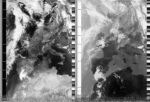

I've spent all day writing, and my thoughts are swirling around ideas of memory, wind, history, and the way wind makes 'traces' and 'marks' in satellite imagery. The article I'm editing feels to have its own weather too, one of 'rabid gales', blue vanishings, wind-blown dust, 'pigments and mist' and vast differentials in temperature and pressure, pulling air into all sorts of space and corners.
2024-07-17 10:58:28
Sasha Engelmann
Founder's Field, Royal Holloway University of London, United Kingdom
United Kingdom
NOAA-19
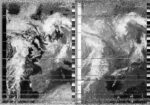

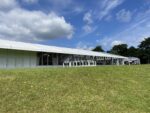

In the field that has been turned in to a parking lot for university graduation services, I link up my v-dipole, dongle and android. A maintenance man or security guard sitting in a blue van looks on with a bemused expression, but mostly he ignores me and talks on the phone. The air is warm for the first time in weeks and it is such a relief from the cold, rainy, at times torrential rain we have had in the U.K. Later in the afternoon I show my satellite image to SB, a physical geographer who specialises in studying past climates through tephra (volcanic ash). He points to the wavy line of the increasingly wobbly jet stream and explains how, with the poles warming faster than the equator, the difference in temperature and pressure that stabilises weather and holds the jet stream north is decreasing, causing the jet stream to curve and bend south more and more, bringing moisture laden air from the Atlantic to Northern Europe - this describes our recent weather experiences. Now that I’ve seen the curve of the jet stream with SB’s help I want to look back to all of the past imagery and try to spot it. Meanwhile, he says, ‘anywhere below 40 degrees (latitude) is burning’. Soph is just back from holiday and describes a level of heat in Croatia over the last week that was at the limit of their physical health. It doesn’t take much for heat to stress London- on my tube journey home, the air is so stifling that people are visibly haggard, some using makeshift fans and others flushed read and eyes closed, waiting for their train.
2024-07-16 12:15:09
Sasha Engelmann
Hackney Downs, London, United Kingdom
United Kingdom
NOAA-18


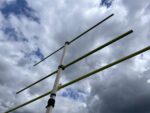
It poured last night, the kind of rain that quickly overwhelmed London's drainage system and caused pond-sized puddles on street corners and walkways. Somewhat fittingly, T and I were drenched in it while cycling home from a 'psychoanalysis and climate disaster' seminar at a pub in Finsbury Park. The conversation had been circuitous, and the speaker, a Lacanian psychoanalyst, had shared her research about the shift toward spiritual activism and intentional communities in Portugal testing different forms of spirit-informed collectivity. She kept saying that this research, or the research materials themselves, were 'embarrassing'. This was raised in the discussion- what is the root of our embarrassment when we talk about somatic practices or dance forms that give us more awareness of each other, or spiritual practices that give us room for wonder? Someone raised a theory from a source I can't remember that the earth has created beings with fully self-conscious brains - capacities to be embarrassed - in order to self-destruct on a planetary level. No reference was made to the many forms of human awareness and community that have not self-destructed, that are still trying to prevent destruction. I felt uncomfortable raising this point in the midst of so many unfamiliar, intimidating people, and because who am I, a white academic, to be the one to say 'aren't we forgetting indigenous lifeways and laws' when we theorise self-conscious self-destruction? I was reflecting on this during my satellite pass today. In the middle of it, two tall men in black t-shirts and knee-length shorts walked across the field staring at me so I smiled and waved. They came over and started asking questions. I was sitting on the grass holding my antenna upright and listening to the sound of the satellite on my Android phone. They approached very near but stayed standing, so I had to look vertically upward to see their faces. Their tall, looming shapes were outlined against the bright, cloudy sky. As I explained the tape measure Yagi and the passing satellite, one said, 'So are you an artist?' I keep wondering what sparks this question, as I have received it repeatedly over the last six months. Is it the fact that I use the word 'DIY'? Is it that I don't look like the type of person who is doing research or science?
2024-07-15 12:25:50
Sasha Engelmann
Hackney Downs, London, United Kingdom
United Kingdom
NOAA-18


Low-hanging, medium-grey cloud with a light drizzle that grew into light rain as I knelt on the grass. The sound of a car-sized grass mower in the distance. Damp ground. Despite the un-summerlike conditions, the park was full of primary school children running races and exercising. As soon as one group saw me and came over to ask what I was doing, I became a magnet for others. One girl asked if I was 'traveling the world... with that thing [pointing to the antenna]?' I said in some ways, I was, but also, I was just listening to the world. Another small girl simply picked up my antenna and raised it to the sky, winking slyly at her friends, while the accompanying adult said 'you should ask first!'. But I appreciated their forwardness. As they huddled around, I showed them the growing satellite image and pointed to different countries so they could try identifying them. The answer was 'I don't know... ' until it turned out they did know. Among the parents or chaperones, several asked further questions and wanted to know how to follow the project. I had to hurry to pack up in between two waves of visitors to avoid disappointing anyone.
2024-07-14 12:40:13
Sasha Engelmann
Hackney Downs, London, United Kingdom
United Kingdom
NOAA-18




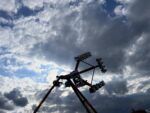
In 1989, Derek Jarman wrote of a day in July: "Lazy high summer. The drowsy bees fall over each other in the scarlet poppies, which shed their petals by noon. Meadow browns and gatekeepers flutter wearily across the shell-pink brambles disputing the nectar with a fast bright tortoiseshell. The bees clamber hungrily up the sour green woodsage. Drifts of mauve rosebay and deep yellow ragwort studded with orange and black burnt caterpillars" (Jarman, 1991: 107). This morning I read an article in the Guardian about the rate and long-term advancement of mass insect death. Based on research on the number of insects killed on the number plates of cars, the study says we have 90% fewer insects in the UK today than we did 100 years ago. During the satellite pass at midday, I note how the recently cut grass of the park has given way to a low layer of clover and dandelions, and how bees fly between the clover, only a couple centimetres above the grass, sometimes bumping into each other and weaving between the higher leaves of grass. Other than the random lazy fly, I don't see any other pollinators. Butterfly populations are especially affected this year, apparently, in part due to the very wet spring-summer that has washed out many of their homes. Derek was already aware of the changing climate in 1989, as he sometimes mentions the warming air and the 'hole in the ozone layer'. I wonder if he knew about mass insect death, though from his descriptions of the cottage garden in Dungeness, he was seemingly at home with a kaleidoscope of insect companions.
2024-07-13 12:52:06
Sasha Engelmann
Hackney Downs, London, United Kingdom
United Kingdom
NOAA-18


Grey, clouded, though lighter than yesterday. I noticed a thin, middle-aged man sat on a bench was watching me with my Yagi antenna. When I set my antenna down at the end of the pass, he walked over. He started with 'Just checking... you were tracking UFOs with that thing?'. I smiled and waved my hand in a 'sort of' gesture. As he turned to walk away I said 'I'm happy to show you what I've got?' and he veered back and sat on the grass near my laptop. We looked at the satellite image together. I pointed at the outlines of France, Spain and North Africa. He exclaimed 'Oh yeah, you're into weather!!' and he added 'I'm into weather too, always have been!'. 'How come?' I asked. He replied 'You can spell Rain, Cloud and Sun with my name... also Oak, Acorn... all the elements!' 'What's your name?' I asked. He replied 'Frances S ...' and a last name that I don't recall that begins with a 'K'. 'All the elements, then!' we laughed. He said 'Well keep lookin out for those UFOs' and I replied 'If I listen to any, I'll let you know!' And off he went, walking fast, south into the park. As I packed up I heard him yell to a man on a bike 'EH!! you have a GOOD DAY!!' As I walked home I thought about which elements I could spell with my name. By counting my middle name (Hildegard) I came up with 'shade', 'shine' 'hail' and 'snail'...
2024-07-12 10:20:14
Sasha Engelmann
Hackney Downs Funfair, London, United Kingdom
United Kingdom
NOAA-19
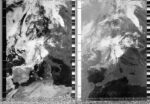


Low-pressing grey again. A feeling of melancholy. I'm missing Soph's presence on zoom calls and text channels. I go searching for the funfair in the northwest corner of the park. It has not yet been activated, but I can see people walking around inside, checking and testing things. I capture a satellite image with my Yagi antenna and Android phone, kneeling in the yellow grass. After the pass, I circle the perimeter of the fair, and notice that there is a line of trailer vans and mobile homes on the far side, facing the overground train tracks. Laundry is flung on the metal fence that divides the funfair from the park, or on small drying racks set up outside semi-ajar car doors. I hear a man speaking at an elevated volume on the phone. He says something like 'I thought I had 2 points! where are my points!' I realise, then, that the funfair is an entirely mobile operation: all the big machines are transported on two very large, glossy red trucks, but the real 'infrastructure' are the staff who likely follow in their vans and mobile homes. I wonder how many places they go. As I walk back to Downs Road I pass a couple walking their greyhound. As I pass I can hear the woman say to her partner 'Oh yes that's the lady with the...'
2024-07-11 11:35:36
Sasha Engelmann
Hackney Downs, London, United Kingdom
United Kingdom
NOAA-18



As we lift the blinds in the morning, T says 'what does it mean if the sky is blue!? I don't remember...' and we laugh at the fact that we have not seen a sliver of blue for what seems like weeks in the middle of the UK summer. A funfair is being constructed in Hackney Downs: the rides, swings and other contraptions make silhouettes against the blue on one side of the park. A man comes over to speak to me during the satellite pass, and comments 'you know I see people doing all kinds of things in the park - sitting, walking, like them [motions in the distance] but I never seen this!'. Later in the day, as we are cycling home from a pub on Columbia Road, the black outlines of the funfair machines, resting silently in the park, remind us of a horror film.
2024-07-10 12:25:14
Sasha Engelmann
Hackney Downs, London, United Kingdom
United Kingdom
NOAA-19

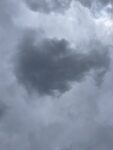

It is a grey, energy-less, dark-clouded day. My thoughts, however, are with the pale blue skies, swift winds and coastal swamplands of Buenos Aires as I re-read my field notes written during the month of fieldwork I carried out there last spring. As I make my way through my fast cursive handwriting, sometimes having to puzzle at words, I remember how breathlessly I wrote these notes, trying to record and remember everything. It mostly works. As I close-read, I am transported visually and sensually to Villa Inflamable, the community close to the centre of Buenos Aires that is the site of the research I am doing with a team of collaborators in Argentina. My colleague / friend Joaquin had taken me to VI after a morning spent on the rooftop of my other collaborator, Debora, eating pancakes and experimenting with radio antennas. There was not a speck or glimmer of cloud in the sky- and it was a wide open horizon. It took Joaquin and I only 12 minutes to drive from Debora's house to VI. My field notes read: "We arrived in the midst of heavy vehicle traffic - large tank trucks, mostly with Shell on them, entering and leaving the petrochemical facility. We passed to the right of a large sand dune - a sand production facility- there were thick clouds of dust in the air". From the open clarity of Debora's rooftop, it was a different experience being on the ground in VI. We walked around the neighbourhood with Claudio Espinola, a long-term activist and organiser in the community who also helps to ration water to families (the 'running' water is undrinkable, so families get a number of bottles of water per week). VI, like much of Buenos Aires, is on marshland, and we passed many pools of water and algae-covered ponds. The streets had been recently paved, but this had caused water-runoff problems and a man in a car told us he would prefer the dirt road if the sewage would not flood the streets. Later, as Joaquin and I left Claudia and made our way to an air quality monitoring station not far from the community, "We passed a plant that Joaquin suspects is where they began burning medical waste during the pandemic. It looked very old and dilapidated. Joaquin suspects that environmental regulations were relaxed during the pandemic to enable the repurposing of these kinds of incinerators. We also passed a smaller river - maybe 20m wide - that looked like slow-moving cement. There was on oil slick on top. Claudia had compared the river to cement too". I thought about who made the decision to start burning medical waste in an out-of-order incinerator in an already impoverished and environmentally stressed community like VI. I thought about what it takes to turn a river into cement. I also thought about the divergences in the experiences of people in this community and those only a few blocks away, somewhat sheltered from the 'weather' of the petrochemical facility. I thought about the 'weather' of Villa Inflamable, the weather of flammable. In a recent article on perceptions of air in Mumbai, two scholars write: "For the state, flammability is the result of the residents themselves. It is them, and their forms of work, that create fire risks, and so it is they who need to be removed. Residents, on the other hand, attribute causality to the gases that the garbage ecology itself produces. They are acutely aware of how the state has aligned blame in an opportunistic way with them rather than the material hazards of place, poverty and labor" (Tripathy and McFarlane, 2022: 12). From my fieldnotes alone (and without any experience of living in VI) the causality of the environmental toxicity in the neighbourhood is shockingly clear, yet my colleague Debora has written extensively of the 'labour of confusion' produced when residents of VI are told their environment isn't so toxic, or that nothing can be done about it. This is about perception indeed, and it is about whose perceptions are taken to mean 'truth' or 'causality' and whose are seen to trouble the order of things. I spend most of the day co-writing a draft chapter with Debora, returning in my memory to VI, trying to articulate in words the causalities and breathing relations at work there.
2024-07-09 12:01:53
Sasha Engelmann
Hackney Downs, London, United Kingdom
United Kingdom
NOAA-18



The gloomy weather in London persists. Yesterday, upon return home from the Isle of Wight, T and I joked that it felt like the summer was already over- our holiday had lasted two days, and now it is October again. It feels surreal to think that we still have some time in the Adriatic planned for later in the summer. It feels surreal to think of a 'normal' summer at all, at this point. I spend the morning organising open-weather finances in the university finance system called, fittingly, 'Agresso'. I manage to extricate myself from Agresso to go outside for a satellite pass- finding a slow, languid drizzle. Under a tree in the east-side of the park, my Yagi struggles to pick up the signal in the beginning of the pass, as if even the radio spectrum is sluggish, radio waves moving slower than the speed of light through this water-logged air.
2024-07-08 12:50:43
Sasha Engelmann
Ferry from Ryde to Portsmouth, The Solent Channel, United Kingdom
United Kingdom
NOAA-19





We made the 12:45 ferry to Portsmouth with one minute to spare, and opted for the 'sun deck' despite the total absence of sunlight. The deck felt more inviting than the humid, dark interior of the boat with airplane-like seats and sullen-looking people. We ate cheese and pickle sandwiches that neither of us liked very much. A NOAA-19 pass began just three minutes after the boat's departure. Though the maximum elevation was only 18 degrees to the west, I decided to try anyway, having never received a satellite image while moving in water! It worked far better than anticipated- I curled the legs of the V dipole antenna tripod around the metal railing, and a few minutes later the signal was ringing-in clearly. I wondered how my trajectory on the boat was affecting the image reception, if at all. A young man who had also come up to the deck asked if he could take a photo of me with his analogue film camera. He had travelled to the Isle of Wight for the weekend to 'see the stars'. Yet he also admitted to being 'very out of it' and having had 'little sleep'. He lamented the rise of Starlink and the other ways we are 'ruining the planet', and didn't say much more. When we approached the port, the clearly audible signal of NOAA-19 cut out sharply for a few seconds, so much so that I briefly wondered whether the satellite had stopped transmitting or glitched for these seconds. My experience of noise is normally a little 'softer', more like a gradient than a cut.
2024-07-07 12:31:03
Sasha Engelmann
Buddle Inn, Niton Undercliff, Niton, Isle of Wight, United Kingdom
United Kingdom
NOAA-18





Crawww crawwww the crows spoke as they lifted and tumbled off their roosts along the cliff edge and fell into the strong westerly wind as if it was a blanket, finding shape as a flock seconds later. T and I were several hours in to a hike along the coastal path of the Isle of Wight and the silvery sea was shadowed by elaborate fast moving clouds. The weather forecast had predicted rain and yet we were in the sun most of the day. Our shoes and hands were speckled with the chalk that is characteristic of the island, and our legs happily tired. We learned about the local footpaths and the 'right to roam' across farmland. We also learned about the nettle and bracken that tower several metres high at points along the coastal edge, and send spikes into our ears and our shoes. We learned about some of the locals, too. Earlier in the afternoon, as we paused along the edge of a road to discuss our route, an older man tending a garden asked where we were from and if we needed help. We said we were from London. He said 'no your not!' so we had to explain further. The previous day, in the toilets of a seaside cafe, a bride-to-be looked at T and cried out very loudly and mockingly - 'are you a BOY or a GIRL??!' T found it funny. I ran through angry retaliations in my head for several minutes, then let it go. Back at the cliff, we lay in the tall grass as the crows swirled around us and T did some deep listening. I told T that I felt like falling off the cliff, it felt so tempting to follow the crows.
2024-07-05 12:56:19
Sasha Engelmann
Hackney Downs, London, United Kingdom
United Kingdom
NOAA-18



Last night on BBC weather, the presenter kept comparing current temperatures in the UK to what they 'should be' this time of year. The general trend was toward colder, wetter weather across England, Wales and Scotland. London's average in the first week of July is normally somewhere around 24 degrees C apparently, and it is currently rainy and dark, with a high of 18. As he reported this, the presenter even seemed a bit embarrassed, as if it was an awkward secret he was revealing. I met Muffin Man and a new miniature-Pomeranian rescue, Moonpie, out on the downs in the morning. When I went back out in the early afternoon, a very large, triangular rain cloud approached my ground station from the southwest side of the park, and fat drops began to fall on my antenna. They seemed unusually pendulous. I wondered whether warmer temperatures and the current humid conditions mean that drops grow larger before they fall.
2024-07-04 10:18:03
Sasha Engelmann
Hackney Downs, London, United Kingdom
United Kingdom
NOAA-19

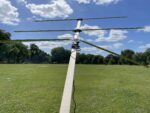
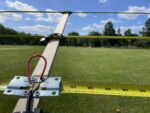
Finally the grey has passed and a crisp wind has blown away most of the low-hanging, misty clouds. The air has a sharp chill, but one that will fade soon, I suspect. I am reminded of Derek Jarman's weather note on June 4th 1989 (from his diaristic book Modern Nature) which, though clearly of another time, place and month, describes today's weather perfectly: "The billowing white flowers along the shore are gone; but the mountainous white clouds in the blue sky and the horses breaking across a silvery sea cheer their memory to the echo. Today wind and sunlight fill the landscape with laughter. An old window opened in the wind and sent the cobwebs flying. The grasses are clapping - even the seagulls loop the loop".
2024-07-03 10:29:29
Sasha Engelmann
Hackney Downs, London, United Kingdom
United Kingdom
NOAA-19



It is another grey, misty and cold-ish day in London. I spend the morning working and take a brief break to capture a satellite image. A curly haired black dog tackles me and rolls around on my laptop as I am mid-pass. His owner looks mortified but as soon as I say it's not a big deal he becomes interested in my antenna, and it turns out he used to be an engineer, working with Radar. We don't speak long. Later in the afternoon, I see the weather from the seventieth floor of the Shard (a sneaky birthday-week adventure with T, who has wanted to go to the top of the Shard for years but is always too anxious of the elevators). We rise sixty floors in what feels like five seconds, our ears popping. At the top, T and I carefully approach the knife-edge, holding on to the metal beams for reassurance. After a few minutes, though, we have our foreheads pressed against the glass gazing in every direction. A stranger offers to take photos of us. Though the view might be more stunning on a sunny day, the changeable clouds and shifting rain are spectacular, and we try to time how long a rainy cloud takes to pass over London. It sort of dissolves rather than making it the whole way. There are only a few other people, and so plenty of space to circle all edges and study all perspectives. Descending, we go on a hunt for an ivy-coloured wall on an old building at Kings College that we could see hidden a few blocks away from St Thomas' street. Once we find the wall, we spend a few minutes admiring the density of the ivy, its even spread and growth over red brick, nearly engulfing the entire building.
2024-07-02 10:41:06
Sasha Engelmann
Hackney Downs, London, United Kingdom
United Kingdom
NOAA-19

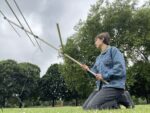

The day starts cold, gray and misty. During the satellite pass, I feel chilly in my Mom's flannel-lined denim jacket, jeans and boots. How is this the second of July, I think. In the slow-loading satellite image, the sun glints tantalisingly, catching its own reflection over the Mediterranean. I am wondering where Soph is at the moment, as they left for a two-week holiday on Sunday. I think somewhere in Croatia, soaking up sunrays and salty air. Thinking about it makes my heart hurt, both with happiness that Soph is there on holiday, but also with a feeling of deeply missing the Adriatic and especially the small bay called Zaraca, near the village Gdinj where my Baba grew up on a remote part of the island of Hvar. Is it possible to miss an atmosphere, or a weather pattern? Is it possible to be nostalgic for places, less through their material surfaces and more through their elements? Having spent so many long summers in Zaraca as a child, having climbed the windy road that goes from the bay to the sparsely populated village Gdinj, with its fig trees and olive groves, with its tunnel spiders catching impossible flecks of dew in the dry landscape and epic cumulonimbus clouds dancing over the Karst rock of the mainland, and wtih its slantwise sunlight that remains until the last drop (since the road climbs on a south-facing slope) I feel so entwined with this weather. It is perhaps easy to say on a day like this in London, as I shiver through my trousers in the first week of July. Yet I think there is something beyond the beauty of Hvar and the Adriatic Sea that I am missing so much. Maybe it's a direction I will always turn.
2024-07-01 10:57:13
Sasha Engelmann
Meadow near the Biological Sciences Bee Apiary, Royal Holloway University of London , United Kingdom
United Kingdom
NOAA-19



Bees, flies, ladybugs and other insects buzzed around my ground station, located near to the Biological Sciences bee apiary in a meadow on the campus of Royal Holloway. One long-winged fly, looking like a cross between a grasshopper and a moth, landed on my keyboard. Purple-pink cornflowers and daisies bloomed abundantly in the uncut grass. I remembered Jaime Sebastians' story that he had recorded the sound of a NOAA satellite together with the chirping of crickets or cicadas, and he could 'see' the chirrups in the resulting image. I resolved to return to the apiary one day and attempt a recording of both an orbiting satellite and honeybees.
2024-06-30 18:05:38
Sasha Engelmann
Hackney Downs, London, United Kingdom
United Kingdom
NOAA-15



'So humid' proclaims T as we walk to Hackney Central to catch the overground to Stratford on a rare trip to the Westfield Mall. The air is misty with a light rain, though it is just as warm as it has been under bright sun for the last week or so. On the overground, two Moms are taking a large group of young boys paintballing. We arrive at the Mall hoping to be early enough to evade most crowds, but we find we are not the only people waiting for the Adidas store to open at noon. As soon as the metal gates have been pulled back, throngs of people enter, and it is almost impossible to locate and calmly try on shoes. We persevere in JD, Footlocker and Office before both me and T begin to feel physically unwell from the press of the crowds, the 'hall of mirrors' that is every sports apparel store, the stress of finding our way around, and the ultra loud grime tracks that are booming from every corner (though some lyrics have clearly been redacted for children's ears). We flee after no more than 45 minutes and head home, shoeless.
2024-06-29 12:27:48
Sasha Engelmann
West Hackney Recreation Ground, United Kingdom
United Kingdom
NOAA-18



Dalila and I were relaxing on the grass of the garden around the corner from the Stoke Newington Farmer's Market (while I held up my V-Dipole antenna to casually capture a NOAA 18 pass) when a tall man suddenly interrupted us, asking what I was tracking. Within seconds he had laid himself down on the grass between me and D, head towards my laptop, and was asking a flurry of questions. I appreciated his curiosity, but the way he had just placed his body in the middle of our private conversation was annoying. It transpired that he was an academic in the sciences, though I can't remember the exact field, employed by Queen Mary University. When I mentioned later in the conversation that I work at Royal Holloway, he immediately asked "And you live in East London? Why don't you work at Queen Mary?!". I said I would love to have the option of a job at Queen Mary, things weren't that simple! Another tall man came over a few minutes later and asked similar questions, while the first one loaded the open-weather website on his smartphone. Yet as soon as he read the blurb, he exclaimed to his friend "Oh this is not for us... it's a 'feminist experiment'....". I replied actually, it was exactly for them. "I'll have to tie my hair back" said the first man. The second seemed to understand what I had said and backed me up. But at this point my feeling in speaking to them had completely changed- they had now separated me and D, and taken up a long stretch of time, while making remarks like the above. I decided to close my laptop.
2024-06-30 11:34:24
Soph Dyer
Hanging out of the window, sun on my face, Austria
Austria
NOAA-18



I woke relieved to see a cloudy sky and even a few drops of rain. By eleven o'clock the sky had mostly cleared and the temperature is rising again. I feel the heat on my face as I lean out of the window to receive this image. My left arm turned to jelly as I tried to maintain the pose, thrusting my antenna as far East as possible. The Kestrels nesting in the building across the street made frequent alarm calls. Two flying ants danced around the stone work below me. It's Sunday, but N and I leave for Split by train tonight, so I am working a funding application.
Sasha, I know that my contributions have been inconsistent recently. The pain I have weathered for the last year has surely left it's mark. It is 37 days until the operation.
2024-06-28 09:06:47
Sasha Engelmann
Hackney Downs, London, United Kingdom
United Kingdom
NOAA-15


Last night I finished 'The Well of Loneliness' by Radclyffe Hall, first published (and then banned because of its lesbian content) in the UK in 1928. It follows the life of Stephen Gordon, a woman from a rich family who, in the words of the time, demonstrates "sexual inversion" from an early age. Her life story moves from the rejection of her mother and expulsion from her home in the English Countryside, to driving an ambulance in World War II, to moving to Paris where she can live a little more openly with her partner Mary. To find places where they can be and dance in public, Stephen and Mary visit 'the bars' in Paris where queer people can go without fear of prosecution, yet these places are also full of despair, substance abuse and sadness. At the end of the book, and though it breaks her heart, Stephen pushes Mary away from her, as she sees that Mary could have the possibility of a 'normal' life with a man called Martin. In the last few lines of the book, Stephen, in anguish, pleads to God: "give us also the right to our existence!".
I think of how much has changed in the 100 years since the publication of The Well. I can live together with T, I can live an openly queer life, and I can freely access and read this book. Yet the 'pull' of 'normal' has not lost its strength. Society's 'straightening devices' work in new and different ways today, but they still work. Living obliquely or 'slantwise' requires unusual and surprising effort at times. And in an even odder development, queer identities and politics are now being used to 'pinkwash' the actions of corporations or governments committing acts of violence. In many ways, and in Ahmed's terms, society today might be oriented 'to' different things on the surface, but in many ways it is still oriented 'around' the same 'straightening' logic.
2024-06-28 12:01:02
Soph Dyer
In the heat of Augarten, Austria
Austria
NOAA-18



As I write this weather note there is a warm wind and the temperature has dropped. In the park, I could see large cloud to my West. It might have been a cumulonimbus but its top was cirrus-like and its shape not well defined. The heat is waking me early. This morning instead of rising, I read the news in bed. President Biden has performed poorly in a debate about Trump, unnerving even his allies. The American Democratic Party is panicking. If the situation wasn't so terrifying, it would be funny. Writing this note is taking longer that is should as I feel so drowsy. I have drunk a mate tea to wake-up, however it seems to be having opposite effect. The wind has dropped and the sun is shining again. I could fall asleep at my desk.
2024-06-27 20:55:10
Soph Dyer
Sitting on the window ledge, Austria
Austria
NOAA-19

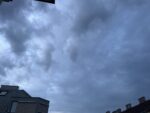

It's a warm evening and the street is loud. Starlings, children, adults shouting, car tyres screeching. The humidity has felt oppressive. As I recorded the image the sky was clouding over. The clouds are dramatic, they look high defintion and high contrast. They are moving quickly. I felt one large drop of rain on my way home, but that's it so far.
2024-06-27 09:35:31
Sasha Engelmann
Between Queens and Schilling Buildings, Royal Holloway University of London, United Kingdom
United Kingdom
NOAA-15




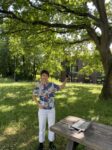
I awoke this morning not having slept because of the heat. T and I had left the bedroom and living room windows open but there was little breeze. In the middle of the night, the bedroom blinds started knocking against the window and I dreamed someone was trying to get in. Foxes screamed (or intensely rejoiced?) at 3am in the garden. In Waterloo station at 7:30am, an old, bearded, probably homeless man stood still with his eyes closed in the middle of the river of city commuters emerging from the tube and walking to the train platforms. I had to cross the current by hopping a few feet at a time through moving bodies in order to speak to him. He had an American accent but I shied away from asking about his origins. He didn't open his eyes when he spoke. By the time I bought him a coffee, he had got another one from someone else. We joked about the double coffee situation before I re-entered the commuter river. When I left he had opened his eyes, gazing straight ahead.
2024-06-26 11:22:27
Sasha Engelmann
Hackney Downs, London, United Kingdom
United Kingdom
NOAA-18


It's a hot, hot, hot day in London. People are bravely tanning on the grass in the park, though I imagine some might be roasting. The moment T and I wake up, we open all the windows in our second floor flat. T says, 'we need a storm'. I had brought out my turnstile antenna because, based on yesterday's image, I wondered if there might be more dust over the Mediterranean, and as the NOAA-18 pass was relatively low elevation (35 degrees to the East) I guessed I would see 'farther' than with my DIY yagi. Was Soph already 'seeing the dust', I wondered? As the pass got started, Nutmeg appeared suddenly, circling my ground station, and I turned around to see Bill and a woman walking toward me. Katherine had been briefed by Bill on my satellite ground station and open-weather, and complemented the project. We agreed that, 'you meet all sorts in this park' and 'you learn so much from chatting to people'. I mentioned my interest in seeing the dust, and Bill asked how many tons of dust actually travel in the air? Millions or trillions of tons? He spoke about an analysis he had seen about how long it takes mountains to erode into the rivers and the sea, and explained how scientists had measured weathering down the Colorado River by stringing a kind of line across it and taking many disparate measurements over time (I think). The takeaway was that it will take many millions of years for the mountains to return to the sea, but it will happen eventually! Bill asked whether my laptop was overheating, and I knelt down to hear the internal fan whirring at a high rate.They stayed a few more minutes before Bill said he needed to take Nutmeg to the shade. Later, remembering Bill's questions about dust, I read that "The Sahara is the largest source of aeolian dust in the world, with annual production rates of about 400-700 x 10^6 tons/year, which is almost half of all aeolian desert inputs to the ocean" (Wikipedia). That's 400,000,000 tons of dust per year. I wonder how much is airborne in any given 'dust' event. Or, phrase differently, how much air suspends the dust?
2024-06-25 11:37:32
Sasha Engelmann
Hackney Downs, London, United Kingdom
United Kingdom
NOAA-18



Today has been sunny and bright, but I've been fighting a sharp headache: taking pain killers, taking breaks and moving slowly, but nothing has worked. The one thing that might 'work' is to stop working. Hence why my weather note ends here.
2024-06-24 18:56:11
Sasha Engelmann
Hackney Downs, London, United Kingdom
United Kingdom
NOAA-15


Hackney Downs was golden and glowing this evening, as the city held on to its heat. My arms and shins throbbed slightly from a fast cycle ride from Bloomsbury. I thought about my meeting with J earlier today. We had sat in Russell Square on an uncomfortable metal table, discussing place-based weather knowledges, hierarchies in academia, performance journals and practitioners, and a possible open-weather automatic ground station in Western Australia. J mentioned many collaborators, institutions and places who I imagined with fictional appearances and atmospheres. As I recorded the satellite pass, reflecting on the possible station in Australia, two people came over to speak to me. They appreciated the measuring tape. Their names were Alex and Tamsin, and Alex kindly took the attached photo (thanks Alex!).
2024-06-23 12:02:01
Sasha Engelmann
St Patrick's Catholic Cemetary, United Kingdom
United Kingdom
NOAA-18




On my way to meet H at Leytonstone Library to see Graeme Miller's radio-borne sound work about the M11 link road, I stopped for a satellite pass at St Patrick's Catholic Cemetary. I had wanted to visit this cemetary for a long time, as it is situated on the prime meridian, 0.000 Longitude. Signs ringed the cemetary suggesting activities were heavily regulated - 'No Exercising or Picnics' 'Cemetary Open For Viewing Graves Only' and one sign that said the cemetary was regularly spraid with toxic chemicals for weeds, and people should wash hands after visiting. I initially put off the thought of collecting a satellite image until I had walked into the cemetary and found a quiet place to sit and reflect. I carefully unfurled my radio antenna. I thought of what I would say if someone asked me what I was doing- 'I'm doing a kind of ritual' or 'I'm just listening' or 'I'm performing a seance, I do this at cemetaries '. Though I am not religious, I said a small prayer to request access to the radio spectrum from the cemetary's residents. An hour later, walking a twisting route along the M11 road and holding radio receivers to the sky, the voices of people whose houses had been demolished to make way for the road emerged and disappeared in radio static. H and I learned the story of a woman who loved a five hundred year old Mulberry Tree that was still standing today, though instead of a communal garden, it is now in a Tesco car park. We heard other stories of older people who had to move out of their houses of forty years, and didn't know where they could go. 'Lonely' was repeated by several voices. The M11 road made a constant background hum, an incessant current of noise alongside our attempt to listen.
2024-06-22 11:03:52
Sasha Engelmann
Hackney Downs, London, United Kingdom
United Kingdom
NOAA-19




At the Restore Nature Now march in London today, signs read, 'To Bee or Not to Bee', 'Hey Kier OR Rishi! Bee Radical for Nature!', 'UK Arms Sales Destroy Life and Environment', 'Protect Essex Badgers!' 'I Just Really Like Bugs', 'SOIL not OIL', and 'No Justice, No Peas' (accompanied by a drawing of wailing peas). As the march wound South toward Piccadilly Circus, a burst of cheering led my partner and I to cross to the other side of the current of marching bodies, where we found a 'Dyke March' going in the opposite direction on the other side of the road. Their signs read 'Choose Butch. Choose Femme. Choose a Big Fucking Lesbian', 'Lesbianism is not a choice, it is a Blessing!', 'Dykes Against Occupation', 'Whose got a Wand and a Rabbit?', and 'Dykes For Trans Rights!'. Our allegiance to the XR march was seriously challenged! T said 'OMG, there's Stav B!', (legendary artist and performer who used to host underground nights for queer womxn in east London). We barely resisted jumping the street barrier and carried on in the Restore Nature Now crowd. An couple hours later, after meeting one of my old College friends in a pub near the Thames, we found ourselves on the southside of the river at Southbank Centre, where we stumbled upon a stage where people were gathering for a set of acts on the theme 'Queer C*ntry', part of Chaka Khan's curation of Meltdown Festival. There were just as many cowboy hats as dolly parton wigs. Two older men, dressed in matching pinstripe shirts and blue jeans, out-danced many of the gays. A day like this, of so many frequencies, actions, and parallel mobilisations, felt like a kind of litmus test of London, like pulling three colours out of a paintbox. On a day like this, we give our gratitude to this city.
2024-06-21 12:25:31
Sasha Engelmann
Wildflower Meadow in Hackney Downs, London, United Kingdom
United Kingdom
NOAA-18
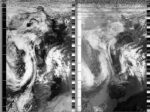



Walking through Hackney Downs at lunchtime today, in peak park-hour, my Yagi antenna was especially conspicuous. Yet I was excited to set up my ground station in the wildflower meadow which had recently begun to blossom with poppies, daisies, and many other beautiful flowers. As I didn't want to block the small paths that are cut into the meadow, I set up on an area just inside a path, where either a dog or a human or both had trampled the flowers, forming a thick mat of grass and aromatic vegetation. What I didn't properly think through was how this would look to other people coming to the meadow at lunch hour. From the path, it looked like me and my ground station were responsible for the squashed flowers. Also, me being off the path probably suggested I authorised or agreed with such flower-destroying activity. As I couldn't easily move when the pass had started, and I couldn't hide my tall Yagi antennna, I found myself exposed to all possible onlookers, park landscapers, dog walkers, mothers, and faraway judgers. Though I couldn't always see them, I heard people muttering under their breath and to each other about 'people' coming to trample the flowers. I stopped the recording early even though the pass was very high elevation and my yagi was performing great. I debated whether to post any photos at all but then decided not to hide what I did! I hope the ten minutes I spent in the off-path area of the meadow can be forgiven by humans and flowers alike.
2024-06-20 12:37:48
Sasha Engelmann
Hackney Downs, London, United Kingdom
United Kingdom
NOAA-18




As I left the flat with my measuring-tape Yagi for the third time this week, Soph sent me a satellite image captured from Vienna this morning in which a large dust plume is clearly visible over the Mediterranean and Italy. I wondered if my DIY Yagi can pick up the dust so far away from the UK. Looking at the antenna lying on the semi-parched grass of the park, it seemed highly unlikely (how could something made of scrap materials pick up the traces of tiny particles in the atmosphere hundreds of kilometres away?). Yet despite the very weak signal received yesterday, my experience testing the antenna on Tuesday suggested it might be possible. And only thirty seconds after the satellite pass officially started, the signal from NOAA was clearly audible and visible, and only grew in strength over the next one or two minutes, so that by the time I began to angle West the signal sounded crisp. Unlike yesterday, tracking the satellite was easy, or perhaps the signal was strong enough that I didn't need to be so precise. Still, while talking to Bill who came over during the pass and kindly took both documentation photos (thanks Bill!), I did slightly dip the Yagi and noticed a drop in the signal. To my great surprise, I recorded almost fifteen minutes worth of audio, so long that WXtoImg automatically stopped recording when the satellite crested the Southern horizon. The image captures a long stretch of Atlantic weather featuring two mini-cyclones (one north of Iceland, one hovering over the north of France) and only a small part of Western Europe and Africa. The dust is out of the frame, to the East. Yet I wonder if my and Soph's images were georeferenced and composited together, might some swirls of dust be visible across both of our images? A fugitive 'weather between us' in the refractions and reflections of quasi-invisible traveling particles.
2024-06-20 12:00:35
Soph Dyer
Augarten, Wien, Austria
Austria
NOAA-18



It's a balmy temperature, just warmer than my body. The sky is hazy and there is a cool breeze. The weather is mild, but I feel enraged.
At breakfast, I let rage well up inside of me as I read the New York Times newsletter's coverage of crisis of aid not reaching people inside Gaza. In my lay opinion, the article's conclusion is morally and legally bankrupt. I have worked on armed conflicts for the last seven years and yesterday, in preparation for a consultancy job, I read 'SOUTH AFRICA’S COMMENTS ON THE REPLY BY ISRAEL TO THE QUESTION POSED BY JUDGE NOLTE AT THE END OF THE ORAL HEARINGS HELD ON 17 AND 18 MAY 2024'. In short, denying civilians access to medical services and humanitarian aid is punitive and illegal. End of.
I suspect different colours of my rage are interconnected, like clouds of a cyclonic weather system. For example, I have such bad cycling rage at the moment and it’s very misandrist. Everything time a male cyclist overtakes me at the traffic lights and then proceeds to cycle slower then me – a regular occurrence – I mentally flip-out and practice the cycling equivalent of tailgating. I should stop this and find a better outlet for this negative energy. Recently, I chased down a male cyclist who had, unprovoked, shouted at me. Sadly, he didn’t notice and it was me who turned into a one way street in the wrong direction.
I could continue to list the things that have provoked rage in me, but there is little point as they are proxies for greater, less direct injustices.
2024-06-19 16:48:07
Sasha Engelmann
Hackney Downs, London, United Kingdom
United Kingdom
NOAA-15



This is day two of measuring tape Yagi antenna experiments. I missed all of the 'good' passes in the morning, so I tried for a NOAA-15 pass in the early evening that peaked in elevation at 17 degrees to the East. In contrast to my experience yesterday, where the Yagi effortlessly picked up the signal of NOAA-18 at a max elevation of 45 degrees to the East, this lower elevation pass turned out to be a struggle for the Yagi. I felt either I was not being precise enough with my aiming, or the pass just wasn't high enough for a signal to be well received by the measuring tape components. As I tracked the satellite, I became uncomfortably conscious that I was pointing this conspicuously large antenna almost horizontally over an open field where some young boys were playing football. I hoped I wouldn't be noticed by an anxious parent or onlooker.
2024-06-18 10:14:12
Sasha Engelmann
Hackney Downs, London, United Kingdom
United Kingdom
NOAA-19





My first pass with a homemade, 'tape measure' Yagi antenna! I followed a design described in a YouTube video by India Rocket Girl, though I cross referenced India Rocket Girl's design with other sources for tape measure antennas and DIY dipoles. I also watched around seven YouTube video tutorials on how to solder wires to each other and to metal surfaces as my soldering skills are incredibly rusty. I lacked many of the components that India Rocket Girl uses, but made do with zip ties and metal brackets that I found at the local hardware store. Instead of PVC pipe, I used a long piece of wood that was intended for house moulding. The tape measure was an old heavy duty one that I had in my electronics box. Last night after dinner I started testing a few things, and before I knew it I was knew deep, spread all over the flat (T was away in Italy). I didn't think I had gotten it right, and I was convinced I would need to re-solder, but when I set up this morning, connected the antenna to my dongle and lifted the giant Yagi off the ground, pointing north, the signal was immediately strong! I tracked the satellite to a maximum elevation of 45 degrees to the East and then down to the Southern horizon. Toward the end of the pass a couple approached me from behind and were almost as excited as I was about the tape measure design and the image of the Mediterranean forming on my screen. Shortly after they left, Martin rode over on his bike and kindly took the photos of me shared here, very grateful for documentation of this DIY moment! More testing to follow soon...
2024-06-17 13:17:03
Sasha Engelmann
Hackney Downs, London, United Kingdom
United Kingdom
NOAA-18

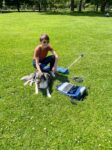

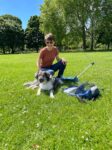

After what has seemed like weeks of rain, cold and relative darkness, today was a dramatic shift into sun and warmth. As I set up my ground station on Hackney Downs, a little grey dog around thirty metres away came sprinting over and jumped into my body, making contact with my face! One of its teeth even slightly knocked one of mine. It was a blur of curly fur for around thirty seconds during which I could hardly see my hands or antenna, and then it ran off again. I saw it go back to its owner, and then spot a sunbather on the grass that it could love-attack. Later, as I was packing up, a gorgeous Romanian sheepdog came over and sat down next to my laptop. This meant the woman accompanying him came over, and we ended up speaking for around ten minutes about satellites, data modes and encrypted / unencrypted data. I asked for some photos of 'Wookie' and she happily obliged and consented for the photos to be uploaded to the open-weather archive, on Wookie's behalf. As I left the field, more people had arrived and were cautiously undressing into swimsuits, checking the sky to see if it was really worth it. I went to the grocery store and bought portobellos, salad, cucumber, sweet potato and mochi.
2024-06-16 11:39:50
Sasha Engelmann
Intersection of Rue de Serbie and Rue du Croissant, Brussels, Belgium
Belgium
NOAA-19



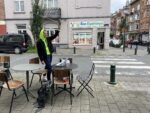

Camped out at a long table at a corner cafe, and feeling quite sleepy after a late night, five of us spoke for hours about our former lives, the legacy of communism in Bulgaria and the Balkans, developments in AI, and the politics of queer spaces. I set up my ground station at a cafe table on the streetcorner and was soon the subject of many looks and glances, though people were more hesitant to approach than the evening before. When Sofie arrived and began expressing enthusiasm about what I was doing and laughing at the situation, a small throng suddenly materialised around the ground station, including a man and a young boy, and an older man who gave me a small paper card that advertised 'La Constructorium Maya': "vise à construire une pyramide astronomique, un centre de démonstration des sciences et techniques, Précolombiennes à San Marcos (Lac Atitlan) au Guatamala". The man also insisted on showing us a photo of the Lake Atitlan, which was a pearl blue surrounded by deep green hills. Yet when I search for the website on the card I find what appears to be a french organisation that researches in the materials of building construction. Ten minutes through the pass, though we were still receiving a surprising signal given the five story surrounding buildings, rain began to cover my laptop and we went back inside. I placed my open laptop upside down on the brunch table so it could dry itself out. The following hours of the afternoon was a grey, dark, rainy mist until the sky suddenly cleared and sun poured out as Sofie and I left a bookshop where we had gone to a beautiful reading of a novel featuring vampires, a gay couple, a theatre festival and a skateboarding evangelist.
2024-06-15 21:43:18
Sasha Engelmann
Outside L'Athénée bar, Ixelles, Brussels, Belgium
Belgium
NOAA-18



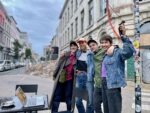

Sofie ran toward me in hall of the Gare du Midi in Brussels, and as soon as our bodies met we realised we were wearing almost the same thing: double denim, white trainers, a simple t-shirt. The next few minutes were a complete blur of overwhelming emotions, extreme happiness and my cheeks hurting from smiling too much. A group of us who had met at the Schloss Solitude art residency in Stuttgart, Germany during the Covid-19 pandemic had staged a reunion in Brussels, where Sofie lives. We spent the rest of the day talking at each other at hyper speed, visiting the exhibition of Belgian architect and feminist Simone Guillissen-Hoa, eating Congolese food in Ixelles, during which most of us ordered whole-fishes and plantain, speaking about life and loss in l'Athénée, and helping each other remember the many stories and moments we shared in the residency. Our experience of Schloss Solitude - a 17th century castle near a baroque forest - was particularly unusual as it happened during the second and third 'waves' of the Covid pandemic. We found ourselves - 35 artists from around the world - stranded in a castle on the top of a hill, affected by a rigorous German curfew and travel ban on movement between regions, let alone countries. Yet our 'castle of crossed destinies' ended up being some of the most memorable months of our lives, with experiments in collective living, workshops and teach-ins, dance classes, countless forest walks and excursions, mushrooms trips, meals and the making of what is now a family. When I went outside of l'Athénée to capture an image from NOAA-18, the night was late but there was still a thin light, and Sofie, Olivia and George came out with me. I spoke to a group of strangers who were immediatley interested in the radio antenna and satellite image, and we laughed in a semi photo shoot with the four of us. I wondered if the radio-borne satellite image, however noisy due to the tall surrounding buildings and angles of the city, registered the frequencies of our joy.
2024-06-14 12:14:18
Sasha Engelmann
Hackney Downs, London, United Kingdom
United Kingdom
NOAA-18



As sudden rains wash through London today, I share the cover of a Plane tree with a Deliveroo driver, an older man with a cane, and a couple of young people playing hookie from school. We form an unlikely bunch, me crouching over my laptop to protect it from stray drops and angling my antenna to the East, and the others either on their phones or sneaking glances at me and at the sky to assess when the rain will stop. We don't speak. In the relative silence, my thoughts continue to be jarred by news of events in Argentina, received in part through Democracy Now, and in part through intermittent texts and updates from two of my close collaborators (on a community air-sensing project) in Buenos Aires. The news media (specifically the Guardian) reports in characteristic language that "Argentina’s Senate narrowly voted to approve the first set of harsh austerity measures proposed by President Javier Miliei... Police used pepper spray, water cannon and teargas against the huge crowds while demonstrators set two overturned cars ablaze and threw molotov cocktails". I think about the generic-ness of this reporting, how little it actually says about the events occurring. Or, conversely, how much it says about how often similar events are occurring. A think tank in Oslo has just released a report that states that there were more armed conflicts in 2023 than in any year since World War II. From Buenos Aires, J writes a text explaining Milei's proposed legislation, that follows months of violent executive orders: "They're changing the retirement age for women and getting rid of a retirement pensions moratorium, making it impossible for informal workers to retire. Plus, they're giving foreign extractive companies the right to litigate in foreign tribunals. These companies get access to natural resources over everyone else, even the indigenous people of Argentina, who have lived in harmony with nature long before the nation state existed. It's really tough, especially in the middle of a years-long recession and economic crisis, with poverty rising to a staggering 55%". D shares that some students from her university have been unfairly imprisoned last night, not far from her house. She tells of an audio message from the mother of one of the students who has been allowed to visit the prison, and it reveals that seven women are on the floor [of the cell] since yesterday, including the students'. 'A form of torture' D adds. All of this as Milei prepares to travel to the G7 summit, a guest of Giorgia Meloni. All of this as 50,000 new fires have been reported in Argentina the past several days, despite the winter season. I spend the rest of my day thinking about Aya Nassar's question: "we hold our breath. Where do we go from here?" (2024: 3).
2024-06-13 12:25:27
Sasha Engelmann
Founder's Field, Royal Holloway University of London, United Kingdom
United Kingdom
NOAA-18
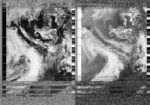



On the train to the university campus this morning, I think: what might it mean to ‘queer’ air, and our relations to it? Several scholars I read and admire have recently gestured to air’s queerness. Nerea Calvillo writes about queering as a practice that is useful when we consider airborne things like pollen. Nerea writes, “Because if air is commonly pictured as an inanimate (and often toxic) gaseous entity, queering it brings to the fore the whole world of animate and invisible entities that are part of it” (2023: 240). Queering air “brings desire, multispecies reproduction and interactions, excess, and ambiguity” to the fore (2023: 241). Nerea thus figures queering air as a tactic of honouring air’s multiplicity and deviancy.
Talkign about multiplicity: later in the day I am standing on tiptoes attaching an antenna to a football post while an airplane approaches Heathrow airport, flying very low over the university campus, and appearing in the corner of one of the documentation images. Minutes later, I am listening to the Russian satellite Meteor MN2-3 drown-out the weaker signal of NOAA-18. The electromagnetic trace of the Russian satellite is clearly visible in the gradations of static in the Southern portion of the image I capture from NOAA. Even later, I am “close reading close breathing” the work of poet Julianna Spahr, cited in the writing of queer theorist Lauren Berlant (2022: 101). An excerpt from Spahr’s poem ‘This connection of everyone with lungs’ goes as follows:
as everyone with lungs breathes the space between the hands and
the space around the hands and the space of the room and the
space of the building that surrounds the room and the space of
the neighbourhoods nearby and the space of the cities in and out
Earlier this week I cited Stephen Connor’s writing on the ‘spaces of observation’ created by scientists to treat air as an object, as a volume that could be controlled. Spahr’s poem offers a very different diagram of air to space, and I would argue this is a queer one. The word ‘air’ is never mentioned in the poem, yet ‘breathes the space’ arises several times. Air is an anterior, a semi-nothingness that nevertheless infrastructures lungs and spaces. Though the poem intersects scales from the space around the hand to the space of neighbourhoods and cities nearby, it doesn’t do so by ‘nesting’ scales in the way we often see in popular media and culture, where the ‘body’ is placed in the ‘local’ and this sits inside the ‘urban’. Instead, reading the poem (that spans several pages) is an interstitial experience where breath is hinged to space and space is in turn hinged to different and plural scales, from the intimate to the planetary. This is an "affective scene [that] focuses on receiving and metabolizing the world while unraveling its presumed solidity" (Berlant, 2022: 97). This is perhaps a "queer reboot of the common" (Berlant, 2022: 99) that comes about through the queering of air.
2024-06-12 12:36:57
Sasha Engelmann
Hackney Downs, London, United Kingdom
United Kingdom
NOAA-18



Watching the satellite image load on my screen around lunchtime, it is hard for me to identify bodies of land, the characteristic sharp edge of France or the icy fingers of Norway. I am not sure if I can make out the fingerprint that is Iceland in the North Atlantic, normally so disinguishable. With my 'orientation devices' missing, I am lost to dis/orientation in the swirls of water vapour, the speckles of reflective cloud-light and the nondescript grey pressing down on me from above. Later in the day, I am reading Mel Chen's piece 'Feminisms in the Air' and in the very last sentence Chen introduces a term I have not heard before, 'melancholic pragmatism'. They write, “Out of the desperation and melancholic pragmatism of this moment, at stake are a series of questions about the “about” of feminisms whose imaginations promise something in the end” (2020: 29). I follow the footnote to read more about 'melancholic pragmatism', and find the following: ““Melancholic pragmatism” is a phrase that emerged in my conversation with philosopher and activist Alisa Bierria on October 17, 2020, about melancholies that do not end in what can be a strangely idealistic form of lossful nihilism, or that are perpetually delayed or denied, but are permitted to exist, registering layers of complexity and acceptance of inevitable complicity and incompletion” (2020: 29). I can relate to this definition of melancholic pragmatism, as it feels like the affective texture of what remains in many of my friends and family members after experiencing the winter of 2024 and the collective witnessing of war crimes in Palestine, Sudan and elsewhere. I imagine that Chen, writing in the midst of the COVID-19 pandemic, might have been feeling a slightly different melancholy, with different layers of 'complicity and incompletion' but nevertheless I think there are similarities, not least of which is the sense that neither nihilism or denial are workable options. Instead, we permit our ethical and moral melancholies to exist, we permit the impenetrable grey skies to press down, and we permit the understanding of a year of climate catastrophe that is only beginning to show how much of an anomaly it truly is. As my workday draws to a close around 7pm I fantastise about writing Chen an email to ask: what is your melancholy layering now? what are you permitting?
2024-06-11 12:49:55
Sasha Engelmann
Hackney Downs, London, United Kingdom
United Kingdom
NOAA-18



Today I am reflecting on volumes of air. In the book 'The matter of air: science and art of the ethereal', Stephen Connor recounts some of the seventeenth century scientific experiments that sought to examine air. He writes: "To study an object, one must pick it out from its surroundings, and concentrate it in one place. How was one to make of the air such an object? How was the air to be picked out of its surroundings, when air was ambience itself? How was the air to be brought before one, when it was of necessity and at all times about?" (Connor, 2010: 17). To 'pick something out' from its surroundings, to 'concentrate it' and to bring it 'before one' is to orient toward it. Yet this act of orientation proves tricky when the thing one seeks to 'pick out' is 'at all times about'. Connor continues: "What if, rather than trying to roll the air up into a ball that one could look at from the outside, one were to produce a space of observation - an air-lock - within the very space of the air?" (2010: 17). Thus, in lieu of condensing air, one might work to enclose it, to create a space in which air is 'locked'. I think of all of the times I have seen air get 'locked' and I think of Robert Boyle and his Enlightenment contemporaries, trying ceaselessly to get air into glass spheres, the better to isolate, contain and observe it. I think of all the 'holds' (Sharpe, 2016) in which humans were locked in ever-dwindling air, yet whose stories are rarely considered in narratives of Enlightenment science or scholarly histories of architecture, space and volume. Could Boyle have conceived of the consequences of volumetric air? Could he have examined the vacuums he created in so many glass spheres as caught up with, rather than removed from, vacuums of airelessness for vast numbers of humans in his time and hundreds of years beyond it? As 'volumetric thinking' is put to work in Gaza every day through the use of aerial weapons from white phosphorous to CS-gas, I wonder, with Aya Nassar: "What if we linger in the gaps between fragments and shards? Is there anything there? Not in the wreckage and debris - we know that well, too well - but in the space of making dust when it is not yet the aftermath?" (2024: 3).
2024-06-10 10:09:56
Sasha Engelmann
Hackney Downs, London, United Kingdom
United Kingdom
NOAA-19



The sunlight comes sideways today. There are low-hanging, grey and dark blue clouds circling above, and I leave the flat for the park a few moments after rain has stopped, feeling daring with my uncovered laptop. A flash of sun comes from the horizon as a gap in the sky opens for a few seconds and closes again. I can tell the moment when the sun has come out for just long enough to lure a whole hoard of dog owners and dogs outside, yet as soon as they reach the field the darkness falls again. I am in the park just long enough to see Martin who rides over on his bike, and we briefly speak about his plans to build a satellite ground station. As I work at my desk for the rest of the day, I am surprised by the slantwise light, searching through the corners of our kitchen and living room, making the whole place seem a little off-kilter, making my admin tasks feel a little surreal. I find myself turning on and off the desk lamp and living room light, unable to find optimal emailing conditions. One clap of thunder booms across the city just after lunchtime, answered by a far away siren.
2024-06-09 12:04:33
Sasha Engelmann
Hackney Downs, London, United Kingdom
United Kingdom
NOAA-19
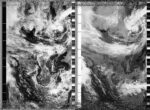


Pockets of deep cerulean blue shown through grey and white cloud this Sunday morning. I stole a few minutes to capture the satellite image before heading out to a local pub for a roast with my partner and one of her ex-partners who is staying with us for the weekend. As the pass was ending, a man named Paul rode over to me on his bike, and asked what I was tracking. He was suprised that the answer was satellites, as he had expected wildlife. After I asked Paul to take a photo of me (two of which are attached, thanks Paul!) he said he could show me a photo of him. The photo was of Paul next to a train with the lettering Dr Paul Stephenson on the side. 'In my dreams!' joked Paul. Later in the day I looked up the train, and found out that Dr Paul Stephenson is a well known civil rights campaigner in the UK who organised the 1960s Bristol bus boycott which overturned a ban on people from ethnic minorities working on buses in the city. Dr Stephenson's campaigns were instrumental in paving the way for the first Race Relations Act in 1965, and in 1992, he also helped set up the Bristol Black Archives Partnership, which protects and promotes the history of African-Caribbean people. Great Western Rail apparently has a programme called the 'Great Westerners' where people can be nominated to have trains named after them, as a mark of respect to contributions to UK society. I had not heard of this practice of dedicating trains, and this made me wonder whether airplanes or satellites are ever dedicated in this way. Soph and I had recently wrote a short text that includes a vignette of a woman who asks to have her name attached to a powerful storm, and it becomes Storm Babette. I had assumed that 'In my dreams' referred to the 'Dr' part of the name, but I realised maybe it was about having your name on infrastructure, or being recognised as a 'great westerner'...
2024-06-08 11:46:39
Sasha Engelmann
Hackney Downs, London, United Kingdom
United Kingdom
NOAA-18


The air is warm but skies are grey, which has been a regular theme these last few weeks in London. A man named Rowan walked barefoot across the grassy field and introduced himself by saying "I think you can guess the question I'm going to ask you". We spoke for almost the duration of the pass, and he kindly took the attached photo of me. As I was explaining NOAA-18's Advanced Very High Resolution Radiometer and how it scans Earth's surface in six spectral bands, but only two of these six are represented in the APT image appearing on my screen, I remembered an article sent to me and Soph by Bill Liles (NQ6Z) that tells the story of Virginia Norwood, sometimes called the 'Mother of Landsat', who designed the Multispectral Scanner (MSS) on board the first Landsat satellite (Landsat-1) launched in 1972. Virginia famously worked with a team to invent a scanning instrument that used a mirror moving between two 'bumpers' at a rate that allowed precise scanning of Earth's surface. According to the article in the MIT technology review, Virginia worked hard to convince NASA and other scientists of the precision of the scanner, and many were sceptical of what they called the 'banging mirror' and how it would work in space. Learning of this history, and specifically the working of the MSS, made me wonder about the relationships between the MSS scanner and the AVHRR of the NOAA fleet. My guess is that early scanning instrument knowledge of the 60s and 70s was shared across NASA and NOAA teams, since these organisations are so entangled with each other and with defense operations. I do also know from previous research that the Automatic Picture Transmission common to most NOAA satellites was first tested in 1963 on TIROS-8, almost a decade before the MSS instrument was launched on the first Landsat satellite. The experimental APT transmissions from TIROS-8 used data from 'a five-channel scanning radiometer', but TIROS-8 also carried two TV cameras (images from these cameras were either transmitted directly to US ground stations when the satellite was in range, or stored on a tape recorder until transmission). A key difference between NOAA and Landsat programmes was purpose- since its formation in 1970, NOAA operated a fleet of TIROS-type weather satellites that were intended for meteorological uses, and so were relatively low resolution. According to NASA, the innovation of Landsat was to produce higher resolution terrestrial images of earth that could be useful to understand crop distribution or even geology, and would supplement the very high resolution of land captured from airplanes. Yet Landsat has further historical relations to NOAA. According to the Wikipedia entry on the Landsat Programme, "In 1979, President of the United States Jimmy Carter's Presidential Directive 54 transferred Landsat operations from NASA to National Oceanic and Atmospheric Administration (NOAA)". Under NOAA's tenure of the Landsat programme, prices for Landsat data soared, as NOAA sought to recover costs from users. This unfortunately led to a massive decrease in Landsat data, except for very powerful and resourceful companies like those in the fossil fuel industry (though we also know that the US government gave special access to satellite imagery for fossil fuel corporations at different points in history). Much like the three still-active NOAA satellites have recently been contracted to Parsons Corporation, the Landsat programme was also temporarily privatised. "This occurred in 1985 when the Earth Observation Satellite Company (EOSAT), a partnership of Hughes Aircraft Company and RCA, was selected by NOAA to operate the Landsat system with a ten-year contract" (Wikipedia). The transition to private maintenance was not smooth, and funds were very short, so in 1989 NOAA directed the shutdown of Landsat 4 and 5. The shutdown was averted by the US Congress, which shifted policy and found emergency funding for the Landsat programme, bringing it back under the control of the government and opening Landsat data once again for widespread use. This was a well timed rescue, since Landsat 6 failed during launch and crashed in the Indian Ocean. Like NOAA-15, 18 and 19, satellites that have remained active long passed their intended lifespans, there are similar stories in Landsat. According to a 2012 article by NASA, "Despite all of the ups and downs, Landsat 5 and 7 operated far beyond their designed lives. The Thematic Mapper (TM) on Landsat 5 only recently gave out after 27 years of imaging; around the same time as TM shut down, operators managed to turn the Multispectral Scanner System (MSS) back on after years of dormancy. Landsat 7 continues its work as well, 13 years after launch". Across NOAA and Landsat, then, there are some common stories of instrumentation, orbital patterns, attempts at privatisation and the longevity of the satellites themselves. As we prepare for the decomissioning of the three still-active analogue NOAA satellites, I'd like to go deeper into the interconnected histories of satellite programmes, scanning-instrument types and the different sorts of 'publics' they were intended to serve.
2024-06-06 20:50:00
Soph Dyer
Issey Sushi & Co, Wien, Austria
Austria
NOAA-15


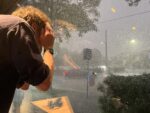
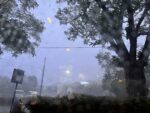
My sister, R, and her partner, B, are visiting from Cornwall. They have come to see me and N, with the hope of drying out after the wettest spring on record in the UK. They both work on the land so are very exposed to the recent extreme weather. R has decides to me how the land, after being so waterlogged has now dried smooth and cracked making planing difficult. Plus, the warm wet weather has caused the local slug populations to explode. I’ve been having nightmares of the weather being so terrible when they visit that R decides to emigrate with B to Australia. At least the first part of the nightmare comes true. R, B and me are trapped in a restaurant shop as the heavens open and day turns to night. Only an hour earlier we’d been swimming in an outdoor pool. Now the road is a torrent of grey water. A standing wave forms where the pavement used to begin. Everyone in the restaurant is watching the storm, impressed by its power. The lightening strikes close, the thunder cracking overheard with almost no delay. The limbs of trees flail, adding to the drama. R says that the sorting of sushi boxes into the square bags of delivery drivers looks like a three dimensional game of Tetris. At some point the delivery drivers must have headed into the storm as when I look up from trying to photograph the rain, they’re gone. When the rain lessens we pay up and leave. The rain has stopped but the lightening continues to flash until after midnight. I give up the idea of sticking an antenna out of the window and decode to upload this weather note instead.
2024-06-07 10:10:13
Soph Dyer
In the moist air of the park, Wien, Austria
Austria
NOAA-19


I miss the beginning of the satellite pass, but enjoy sitting in the humid, sun. It’s deceptively warm. The image crop is awkward but perfectly frames the Mediterranean Basin and Black Sea. In the ‘visible channel’ there are few clouds, however the infrared channel reveals of wispy veil of cloud over most of the continent. North Africa is cloudless.
2024-06-05 11:49:10
Soph Dyer
Pedestrian crossing, by work, Austria
Austria
NOAA-18



It’s noon and the weather is hot and steamy. My head is fuzzy from drinking pink Prosecco with M for her 40th birthday. My antenna is clutching a roadside pole next to the pedestrian crossing outside our studio. An older woman crosses the road, stooped and slow. She must have felt my gaze on her back, as she turns her face folded into a warm smile. I smile back. Trades people and children pass, openly curious but mostly unsmiling. I note how an electric scooter and hybrid bus cause bands of radio frequency interference.
2024-06-04 23:33:06
Soph Dyer
On the balcony, Wien, Austria
Austria
NOAA-18


On WhatsApp, I write to my brother: "It rained so heavily in the night our flat was saturated by the sound. I half expected to wake to flooded streets".
2024-06-03 20:48:20
Soph Dyer
At home, Wien, Austria
Austria
NOAA-19



I have skipped two days of weather notes. It’s Monday. Thunder rolls as Sasha and I frequency shift from one open-weather Zoom call after another. First we heard from L and D in Scotland about how the satellite image decoder is up and running, and the redesign of the Public Archive is almost complete! We then spoke to G in Berlin who shared with us the code that he is writing for the automatic satellite ground stations. Together we started to speculate about how the 3D printed casing of the satellite ground stations could be. We imagine the ground station box resting on a bedroom bookshelf or mounted the wall of an art gallery. We tingled with excitement, encouraging each other in the game of visualising the work complete. In between, Sasha and I spoke with J, a curator in Barcelona who is planning an exhibition on the themes of navigation and orientation … let's see. I took some Ibuprofen to avert a migraine and then couldn't stop sneezing. Sasha giggle when, I turned of my camera instead of muting and loudly blew my running nose. As my work day ended, the thunder storm moved overhead. On a call with just Sasha , we draw on our remaining brain power and belief, I shared my proposal for a sounded-based transmission for the Year of Weather project. Inspired by the desire to 'meet people where they are' and by how past feminist alliances such as F.I.R.E. in Costa Rica and Pirate Radio Women in Ireland used radio to share with their community counter narratives and information, the transmission would share our weather notes intermingled with the realtime local weather updates of a meteorology service. A second important reference is the "VOLMET" radio broadcasts that are rolling weather forecasts for aircraft, read out often by highly gendered and increasingly automated female voices. Before hanging up, Sasha and I began to test the proposal and to think through different scenarios. I had planned to squeeze in a hours more work but my brother called and we spoke almost two hours. It rare that we speak for so long on the phone, so the call was special. Lightening seemed to knock of the signal so I move around the flat, searching for a more stable signal, plugging in my phone to different wall sockets.
2024-05-29 11:35:05
Soph Dyer
Augarten, Wien, Austria
Austria
NOAA-18

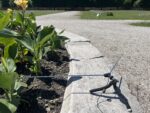
It is sunny. A few white and grey clouds move across an otherwise deep blue sky. A cool wind raises the hairs on my arms. As I receive the radio transmission, I imagine NOAA-18’s rapidly changing location. “Are you over Latvia or Lithuania? Perhaps now Belarus?” I ask. “What do you see?” The questions are not rhetorical nor do I expect a reply. I list the countries its invisible trajectory crosses: Ukraine, Romania, Bulgaria. The satellite’s signal begins to stretch, its wavelength subtly lengthening as it moves away from me. “Have you crossed into Greece?” I ask. “Are you over the blackness of the Mediterranean Sea?” My line-of-sight with the NOAA-18 is unbroken as looks down on Cairo and Egypt, then, it its East, Gaza and Israel. Here, I loose its signal and my line-of-sight. Later, I look up the poetry of Mahmoud Darwish, and re-read ‘Poetic Regulations’
“The stars had only one task: they taught me how to read.
They taught me I had a language in heaven
and another language on earth.
Who am I? Who am I?
I don’t want to answer yet.
May a star fall into itself, and may a forest of chestnut trees rise in the night
toward the Milky Way with me, and may it say:
Remain here!”
2024-06-01 21:11:06
Soph Dyer
Sitting on the window ledge, Wien, Austria
Austria
NOAA-19

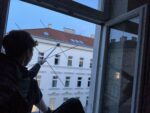
Today hasn’t been easy. The weather is sodden and my mood is low. I almost miss the satellite pass and make a last minute decision to try and receive the transmission from the flat. Sat on the window ledge, precariously positioned over the wet street three stories below, I receive an imperfect image. I am glad.
2024-05-28 12:24:53
Sasha Engelmann
Downs Road, London, United Kingdom
United Kingdom
NOAA-18




My senses are dulled and my body aches in a dull, persistent way that reminds me eerily of Covid. For most of the day I struggle with clouded focus and a heaviness in all of my limbs. Two lateral flow tests come back negative. I get worked up in an online committee meeting and sweat through my shirt as I wait for my 'raised hand' to be summoned. Soph wonders if I am fighting a (non-Covid) virus, and I remember the way my colleague was coughing in the office when we met on Friday. Yet what I am feeling is nothing like a 'common' cold or flu. On the way to the local health food store, we happen upon a baby fox hiding among sand bags next to a construction site. Passing me, my partner, and the fox, a man says this particular fox had been 'dropped' into his back garden by fox-parents some weeks ago and the fox's family would bring food until the little one was strong enough to jump out. What had it done, I wonder, to deserve such gentle entrapment? It peers up to us, seeming both mildly frightened and defiant. At the health food store, 'East of Eden', I browse a wall of herbal remedies, powders and cures. They have names like 'organic dog blood', 'raw moon' and 'bread nut'. I am surprised not to read 'fox tail'. I don't know what to choose and I end up with dark chocolate and bananas. I wait for my body to give me more signs - a sore throat? a fever? The full-body ache is both everywhere and nowhere, showing no signs of sharpening or waning.
2024-05-27 20:32:49
Soph Dyer
Sitting on the window ledge, Wien, Austria
Austria
NOAA-19


Humid, blue, warm skies. Tired, achy, loose body. Humid and tried, blue and achy, warm and loose.
There is lightening interference from a storm to my West.
I read the news, not making it more than a few paragraphs. "The Israeli missiles struck tents in an area to the west of Rafah city that was supposed to be safe from attack". "[A]t least eight missiles struck the camp – a designated safe zone – on Sunday night at about 8.45pm local time (17:45 GMT). "Witnesses described charred bodies and flames. A doctor said the majority of the victims he saw were women and children". (The New York Times, 27 May 2024) “'We pulled out people who were in an unbearable state,' Mohammed Abuassa told the Associated Press. 'We pulled out children who were in pieces. We pulled out young and elderly people. The fire in the camp was unreal.'” (Associated Press via The Guardian 27 May 2024)
Judith Butler asks, “Whose lives are regarded as lives worth saving and defending, and whose are not?” They continue: “One way of posing the question of who “we” are in these times of war is by asking whose lives are considered valuable, whose lives are mourned, and whose lives are considered ungrievable… We can see the division of the globe into grievable and ungrievable lives from the perspective of those who wage war in order to defend the lives of certain communities, and to defend them against the lives of others—even if it means taking those latter lives.” (Butler, 2009)
2024-05-27 12:36:10
Sasha Engelmann
Hackney Downs, London, United Kingdom
United Kingdom
NOAA-18


King of Hearts lying listlessly in the grass, crumpled from hands, wind and rain, and ripped (possibly burned?) on one of its edges. A woman and a dog walk past, and the dog makes a wide circle, looking at me inquisitively. "You must get many such looks of suspicion!" jokes the woman. A corner of Svalbard - Spitsbergen - appears at the top of the satellite image as I manage to capture the transmission from the 'High North', much earlier than usual, by standing on my tiptoes and stretching the antenna above my head and at a semi-parallel angle with the ground. I generally avoid such acrobatics as I usually run out of my flat and set up my station only moments before the pass starts, missing the noise from the North. My t-shirt threatens to come out of my denim jeans. For some weeks, a tent has been quietly living under the shade of the vines next to the bike parking area where Downs Road meets the park, and today there is a piece of laminated A4 paper saying '7 day notice'. The notice looks ridiculous strapped to the fabric of the tent with a black zip tie. The absurdity of the notice and the underlying violence it represents reminds me of D Asher Ghertner's (2020) work exploring how contemporary architectures of space and atmosphere "draw from colonial logics of bodily sequestration from outside threats". In other words, we are not just 'living' and 'breathing' the last several centuries of colonialism, extraction and exploitation building up as heat and toxicity in the air (as suggested by Denise Ferreira da Silva), we are also living and breathing "durable spatial dispositions governing how atmospheres are felt, arranged, and imagined". In other words, we are living and breathing ways of engineering and creating air/space that can be traced to the racialisation of the lungs of bodies of colour, the architectures of 'hilltop sanitoriums' where the wealthy could breathe 'clean air', and the personal technology of the air pollution mask, which has a very long history that far predates covid-19 or recent air pollution debates (Ghertner, 2020). Attempts at 'climates of enclosure' that work differently, like that of the streetcorner tent, and that engineer airspaces for those in crisis, are 'given notice' precisely because of this history.
2024-05-27 20:45:48
Soph Dyer
Leaning out of the window, Wien, Austria
Austria
NOAA-19





My image contains interference from lightening strikes. I have likely seen lightening interference before, but it a first for me to be able to confirm it. The sky above our house was blue but to the East I could see dark storm clouds. Each time the clouds flashed orange, even though they they were too far for thunder to be audible, I could 'hear' the strikes as bursts of radio noise. I have uploaded a photo of the waterfall display clearly showing a horizontal line of interference from a lightening strike. In the decoded imagery, the lightening is visible as broken lines, not more than a one to two pixels wide. Given the position of NOAA-19, the storm must have been between me and the it. I should note that that last photo of the storm clouds almost overhead was taken more than 10 minutes after I had finished recording and packed away my antenna. Under no circumstances is it wise to point an antenna in the proximity of a storm. I admit that the speed of the storm clouds surprised me. As they approached, a warm wind got up and shook trees on the street below, while I watched neighbours rush to closed windows on flapping curtains. The change in light levels was dramatic too. In less than half an hour, day turned to night.
2024-05-26 12:50:04
Sasha Engelmann
Hackney Downs, London, United Kingdom
United Kingdom
NOAA-18
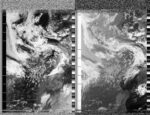



The pass started with an experience of signal flooding: Meteor MN2-3 drowned out the signal of NOAA-18 in a powerful broadcast many times the bandwidth of the analogue NOAA satellite. I could spot the Russian satellite by the characteristic 'surge' of energy that suddenly appeared around 137.9125 MHz, also the downlink frequency of NOAA-18. Only a few minutes later, I found myself speaking of another kind of flood with Ria and Philip, two Jehovah's witnesses who visited my ground station. We had a wonderful conversation about 'seeing' the satellite through radio waves and the types of clouds forming (of which Ria could identify many), and when I mentioned NOAA, Ria immediately connected the name to the Noah who predicted the great flood. I was immediately reminded of the words of Daisy Hildyard when she wrote a response to my and Soph's first open-weather performance, 'Open Work, Second Body'. Daisy begins with the story of Noah's ark as remembered by Proust: "Noah could never have had so a clear view of the world, wrote Proust, as when he gazed upon it from within his ark, sealed though it was, and when darkness was all over the Earth". Later, she describes, "that feeling that isolation and solitude can illuminate if not irradiate a feeling of the outside world". As it was for Ria, for Daisy, "it's hard not to see a gesture toward the old story of the ark that floats alone above the world it came from, a story that was also about making sense of strange weather and predicting or creating futures... a story about how different bodies weather the environment differently". As I leave the park, Ria asks if I can email her the satellite image, and of course I say yes. I think about the image as another kind of ark, floating between my laptop and Ria's, though perhaps on a journey that, by virtue of our conversation, is slightly less lonely.
2024-05-25 13:01:26
Sasha Engelmann
Hackney Downs, London, United Kingdom
United Kingdom
NOAA-18



In a new book called 'The Nerves and their Endings: essays on crisis and response', Jessica Gaitán Johannesson writes, "For those who haven't yet experienced climate collapse in our own bodies, a history not yet written into us, the feeling [of] it arrives in the shape of shadows, an atmospheric wrongness, and harrowing predictions" (Johanesson, 2022: 6). When Johannesson refers to 'those of us who haven't yet experienced climate collapse in our own bodies' she invokes a double meaning. Those who haven't yet experienced climate collapse in a bodily way might refer to the privileged, largely global north 'us' who have yet to experience the world-endings of global heating in an immediate, visceral sense. However, since Jessica opens the book with a vignette from a hospital ward where she was treated for anorexia in her 20s, this phrase may also refer to 'those of us who haven't experienced climate collapse in our own bodies - i.e. an illness like that of an eating disorder' that is fundamentally an illness of control, but also one in which agency (the 'cause') is heavily blurred by the 'slow violence' of gradual but persistent self-harm, diet culture, fashion imagery, 'health magazines', enforced gender binaries, parents and friends too scared or busy to say anything, and the exposures of growing up in capitalism. Johanesson makes the point that by the time one ends up in a hospital ward because every day, for a long time, one has chosen death over life, the advertisers, celebrities, coaches and early childhood events are long gone- you are all that is left, and there may not be much of you left. By the time we cross 1.5 degrees Celsius warming, the 16th century colonisers of Africa and the Americas, the architects of 'development' and 'aid', and the engineers of late liberal capital, are long gone. I do think the analogy has its limits. But I wonder, with Johanesson: might it be that those who have reached the brink of inexistence (by their own means) and come back, who have responded to the harms of contemporary society by so severely harming themselves, and then returned, have something to say about 'climate collapse'? Might they see a bit further than most through 'the shape of shadows' the 'atmospheric wrongness' and the 'harrowing predictions' ? And might the tools of recovery be relevant - tools that require one, every day, long after one might be 'recovered' (as recovery 'never ends'), to consciously 'choose the world'; teachings that one is not 'in control', no matter how much control one may have demonstrated by not eating for days; and the insight that unless the world around us is nourished, we will fail to nourish ourselves.
2024-05-24 09:10:47
Sasha Engelmann
Founder's Field, Royal Holloway University of London, United Kingdom
United Kingdom
NOAA-15

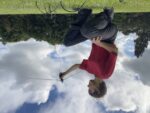

Today, the headlines say that the ICJ is delivering 'a new ruling on Israel's war in Gaza'. In doing so, reporters state, the ICJ could order a halt to Israel's offensive. This is coming months after the ICJ ruled that Israel was plausibly committing genocide back in January, and many thousands of deaths later. Meanwhile, Israeli forces intensify attacks in Jabalia and Rafah. Meanwhile, the Guardian warns that we are about to experience the busiest bank holiday in years with more than half the nation's cars on the road this upcoming weekend. Meanwhile, this last week's heavy rains have caused playgrounds in East London to flood with sewage, according to my geography colleague who lives on a boat and works as a river guardian. Meanwhile, students in my department are taking an exam in a third year cultural geography course on commodities. The university campus is green, leafy and quiet; there are no visible acts of protest, no encampment, no sit-in or lie-in. Yet, from a union meeting earlier in the week, I know the university has passed new policy making it more difficult for students to engage in protest in the form of encampments, though people objected to this new policy being called 'draconian'. In a poem titled 'Fuck your lecture on craft, my people are dying' Noor Hindi writes "Colonizers write about flowers / I tell you about children throwing rocks at Israeli tanks / seconds before becoming daisies". Later she writes, "Metaphors about death are for poets who think ghosts care about sound / When I die, I promise to haunt you forever".
2024-05-23 21:21:17
Soph Dyer
Friedhof Hernals (Hernals Cemetery), Wien, Austria
Austria
NOAA-19


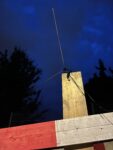
Again, my phone's weather app says that it will rain, but the day turns out fine. I doubt the algorithm's ability to account for the dramatic effect of the Alps on Vienna's weather. There can be huge thunderstorms only a couple hundred kilometres South, and Vienna will be basking in sunshine. My day, too, defies my expectations. I woke early, rough, the swelling in eye gone down but the pain in my side throbbing. Yet work was good and afterwards I cycle to an outdoor pool, then indulged in sushi at a neighbourhood restaurant with N. I received this image from a hilltop cemetery. In the silence afterwards, stood on a path between the flickering of red lamps of graves, I feel time thicken. I am reminded of how Libyan author Hisham Matar, when stood at a cemetery's edge, asks "What is it to remember the dead?" For Matar, "the scale is unfathomable". It is "[d]eath’s endless appetite", he writes. "The deceased outnumber the living by such a scale that the present suddenly seemed to me to be the golden rim of a cloth". (Matar 2019)
2024-05-23 11:45:30
Sasha Engelmann
Hackney Downs, London, United Kingdom
United Kingdom
NOAA-18




As I knelt in the cut grass watching an image from NOAA-18 form, I noticed a tall man drawing a yellow tape around the gnarly plane trees nearby. After measuring the circumference he started to circle the trees from below and make notes on a pad. When I was done with the satellite pass I went over to speak to him, and learned that his name was Nathan, and he was surveying the plane trees for health on behalf of the local council. He told me about Massaria disease, believed to be caused by the fungus Splanchnonema platani, which used to be known as Massaria platani until scientists discovered features that required a species name-change. Massaria disease has been found in several parts of the UK in the 21st century, but it is believed to originate in the Mediterranean region. Yet spores were even detected in the air by a survey ship stationed over the mid Atlantic oceanic ridge between the Carribbean and Africa. The distance was somehow fresh in my mind as I had just captured a long satellite pass that included a long stretch of the Atlantic. The fungus has a reddish colour and causes bark to peel off branches, and eventually branches die back. Massaria specifically affects plane trees, but because plane trees are so crucial to the health of London - their leave collect and absorb air pollution, they provide large amounts of shade, and they are resistant to other urban conditions including heat - the Massaria has implicitations for the exposures and vulnerabilities of London's human communities. Nathan suspects most plane trees already have the disease, but it is when they become stressed that they manifest symptoms and health issues. The plane tree in front of us was probably 200 years old, had a diameter of 160 cm, and was doing reasonably well despite its 'pruning scars' and one low-hanging branch that showed signs of Massaria. Nathan asked me in return about my antenna and what I had been measuring. There was something poignant in our encounter - a tree health specialist carrying a diameter tape and notepad, and me with a handheld antenna and laptop - reflecting on air-travelling spores, urban trees and climate.
2024-05-22 11:58:09
Sasha Engelmann
Hackney Downs, London, United Kingdom
United Kingdom
NOAA-18


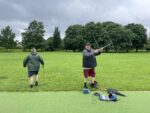
The surfaces of London are covered in traces of the downpour that happened last night. Though the rivers and ponds of water have drained away somehow, pools and thick mud remain. I meet Bill, his partner and their dog Nutmeg during a break in the rain on Hackney Downs. We speak about gravitational waves and the aurora. Bill asks to hold the turnstile antenna and kindly agrees to a photo. As they head on their way, I overhear Bill explaining to another dog owner what I am doing, and I feel grateful that Bill has become a mediator for the project in the neighbourhood, as I might otherwise get quite different reactions! Meanwhile the satellite stays 'in the sky' so long that my recording software automatically cuts off the recording when it nears fifteen minutes, but I can still 'see' the signal. As I decode and examine the weather image that reaches from Kirkenes, Norway to the Western Sahara, I join an online call where my union debates a motion to show solidarity with Palestine in the context of the ongoing 'scholasticide' in Gaza. After much discussion about 'logical fallacies' and whether the motion was 'doing too much', we are called to vote on a secondary motion to let the authors of the first motion take more time to amend its 'scope' before we actually vote on it. Meanwhile, someone in the room says, over 35,000 people in Gaza have been killed. Those who live in the ever-expanding houseless camps near Rafah are deeply unsafe and vulnerable. And yet those of us who are safe, who can 'drink a gin and tonic and go to bed' as one member puts it, are fighting about whether we should keep a point saying the university should divest from arms manufacturers involved in the unfolding genocide.
2024-05-22 09:25:54
Soph Dyer
At home, Hernals, Wien, Austria
Austria
NOAA-15


The air is fresh. Broken sun and wind. I left the bedroom window open during the night and half-asleep-half-awake dreamt of a fierce wind, rain lashing the window, and flying debris. I have been thinking and writing about 'fire weather'. This morning, staring my left eye that had swollen shut in the night, for not apparent reason, I wondered if inflammation is a an internal, bodily fire weather.
2024-05-21 13:12:14
Soph Dyer
Augarten, Vienna, Austria
Austria
NOAA-18


Its humid, muggy, close or "schwül" as my German speking studio mate, DD, said before we tried to find a good translation. Weather words rarely seem to translate one-to-one. Or, perhaps this is true for all words, and the high situated, experiential nature of weather exposes the limits of translation. Perhaps then we should get better at learning each other words for weather? Extend our fluency in talking about the 'ever starnger weather' and decoding memories of past weather. Or, maybe we should not rely too heavily on words to communicate weather? After all, its so bodily. Here, it is getting 'muggier'. I am going home as I feel a heaache coming on.
2024-05-21 10:58:24
Sasha Engelmann
Brunswick Square Gardens, London, United Kingdom
United Kingdom
NOAA-19





Brunswick Square Gardens was empty this morning except for a circle of exchange students trading stories about English habits of life, and a long-haired older man walking in circles, puffing on a joint and coughing vigorously. Despite the tall brick buildings around the square I was able to capture a relatively clear image of the UK and the middle of the continent. Yet I failed to recognise the impending rain that would baffle all predictions for the day's weather. Later in the afternoon, at a seminar where three of my PhD students were presenting their work while weather brewed above, ideas of the planetary were discussed in relation to sonic geographies. One of my students is building networks of 'live audio streams' as an investigative tool to listen to sites of extraction, and another is listening across great timespans and timelines through conservtion bioacoustics archives, through which scientists trace the changing compositions of species in landscapes, and observe how the memory of sound is intergenerational, held in the bodies of animals (even non vocal animals) in ways that far exceeds individual lifetimes. As I listened quietly, resisting the urge to speak as the rest of the research group asked probing questions, I reflected on the different modes of planetary 'stretching' and 'scaling' being enacted in their work, and the devices they were using, from DIY audio streamers to experimental notation systems. The climate crisis requires us to 'stretch' and 'scale' but sometimes our conceptual frameworks scale unevenly or in unexpected ways. By the time we had celebrated the seminar and had dinner, the brewing weather had arrived, and it was pouring (an event that had not been predicted on any platform I had checked which suggested 35 percent light rain). I cycled home for 40 minutes, at times coasting through rivers of water that came up to my standing knee. Of course I had also worn my nice white trousers. I felt thoroughly stuck in space-time, unable to stretch or extend, each peddle bringing me two metres closer to home.
2024-05-20 12:22:50
Sasha Engelmann
Hackney Downs, London, United Kingdom
United Kingdom
NOAA-18



Some days I feel as if so much in the world 'matters', that what we choose 'matters' for us is a very risky and selective exercise. I am re-reading (for probably the twentieth time) Tim Choy's chapter on 'Air's substantiations' in his book Ecologies of Comparison (2011). Tim describes how, as an ethnographer in Hong Kong, he tried to ignore the city's worsening air pollution because wealthy, foreign business people were the ones most often complaining about the air. In contrast, local communities in Hong Kong were suspicious of middle-class and elite efforts to use air pollution data as a political device. It was only when Tim's partner developed a series of very bad sinus infections, and when air pollution made headlines when Disney's boss voiced concerns about locating a Disneyland in Hong Kong due to 'poor air' and its disruption to 'family values', that Tim started to take air's matter seriously. In ignoring the air, Tim was drawing 'lines of distinction' between himself and the largely white foreigners, though he is hardly a local either. In other words, by drawing lines of distinction as we all do every day, we are capable of ignoring what does not align with us, even when that thing is the most obvious element of life. I have been feeling this in relation to heat. I am noticing how people in the UK draw lines of distinction around heat, when for example someone claims to be a 'sunny person', 'warm blooded' or 'Mediterranean at heart', and so better served by sun than rain. This is a relatively inocuous alignment in some ways, but in others it suggests lines of affinity between people and certain geographies, some of which the people doing the aligning have never actually visited, or if so only rarely on holiday. Some of these geographies are also the ones most affected by global heating. What level of heat, or what new distinctions, will maintain or redraw these alignments?
2024-05-20 11:44:50
Soph Dyer
Diepoldpark, by the picnic benches, Vienna, Austria
Austria
NOAA-18


Happy launch-day satellite NOAA-18! It's been 19 years since on this day in 2005 you were launched from Vandenberg Space Force Base in California. Your planned mission was only two years, yet you are still transmitting. Back on Earth, I have cast aside my mum's landline telephone, for a Motorola mobile, for a my first smart phone (a friend's hand-me-down), for an iPhone 13. Can you imagine? It's a pocket-sized radio transceiver that has more computing power than Apollo 11. Dear NOAA-18, radio technology has not only transformed how we make phone calls, it has become cheap and easy to combine with code. While you have been in orbit, software defined radio has become a truly low cost alternative to conventional radio – it is what makes this project, open-weather, possible. Perhaps you already know this since last year, the American government outsourced the management of your data to the longtime defence contractor, Parsons Corporation. Parsons enrolled you in trial cloud-based ground system that is running off Microsoft Azure. As I mentioned in a previous Weather Note, Microsoft has announced that it is building a 'Planetary Computer'. Given your involvement in the trial, it is probable that in your "extended life" you are helping to build this 'digital double' of Earth. Next year, in September, the contract awarded to Parsons to maintain you expires. September 2025 could be date of your mission, but we don't that as information is hard to find. (Parsons, 2022; NOAA, 2023; NCEI, 2023). If true, you have one more birthday to celebrate. Until next year NOAA-18!
2024-05-19 22:10:44
Soph Dyer
On the window sill, Hernals, Vienna, Austria
Austria
NOAA-19

I willed myself to stay awake to capture the transmission, even if I knew that it would likely be more noise than image because of the low elevation of the satellite. I missed yesterday. Another absence in the archive due to another night's sleep lost to discomfort. The weather was better than expected today, so I dragged my body out of the house into the city and into contact with other bodies. I went to a beautifully queer refugee football tournament with M, where we sat in the sun and sweated; a solo swim in the cooling waters of Kongreßbad; to the Kino de France where I sat in the airless dark and watched GUAPO’Y by Peruvian director Sofía Paoli Thorne, my body tensing at the noise of a young guy in the row in front, munching popcorn; and lastly to the warmth of friend's flat for a takeaway curry with her adorable two-year-old. I am particularly excited about my first swim at Kongreßbad. It's incredible outdoor pool complex opened in 1928 during the 'Red Vienna' years, when the Social Democratic Workers' Party of Austria (SDAP) governed the city. Despite my sleeplessness, it has been a full day. I meditate on this and give my thanks as I receive NOAA-19.
2024-05-19 12:36:44
Sasha Engelmann
Private field near Leigh Woods, Bristol, United Kingdom
United Kingdom
NOAA-18

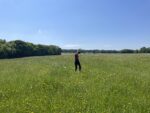



I awoke this morning with a slightly sore head after one too many Ardnamarchan whiskies in a pub on a hilltop in Bristol. Sun blazed through the ‘blackout’ curtains. Bristolians had been anticipating Sun for several days, as we learned when speaking to a friend who runs a small cafe on the Northwest side of the city. There were numerous jokes, practically by everyone who walked in the cafe, about how rarely the Sun appeared and how the summer would be ‘over in three days’. Today my partner and I got a ride to the edge of town and spent the day in Leigh Woods, pointing out sculptural roots and feeling our way through the landscape without much help from maps. I wondered how common the experience of ‘data free’ or ‘no connection’ zones might be in a Sar-linked or One-web future. We hopped a twisted wire fence into a field of high grass and wildflowers to capture a satellite image from NOAA-18. Later, passing by the wide silty banks of the River Avon we stopped to watch small rivulets carving lines into the hillside. Having walked for over four hours we finally arrived back in Clifton Village for a 3:30pm lunch and ordered piles of food. Before the food arrived a middle aged man fainted and nearly fell over while standing next to our table. My partner helped catch him, and while he recovered I remembered my own short-lived phase of fainting in public while standing on street corners in hot, humid Manhattan in the summer of 2011. This was the summer that Hurricane Irene hit New York City and much of Manhattan was evacuated, an eerie precursor to Hurricane Sandy.
2024-05-18 09:51:04
Sasha Engelmann
Hackney Downs, London, United Kingdom
United Kingdom
NOAA-19
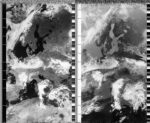


I knew I was out earlier than usual this morning as the fluorescent cones for the children's soccer practice had yet to be distributed across the field, and balls were piled in a corner. The air was grey, and though it wasn't exactly foggy, things felt muted, soft and indistinct. This made me think of Craig Martin's article on fog (one of the first articles I really engaged with in my studies of atmosphere as a young MRes student at Oxford). Fog, for Martin, "is located at the interstices of the incoming and the outgoing: lingering at this juncture, it could be said to determine the immanent connection between body and world" (2011: 456). In other words, fog makes us feel the air as something 'thickening', but in doing so, it demonstrates "a different absorption of time and space" (458), one that counters the 'invisible' and 'transparent' freedom we often associate with air. There is also something resonant between the experience of fog and that of heat. Martin quotes Taussig: "Heat... is a force like color, that sets aside the understanding in place of something less conscious and more overflowing, radiance instead of line, immanence instead of the famous bird's eye view" (Taussig, cited in Martin, 2011: 457). Later in the morning, on a train to Bristol, I decode the satellite image and the cloud-free lakes of Russia come into view once again. I think about the exactness of the image: today it feels full of lines, curves and arcs, land-shapes outlined against the darkness of ocean. Instead I try to feel the 'thickening' of air and fog, and the 'radiance' and 'immanence' of the too-warm land.
2024-05-17 12:22:00
Soph Dyer
Augarten by the flowers, Wien, Austria
Austria
NOAA-18



Dust, grey skies, low light. I am reading over lunch an article on Microsoft's Planetary Computer, shared with me by Sasha. I began reading it during my last hospital appointment, which felt appropriate as, in my experience, hospitals are sites dislocation, dissociation and disorientation (as well as the putting back together of bodies). The authors are arguing for "pluralising the planetary" and recognising its "radical incompleteness"; they are favouring "messy operation(s)" over smooth form (Richardson and Munster, 2023). I message Sasha extracts, so as to not forget them and share resonances. The first reads "a computational enclosure reimagined as liberation".
2024-05-17 10:03:25
Sasha Engelmann
Hackney Downs, London, United Kingdom
United Kingdom
NOAA-19



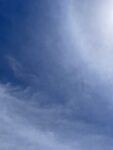

Water and dust: these are the two prominent features in the satellite image I collected today. In the North, Lake Onega and Lake Ladoga are dark prints in the land near the now ice-free Gulf of Bothnia. Northern Europe is unusually cloud-free and seeing these lakes so clearly makes me feel uneasy, as if these waters are 'laid bare' by the sun. Another notable 'body of water' in the satellite image is unmarked on Google maps, but searching further reveals this is the Rybinsk Reservoir built by Russia in 1935. It was the largest man-made body of water at the time of its construction. The reservoir caused 150,000 people to be displaced and over 600 villages were submerged. In contrast, further South, there are other geographies and histories of immersion and displacement. The borders of sea and land are obscured in places by a current of dust making a soft streak from Tunis to the Southern tip of Sicily. News media are alert to this dust in different ways: an online publication called Gloucestershire Live warns readers that a 'scorching' Saharan dust plume is about to 'hit' the UK, and goes so far as to offer advice for how to 'properly clean your car' (hint: 'brushing' is not enough!). In the Swindon Advertiser, Saharan dust will 'sweep' across the UK. Yet in the Metro, these alerts to dust are dismissed with evidence from the Met Office: "their forecasts have no suggestion of a Saharan plume heading our way – good news for our cars which would otherwise end up coated in dust". The car is, once again, the primary surface on which we 'see' dust in European news media, and the object that needs most protection from it. When there are half-hearted gestures to the way dust can affect breathing for 'vulnerable' and 'asthmatic' people, these are rarely gifted the same emotional fervor for protection. There, scattered across the windscreen or front hood, dust speckles and glitters, forming 'galaxies' (as described by Nicola via Soph in an earlier weather note) to be 'properly' and thoroughly removed in the wash.
2024-05-15 21:23:30
Soph Dyer
On the balcony, Wien, Austria
Austria
NOAA-19

Apparenly poets and shopping centre security guards can be assassins too. The media are reporting that there has been an assasination attempt on the incoming Prime Minister of Slovakia. The location is a few hundred kilometres from Vienna. News feeds identify the assassin not by name but by his profession: shopping centre security guard and poet. Poignantly, NOAA-19 passed between Vienna and Bratislava. I am certain that saw the satellite. I had set an alarm on my phone for the satellite pass but when it rang I had just drained a pan of boiled asparagus, so I gave into to hunger and ate dinner. After finishing, I ran outside to catch the second half of the pass. I used the new cable Sasha has sent me. It is a clear night and a gentle temperature. Earlier, I swam in the Danube. It was windy and spray forced my eyes shut. I had the water to myself, save for a swan and passing cyclists and whatever or whoever was lurking below. I dived in a couple of times before almost slipping on the plastic pontoon. Swimming is perhaps the most effective way I deal with pain. I hope today is the last day of my period-related pains and restless nights. My body is aching to begin the slow process of unknotting itself.
2024-05-16 11:34:21
Sasha Engelmann
Hackney Downs, London, United Kingdom
United Kingdom
NOAA-18




Though the sky was bright, a light speckling of rain fell as I walked to the park. A crowd of people was spilling outside the Open Doors Baptist Church. The attire was mostly black, however, so I wondered if there was a funeral or memorial service. I took cover under the canopy of a sycamore tree. In the distance, I could hear the human companion of Muffin Man (a small black terrier) explaining to two women what I was doing. They were pointing in my direction and I caught phrases like "she works for..." and "I see her...". As they were deep in the shadow of the grove of trees and I was on the edge of the shade I felt like I was on display in a lightbox, silently going through motions. They didn't approach. The satellite passed to the East and a large part of the Mediterranean appeared on my screen. I assumed there was sun-glint when I saw some blurriness over the ocean, but later realised there were wisps of dust. Using EumetView and the Dust RGB algorithm I confirmed the dust, which appears in a soft cloud of magenta-pink over Northern Africa, Sicily and the seawater in between. I thought of Aya Nassar's words about dust as an 'unravelling traveller' (2021: 458) and wondered how the dust was moving, circling, shifting in its passage. Through the tools of remote sensing and the algorithms used to 'enhance' what is sensed, the dust felt like another curious moving entity, silently on display.
2024-05-16 12:32:00
Soph Dyer
Augarten, Wien, Austria
Austria
NOAA-18


It didn't record, which was such a shame as the satellite pass was long and a sweet 60 degrees to my West. The weather is here warm, gusty and cloudy. The weather app on my phone says that it'll be cloudy for the next two weeks – I hope not. After reading a news story on how people with freckles are at high risk of skin damage, I purchased a pocket-sized tube of sun cream. I am ready for the sun and now its gone. The Slovakian Prime Minister has survived the attack on his life. The latest reports suggest the gunman is in his 70s. It is likely that he grew up in the Soviet era Czechoslovakia and lived through the 'Gentle Revolution', possibly even the 1968 Prague Spring.
2024-05-15 10:29:49
Sasha Engelmann
Founder's Field, Royal Holloway University of London, United Kingdom
United Kingdom
NOAA-19





In a recent article on 'breathing climate crises', Blanche Verlie and Astrida Neimanis advocate for a move beyond strategies of bodily 'attunement' found widely in the environmental humanities and toward practices of 'conspiratorial witnessing' involving the use of 'proxy stories' as 'amplifiers and sensitisers' of our own attunements (2023: 126). For these authors, microscopes, qualitative interviews and poems might all be "mediating prostheses that open certain experiences for us" (2023: 126). As I stand on a picnic table on the west side of Founders Field at Royal Holloway, I think about the antenna I am holding as a prosethetic. This is not unfamiliar: together with other members of open-weather, Soph and I have written about the relationship of body to satellite (and DIY ground station) as a “subversive prosthetic” (Engelmann et al., 2022). In later writing (Engelmann, 2023), and in dialogue with Soph’s masters dissertation work on the material politics of radio (Dyer 2017), I have tried to understand the relationship of body to antenna (and satellite) not through the lens of the prosethetic but as a mutual 'agitation': an agitation of embodied and sensory weather knowledges, and, in turn, an agitation of the “scientific weather” made accessible through orbiting satellites. When we use technologies to tell 'proxy stories' of weather and climate, how much do we need to account for the way these stories come into friction, creating agitation and heat? How might this agitation, this heat, itself be a site of 'witnessing climate'? Midway through my satellite pass on Founder's Field I manage to ask a second-year undergraduate 'Financial and Business Economics' student to take some documentation photos of me waving the antenna at the sky. He politely keeps from looking amused or bewildered. Walking down from the field through the Royal Holloway woodland, I can't help but notice the swampy waters of the woodland pool and a green-feathered duck asleep at the bank. The woods are buzzing with green life, but they feel far too warm and languid for May. Later in the afternoon at a staff meeting, serious conversations about university finances cause various states of anxiety and worry, and bodies slope in their chairs. I think: how do we witness when things heat up? What is the 'heat' we witness?
2024-05-14 22:49:02
Soph Dyer
On my balcony, Wien, Austria
Austria
NOAA-18




I saw NOAA-18. I tuned off the lights and then, like magic, mid-pass, a white dot appeared almost directly overhead. I could keep eyes on it for several minutes. The satellite glided across the sky, so much faster than I had imagine. It makes sense, that the satellite appears to accelerate when directly overhead and then slow down as it approaches the horizon. Despite this logic, I had always imagined it moving at a constant speed, like the hand of a clock. I am twitching with excitement.
2024-05-14 10:41:48
Sasha Engelmann
Mint Street Park, London, United Kingdom
United Kingdom
NOAA-19





After an early morning appointment near London Bridge I paid homage to a site that hosted one of the first 'satellite seances' of open-weather in August 2019: Mint Street Park. As I set up my ground station next to a large flock of pigeons at the top of the park's terraced mound, I remembered the gathering of people who had participated in a satellite pass and poetry reading (by JR Carpenter) at the same location almost five years ago, as part of a series of gatherings and a reading group called 'Weather or not', led and curated by Arjuna Neumann. Soph and I contributed regularly to the reading group and discussion sessions for several months before open-weather was initiated. Today, the air is far colder and my laptop is speckled with rain. I ask a lone walker to take a photo and he takes fifteen. Later, I am meeting the author and scholar Jean-Thomas Tremblay for coffee in central London. They are visiting London for a conference and it is a rare chance to meet a North American scholar who I admire so much. Tremblay wrote the incredible book Breathing Aesthetics (Duke, 2022) that has circulated widely in the humanities and has inspired entire exhibitions in Canada, and I was asked to review it. The review came out last week. Over coffee, at the end of a conversation about book writing, air scholarship, environmental humanities and 'negative action' (another forthcoming book by Tremblay) I show them the satellite image and ask if they would like to contribute to this weather note. This is a half-typed, half paraphrased record of what Tremblay generously offered: "In the context of the Palestine solidarity movements I am thinking about the lack or absence of the possibility of gatherings for resistance [in London]. I am thinking a lot about denouncement... this has been a bit uncanny to see [here]. When I was in New York City a few weeks ago there was an omnipresence of the performance of politics (in the most generous sense of performance), and I've been looking for it here"
2024-05-13 23:01:31
Soph Dyer
Balcony, Wien, Austria
Austria
NOAA-18


Sun, clouds, and a cool wind. Today is a day of body euphoria. This has become a monthly ritual and one I should get better at celebrating. I am back inside my body and its a wonderous feeling: I have energy and I feel (almost) clear headed. After a long day of work calls, I made it out of the house around 7:45 pm to buy food from the local supermarket before close. On my way home, the sun was low, hidden, except for explosions of gold at the end of every side street. I walked slowly and took in the soothing quality of the light.
2024-05-13 12:10:02
Sasha Engelmann
Hackney Downs, London, United Kingdom
United Kingdom
NOAA-18




I received some bad news last night, and made the mistake of watching a TV show that is a dark, psychological thriller before bed. I dreamed I was in a city under siege and friends were scattered in distant countries. I was trying to send them messages hidden in the frequencies and lyrics of protest songs. A light but deeply gray cloud hangs over London and the park was almost entirely deserted, strange after the way it filled to the brim with people over the weekend. On my walk home I noticed the glossy new leaves of a young horse chestnut tree, and I wondered about its red pigmentation – is it absorbing different wavelengths of light?
2024-05-12 23:13:34
Soph Dyer
My flat, Wien, Austria
Austria
NOAA-18




My hormones have been so low, I have felt dislocated from my body. Come this evening I finally felt a little better. Last night, I was up until 2am watching the Northern Lights or Polarlitchter from a north-facing window in our flat. I was incredibly lucky as I hadn't seen the space weather forecast, but a friend messaged, "Don’t forget there might be polar lights tonight!". At first, I thought that she had misunderstood – we're too far South. Google affirmed my skepticism. Still, it was a clear night so I looked outside. At first, I could see nothing. After around five minutes a bright pink glow appeared behind the rooftops. I completely freaked out. N and I dropped our plans to sleep and ran to a local sports ground. We were both in a state of shock and awe. In my elation called Sasha, texted my family in the UK "Look North!", patronised N for using a flash, and garbled "Danke" to a groundsman who was explaining that we needed to leave as he was locking up. We headed to a local park but the lights had dimmed to a level were I wasn't sure if I could still see them or the pink glow had burned itself into my imagination. Back at home they flared again, this time visible from the flat. N went to bed but I stayed up watching. The pink became almost as vivid as in the long exposure photos I had been taking. White shafts of light appeared and disappeared, so did a fainter green glow. My skin tingles just thinking about it.
2024-05-12 12:23:03
Sasha Engelmann
Hackney Downs, London, United Kingdom
United Kingdom
NOAA-18



I spent an inordinate amount of my waking hours this weekend doing two things: 1) looking for and thinking about the aurora during the unfolding geomagnetic storm that started on Friday, and 2) re-reading Sara Ahmed's book Queer Phenomenology. My head and body are full of orientations. Last night I went out after 11pm to see the northern lights again. After the news media coverage of the G5 storm and the countless magenta-pink photographs on social media, the park was unusually crowded, and I could see people craning their necks to the sky. One person said in the distance: "does anyone see it? Oh come on!" as if urging the ions and Oxygen isotopes to light up on cue. The intensity of the solar storm had decreased and there was less chance of seeing any colour last night. Yet I couldn't help but think more about what was happening to everyone in the middle of their Saturday evenings, standing in a park and peering into the dark, trying to see pink. Ahmed writes, "Seeing such objects as if for the first time... involves wonder, it allows the object to breathe not through a forgetting of its history but by allowing this history to come alive" (2006: 163-164). The bodies in the park were certainly poised for wonder, eager to see the urban night sky 'as if for the first time'. It would be easy to suggest that people were disappointed, but I think something else happened. In the gesture of going out in the dark, waiting and gazing up, and in seeing this gesture repeated by many bodies, I think something did 'come alive'. We faced the same direction, we waited, we produced lines of orientation (and disorientation). While this sounds romantic, I don't think it was; indeed we can question how romantic a gesture of 'looking up' really is when the sky is occluded with light pollution, smog and strings of corporate satellites forming a shell around earth. Instead I think this was about "allowing the oblique to open up another angle on the world" (2016: 172). It was about seeing (and failing to see) something wondrous, something strange and unusual 'coming alive' in the opaque familiarity of the urban night.
2024-05-11 12:36:42
Sasha Engelmann
Hackney Downs, London, United Kingdom
United Kingdom
NOAA-18




A geomagnetic storm reached Earth in the last twenty four hours, creating magenta-pink auroras as far South as Florida. Last night around 10:30pm Soph called me when a bright pink streak appeared over Vienna and I rushed to a window to look North, only to find that there was nothing pink in the sky of London. Heading out to the park, I found a spot in the middle of the largest field, where I normally set up my DIY satellite ground station, and waited. I could hear the club night in full swing at The Star, and I could practically feel the friction of bodies, torn tights and trainers on the sweaty dancefloor. In contrast, the open grass was invitingly dark and cool. A few minutes later I thought I could see a faint pink glow. It grew slowly in intensity. At first I thought I was wishfully imagining it, but suddenly I felt overwhelmed with its vastness and managed to take a photograph. My iphone could see the colour better than me. Like many thousands of other people I dreamed of the aurora last night, and woke up today with its colour fresh in my memory. I wondered what form of collective unconscious we were experiencing, and I remembered Sara Ahmed's words: "We are turned toward things. Such things make an impression on us". Where are we turned when we turn toward the nebulous aurora, collectively? What are its impressions? Another coronal mass ejection is apparently on its way to Earth now, according to space weather scientists. These ejections affect radio: "Radiation from the flare caused a deep shortwave radio blackout over the Pacific Ocean. Ham radio operators and mariners may have noticed loss of signal at frequencies below 30 MHz for as much as an hour after the flare's peak" (Spaceweather.com). The NOAA satellites transmit at 137 Mhz, far from the 'blackout' in the shortwave frequencies, but I still wonder whether transmission could be altered, distorted, even slightly 'agitated' by the spike in charged particles reaching us from our nearest Star. Today during the satellite pass, in the bright sun not far from where I stood last night, three girls passed by some distance away from me, and I could hear one say: 'what is she doing??... is she charging her phone?!' Maybe not my phone, I thought, but I couldn't help wonder if I was charging something else as I pointed my antenna to the solar winds in the sky.
2024-05-10 11:31:05
Sasha Engelmann
Burgess Park, London, United Kingdom
United Kingdom
NOAA-19

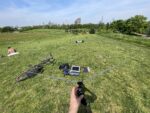
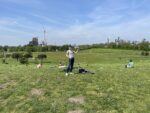
I have been thinking a lot about how atmosphere can gather like a force field around a person, an object, a space, a time. One of my favourite writers of atmosphere Kathleen Stewart, says: 'It was then that I began to think, along with others, that nameable clarities like family or friendship or love or collapse or laughing or telling stories or violence or place are all atmospherics. All forms of attending to what's happening, sensing out, accreting attachments and detachments, differences and indifferences, losses and proliferating possibilities' (2011: 448). This morning I cycled through the uncannily warm, dusty, petrol-infused air of London to Burgess Park, which used to be my local park and the place I captured many satellite images in the early days of open-weather. On the hill in the park I thought about its atmospherics, how my move to Hackney has changed my attachments and detachments to the park's hills, fields, communities and skyline. As if to interrupt my nostalgia, a couple men who had come to lie on the hill started speaking and then fighting. One started laughing at the other, clearly in a way to make him eveny more angry. I rushed to pack up my antenna and rolled down the hill on my bike, noticing that the other hilltop walkers had done the same.
2024-05-10 12:09:30
Soph Dyer
Just off Obere Augartenstraß, Wien, Austria
Austria
NOAA-18


Woke up to Netanyahu's face on the front page of the Guardian. Felt grim despair. Got up, messaged my sister, made a medical appointment, and went to the studio. I received this image on my way in. Veronika, my studio mate, had made spare lunch so we ate together with her collaborator, T. Being cooked food quiets the soul. My hormones at still languishing somewhere at the bottom of the mid Atlantic trench. I feel dreadful. It's a beautifully sunny, clear day.
2024-05-09 11:44:18
Sasha Engelmann
Founder's Field, Royal Holloway University of London, United Kingdom
United Kingdom
NOAA-19



On my walk to the train station at 6:30am, the sun was already warming the park and highlighting its colours. I passed an orchid rockrose that looked eager to be seen, so I stopped and took its portrait. I learned later that rockrose flowers last one day. Later, at the university geography department where I work, I attended a seminar on 'plant humanities' in which someone suggested that plants 'scale time' in nonlinear ways. They hold hours, minutes, and seconds in recursive spirals, cycles and loops. This made me speculate about non-linear plant-weathers. In the orange rays slanting through windows on the train ride home, I wondered if the rockrose was finishing its rotation or defiantly resisting the dimming light, stretching time.
2024-05-08 10:16:19
Sasha Engelmann
Hackney Downs, London, United Kingdom
United Kingdom
NOAA-19




The sun has flooded London these last two days. I use the word 'flood' deliberately as the city feels like it is inundated with light, beyond its own capacity. In central London yesterday on an errand, I noticed people with their eyes closed, standing or lounging on streetcorners. The sun leaks into apartments and buildings through open doors and flung-wide windows. In the park today, I set up my ground station on the south side to feel even more of the sun's rays. Nearby a woman practiced throwing frisbees. A small terrier came running up to me with a growl, but soon softened as I said hello. 'You must be seeing a lot of weather today' the dog's owner said. I didn't know what he meant until he mentioned the thunderous rain on the bank holiday. As we spoke, the dog – who is named 'muffin man' due to an incident with some muffins – cuddled next to me on the grass. As I left I admired the burnet roses and the ladybugs asleep in their leaves.
2024-05-07 17:57:11
Sasha Engelmann
Hackney Downs, London, United Kingdom
United Kingdom
NOAA-15



The solar elevation was only 10.2 degrees as NOAA-15 passed overhead in the early evening today. The chestnut trees, now dense with foliage and pink-white flowers, cast long shadows on the grass. A man and a young woman (I presumed his daughter) walked up behind me, the man asking 'are you in touch with outer space today?' or some variation. I explained the image loading in on the screen, though it was too dark to make out land and sea borders, and I fear it might have looked very abstract to them. As I left the park to do an errand I noted a burst of blue underneath a sycamore tree and identified the plant as 'green alkanet'. Reading later, I learned that the five petalled, deep blue flowers of green alkanet are edible and can be added to salads and drinks. The roots were traditionally used for red dye. And the leaves, though mildly toxic, have various medicinal properties, recommended for treatment of coughs, digestive issues and fevers. When crushed and combined with vinegar and rose water they are also an effective remedy for burns and ulcers. As I walked through the neighbourhood to the grocery store, I noticed how much green alkanet was springing out of cracks in brick, in shady corners and in other uncared-for places.
2024-05-06 19:19:44
Soph Dyer
On the corner of Diepold Park, Wien, Austria
Austria
NOAA-15




Bright sunlight, thunder booms and rain drops the size of marbles. Israel has ordered civilians to leave Rafah, but to where? In Vienna, European Election posters line the larger streets: Patriotisch, Zusammen in Europa, … I will try to collect the slogans.
2024-05-06 10:42:23
Sasha Engelmann
Downs Road, London, United Kingdom
United Kingdom
NOAA-19



The Met Office have issued a 'thunder warning' and a 'wet washout' to the end of the Bank Holiday weekend. One forecaster commented, 'if you manage to avoid showers, then it will be nice in the sun'. The contrast in these comments struck me as I held my antenna out of the flat window to catch the signal of NOAA-19. If sun... then very nice sun! If rain... then thunder and floods.
2024-05-05 19:47:02
Soph Dyer
Reclaimed community garden, Hernals, Wien, Austria
Austria
NOAA-15



First day of summer, first mosquito bite of the 2024, my first ever swim in the Alte Donau (Old Danube). The forecast on my phone predicted rain at 3pm, but the clouds passed us and Veronika, her dog and I enjoyed several hours at the Alte Donau. We made the most of the cooling clear waters before they turn murky with summer algae and river weed. I didn't realise until I got home, how much my face had 'caught the sun'. I received an broken-up transmission from NOAA-15 in a long abandoned building lot, recently commandeered as an unofficial community garden. On the way home, I could see a towering anvil cloud to the South. Tomorrow should be sunny, despite multiple storms in the region.
2024-05-05 10:51:28
Sasha Engelmann
Hackney Downs, London, United Kingdom
United Kingdom
NOAA-19


I returned home from Brighton very late last night after celebrating with a group of close friends, and memories of the beach, the sparklers we lit, the twilight and our group dances are fresh in my memory. The sun feels too bright for these memories! In the satellite image, two swirling cyclones curve over the Atlantic and northern Europe, and I am reminded of the von Kármán vortex streets, or repeated patterns of swirling vortices, described by Esther Leslie in her essay on 'Fog, Froth and Foam': 'stress factors on a curve, the agitation of the air, clouds, the wind...'
2024-05-04 21:54:40
Soph Dyer
On the balcony, Wien, Austria
Austria
NOAA-19


I think I saw NOAA-19! I was looking at the sky at exactly where I imagined NOAA-19 to be, 50 degrees above the horiszon to my West, and there was a faint white dot moving steady across the sky. It's a clear night but there visibility isn't exceptional and the stairwell lights of the neighbouring building kept turning on making it harder to see the stars. Yet, the position and velocity matched those of NOAA-19. I could only track the faint point of light for a few seconds before loosing it. Sasha and I have speculated about what it would be like to 'return the gaze'. I felt that I was locking eyes with an old but elusive friend. I need to think more about this moment and what it means to watch a satellite, watching earth. Watching you, watching me. I was so concentrated that I forgot to take any documentary photo. So, I've uploaded a photo from earlier in the day of me shoving free compost from the city's recycling centre.
2024-05-04 11:04:28
Sasha Engelmann
Hackney Downs, London, United Kingdom
United Kingdom
NOAA-19



This week in London, there have been lightning storms in the middle of the night. My partner woke up one morning earlier in the week with a story of how the sky flashed brightly at 2am in quick successions of electricity with no thunder. I slept through the lightning. The sky today is a deep cerulean blue, so deep and bright it feels charged, amplified. I wondered about the residual effects of lightning: what happens to the electromagnetic pulses of energy, the sferics, that are emitted? How far do they travel around earth, and do they return?
2024-05-03 12:34:52
Sasha Engelmann
Hackney Downs, London, United Kingdom
United Kingdom
NOAA-18




Drops splashed lightly on my laptop as I took cover under a Sycamore tree during the satellite pass today. While the tree mostly sheltered me and my ground station from the rain, periodic wind gusts would shake the leaves and a rain of large droplets would fall down, teaspoons of rain that pooled above. Thankfully, I could always tell when this would happen because of the sound of the upper tree leaves, and only a few splashes managed to reach my keyboard. As I was focused on this, an elderly couple walked by and both smiled at me.
2024-05-03 10:38:36
Soph Dyer
Schillerplatz, Institut für Kunst und Architektur (Institute for Art and Architecture), Akademie der bildenden Künste Wien, Austria
Austria
NOAA-19



This image was received during a workshop with third year architecture students at the Akademie der bildenden Künste. It is raining heavily, however we got lucky with the weather and satellite orbits. During a dry moment between down pours and drizzle, we stood in Schillerplatz and pointed the turnstile antenna toward NOAA-19. For some reason the signal to noise ratio was poor. I will try to understand why, perhaps the dongle I was using has seen one too many workshops. We tried later in the day with v-dipoles and the students got clear images, so, it must have been my set-up. A noisy image can be intersting in a workshop. Overall we had a good day. During the WebSDR exercise the students heard lots of radio amateur chatter, including two men with heavy British accents talking about one of the men's father passing away. Another students heard a man in Germany describing how the Rhine River had flooded his cellar. All in all, it was a very radio active workshop.
2024-05-02 12:07:54
Soph Dyer
On the corner of , Augarten, Wien, Austria
Austria
NOAA-18




It remains windy today. I learned today that the expression "winds of change", which I had taken as old adage, was coined in 1969 by British Prime Minister Harold Macmillan. In a speech in Cape Town, Macmillan referred to the "wind of change […] blowing through this continent", in reference to the decolonisation of Africa. Now I know the expressions origin, I am wary of how it naturalises a social-political struggle, making it feel as inevitable as the changing of weather patterns. I am reminded of a poster I picked up in a corridor in Goldsmiths after the terrible passing of Mark Fisher. Printed in riso red, the poster reads "emancipatory politics must always destroy the appearance of a ‘natural order’, must reveal what is presented as necessary and inevitable to be a mere contingency, just as it must make what was previously deemed to be impossible seem attainable" (Fisher 2009). I see traces of the Polar Jet Stream in the clouds in the satellite image. Or rather jet streams in plural because the more I read the weather and its winds, the more my imagination of a single wind, a kind of wind super highway, breaks down. Instead I see many jet streams: curling and unravelling, breaking up and rejoining, strengthening and weakening. Sasha has shared with me an article on 'global stilling': a prediction that the climate crisis will cause global winds the weaken and possibly, eventually, still.
2024-05-02 08:38:36
Sasha Engelmann
Myddelton Square Gardens, London, United Kingdom
United Kingdom
NOAA-15




Myddelton Square Gardens is the name of a green, flower-filled square on top of a hill in Islington, and in which St Marks Church stands. According to the St Marks website, it is 'a country church in an urban setting'. As I held my V-dipole antenna to the sky, I tried to imagine where I was standing 'as country' without the church or surrounding three-story Victorian buildings. The Thames would probably be glistening in the distance, widening on its way to the sea. Or, given the density of the mist in the morning air, the hill would be shrouded in a small cloud, wrapped up without a view of the horizon.
2024-05-01 19:47:52
Soph Dyer
My flat, Wien, Austria
Austria
NOAA-15

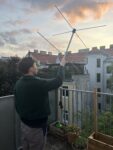
It's 1 May or Workers' Day or Labour Day. It's still novel for me live in a country that celebrates the 1 May with a national holiday and street parties. I cycled into my studio and instantly felt guilty for working, as if I were a 'scab'. Vienna has a festive, carefree atmosphere. I crossed two rallies for the Sozialdemokratische Partei Österreichs (SPÖ) and for the KOMintern at Sigmund-Freud-Park. According to a crude translation of their German-langauge website, the KOMintern is a "combative, internationalist association and trade union fighting alliance of working people, councils, the unemployed and trade union political activists". The weather is sun with some cloud and wind. If I had a barometer, it would have pointed to "Change".
2024-05-01 11:41:15
Sasha Engelmann
Hackney Downs, London, United Kingdom
United Kingdom
NOAA-19




Warmer air has arrived in the UK over the last couple days, and I realised I was overdressed on my way to the park. The grass was still cool and damp to sit on. I wondered about the number of wood shards on the ground before realising how many dogs had been chewing sticks and branches. Two german shepherds chased a ball nearby, and one of them kept lying down not far from me, panting-heaving with his/her whole body. Yet when the ball was thrown again, she went for it. I later met the dog, Akira, when her owner came over to chat. My activities were approved with a 'good on you', and 'we need to know whats going on up there' (hand gesturing to the sky).
2024-04-30 22:25:17
Soph Dyer
Beside the Rathaus, Wien, Austria
Austria
NOAA-18

As I receive the satellite transmission, I listen to pop music from a large concert for the SPÖ youth organisations. To get to the street corner we walk through groups of teens. In the shadows of the park they could have passed as much older, but occasional childish impulse to jostle, shout or run after one other gave them away. I read that each year the socialist youth organisation's march through the city with torches, this year their motto is 'Vienna against the Right' or „Wien gegen Rechts“.
2024-04-30 11:34:06
Sasha Engelmann
Hackney Downs, London, United Kingdom
United Kingdom
NOAA-18


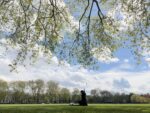


A pair of orange grass cutter machines, like small tractors, circled around Hackney Downs today, carving edges around trees and casting grass perfume into the air. It was sunny and bucolic. Over the weekend I attended a rally in support of Diane Abbott that took place at the centrepoint of the park, in similarly beautiful weather. As a new resident of Hackney (since last October) I didn't know much about Diane Abbott's story, how she was the first black woman elected to the UK parliament, but also how she faced so much overt discrimination and agression while an MP. Several speakers at the rally mentioned Diane's record of standing up in Parliament advocating for the rights of working people and communities, but also how she was frequently shut down or attacked. I also didn't know that in 2023, due to an article she wrote, Diane's 'whip' was removed, effectively suspending her from the Labour Party. As a foreigner in the UK, the idea of a 'whip' is a strange one, and I read that it comes from language around hunting, where a 'whip' keeps hounds from running off the path. Despite all of this, the atmosphere at Diane's rally was exuberant and energetic, with rousing chants of 'We stand with Diane!!!' echoing to all corners of the park. As I meditated on this and received a satellite image, Martin came riding over again. After I shared that I had been comically trying to take photos of myself by propping my phone up in a nearby bank of grass and running to my ground station to pose, he helpfully took some photos of me (thank you Martin!). The satellite image was made by live decoding with SDR++ and an RTL-SDR V3 dongle (sadly I tried the V4 again and there was no signal at all). The troubleshooting continues...
2024-04-29 21:16:51
Soph Dyer
Diepoldplatz, Wien, Austria
Austria
NOAA-19


2024-04-29 18:02:25
Sasha Engelmann
Hackney Downs, London, United Kingdom
United Kingdom
NOAA-15

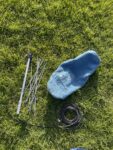
Hackney Downs was golden in the late afternoon light, dogs frolicking and wrestling with each other across the grass. I had chosen a place for my ground station in the thicket of the action. A woman kept yelling for 'Eric!!!' though she didn't seem worried, it was more of a 'come on!' kind of yell. Eric turned out to be a small bulldog who paid zero attention to the calling of his name as he stole tennis balls from other dogs. The satellite image I collected was unusually dark- I wondered whether this could be because of 'night time' mode, or because I am live-decoding with SDR ++ for only the second time and some settings are off.
2024-04-28 19:26:34
Soph Dyer
On my balcony, Wien, Austria
Austria
NOAA-15



Sun. I sat in the sun and willed my vitamin D level to rise. I have been feeling under the weather since Friday and blame it on a lack of vitamin D. After sunset the temperature dropped quickly, then stabilised. N and I sat on the balcony without the lights off and watched the stars for a good hour. Bored from bring at home all day resting for the day, I used the broken co-ax cable, magnet wire from Shortwave Collective and some copper tape to improvise a full wave length v-dipole antenna. I can't find any documentation online of full wavelengt v-dipoles to receive NOAA POES satellites, so maybe it is not a good design. I recived a faint, noisy signal from NOAA-15. Perhaps the poor signal was because I had accidentally cut the dipole wire 30cm too short or becasue the balcony didn't allow for a true North-South orientation. Regardless, the anntena was satisfyingly sculptural.
2024-04-28 12:01:18
Sasha Engelmann
Hackney Downs, London, United Kingdom
United Kingdom
NOAA-18




The air of Hackney Downs was wet – sparkling with water – and though it wasn't exactly raining, droplets fell on my body, antenna and laptop. After so many days attempting to record satellite passes during hail, drizzle and rain in Hackney Downs this last month, I wondered if a tree could serve as a tempoorary ground station holder and shelter. A Montpellier Maple tree was close by, bright red, winged seeds were clustered along its branches. My antenna was too heavy for its branches but I observed how the branches and leaves were porous to the radio signal of NOAA-18 to the east.
2024-04-27 23:04:59
Soph Dyer
At home, Wien, Austria
Austria
NOAA-18

2024-04-27 12:13:44
Sasha Engelmann
Beach of the River Thames near Trig Lane Stairs, London, United Kingdom
United Kingdom
NOAA-18





I arrived at the beach of the River Thames shortly after low tide. The curve of stony beach accessible from Trig Lane Stairs was criss crossed by mudlarkers who hardly noticed me as they bent to the ground and turned over pebbles and pieces of seashell. Arriving at the beach straight from a symposium at the Tate, my head was filled with dialogue about sirens, alarms and states of emergence / emergency. The radio spectrum had its own sirens. Around every two minutes or so, the relatively calm 'ocean' of spectrum in which I tuned my ground station was interrupted by what I can only describe as 'blasts' of energy that drowned out all other signals. The blasts would disappear, allowing a minute or two of calm, before returning. I tried to discern whether they coincided with the Uber Boats traveling up and down the Thames. A mudlarker passerby – who turned out to be an art history professor at a university in London – speculated on this wtih me for a few minutes. As I took a final few photos of my ground station the tide was already beginning to come back in.
2024-04-26 20:17:23
Soph Dyer
At home, Wien, Austria
Austria
NOAA-15


2024-04-26 12:22:18
Sasha Engelmann
Hackney Downs, London, United Kingdom
United Kingdom
NOAA-18



My ground station was visited by a number of dogs. At one point there was a big husky, a german shepherd, two small terriers and a middle sized dog circling and moving through the radio wires and narrowly overstepping my laptop- a dog seance! They arrived with three people who had come over to see what I was doing. Two people I recognised before (they immediately identified the 'weather satellite') plus a woman I hadn't met. While the dogs carreened about, and the others continued walking, the two of us spoke briefly about environmental science and education. One of the smaller terriers came to sit next to us, as if to get some shelter from the german shepherd, and the three of us watched the image load together as the satellite orbited south over France and Spain.
2024-04-25 12:35:37
Sasha Engelmann
Hackney Downs, London, United Kingdom
United Kingdom
NOAA-18



I arrived on the grass with ideas for an evolving piece of writing spinning in my head. I made a mental post-it board and logged some ideas for the last few sentences of the collaborative essay I was working on. Crows were pacing around on the Downs, maybe making mental notes of their own. One passed close by my ground station and I thought I picked up on a sense of curiosity in my actions. A very large husky, looking strikingly similar to a wolf, charged several of the crows and was only kept from my ground station by a very long tether.
2024-04-25 10:36:33
Soph Dyer
On my balcony, Wien, Austria
Austria
NOAA-19




Sehr geehrte W, Ich habe im Januar dieses Jahres eine QFH-Antenne und zwei Zwischenkabel bei Ihnen bestellt.
Ich fürchte, dass ich einige Probleme hatte. Ich habe ein schlechtes SNR bei Verwendung des QFH und eines der Zwischenkabel ist kaputt.
Ich befürchte, dass ich möglicherweise die internen Lötverbindungen an der QFH-Antenne gebrochen habe, obwohl ich nicht glaube, dass sich die Buchsen im Kunststoffteil verdrehen. Haben Sie einen Rat? Wie kann man beispielsweise das Problem eingrenzen?
Sasha Engelmann und ich nutzen Ihre Antennen schon seit vielen Jahren und hatten vorher keine Probleme. Vielen Dank für jede Hilfe.
Mit freundlichen Grüßen, Sophie Dyer
2024-04-24 18:32:05
Sasha Engelmann
Shoreditch Park, London, United Kingdom
United Kingdom
NOAA-15




I arrived in Shoreditch Park after meeting a friend for a coffee on the Strand. It was very cold but people were lounging on the grass and strolling around the park making every effort to enjoy a semi-sunny early evening. The 'radio weather' was very active. The amplitude of the signal jumped around wildly, and the waterfall display was checkered and criss-crossed by lines of radiation. I belatedly took a screenshot to record this, but only after I had unplugged my antenna so it is not as representative as I hoped. I wondered about very tall, black streetlights installed throughout the park that looked like they had cameras or other attachments on them. The signal of NOAA-15 would jump into audibility for one or two seconds and then get swallowed up by interference, even at the height of the pass.
2024-04-24 19:27:05
Soph Dyer
Augarten, Wien, Austria
Austria
NOAA-15



Athens is enveloped in Saharan dust, but it remains so cold here! On Friday it is forecast to drop as low as 1C degrees. An Austrian friend told me that it has snowed nearer the Alps, harming the fruits trees, which had budded early and were already in full leaf. On an emotional level the cold and damp is making me want to curl up and stay away from more energetic tasks, such as work and exercise. I checked 'wind map' to improve understanding hoping that this would bring me comfort. The slick data visualisation shows cold air coming from the artic, passing Sasha in London, before arriving in Southern and Central Europe. Sasha are you cold?
2024-04-23 20:52:44
Soph Dyer
Lorenz-Bayer-Park, Wien, Austria
Austria
NOAA-19

The software defined radio app I was running on my phone crashed as two teenage boys walked right up to N and I and got in our faces. I was a wary. "I'm from Tschetschenien (Chechnya)" one of the boys said. When I told them that I was from the UK, they proceeded to speak in awe about how "you know in London you get stabbed, just like that". When I said that we had lived in South East London they were unduly impressed. The boys willingness to come into our personal space made some sense when they told us that they were on drugs. I asked what and they said cocaine and then, as if to prove it, did a line in front of us on the picnic table. We chatted, I tried to restart the software defined radio and recorded this image (the first recording had corrupted), they offered us a cigarette. The satellite dipped below the horizon. We wished each other "Schön'n Abend", and N and I left the two boys in the darkness of the park.
2024-04-23 12:58:47
Sasha Engelmann
Hackney Downs, London, United Kingdom
United Kingdom
NOAA-18


Today is one of those typical days in London where, from the inside, it looks like it is raining outside, but once you are outside you can tell that it's just a wet mist that has made all the surfaces shine with water. The park was relatively empty except for a few people dressed in coats and dogs dressed in little jackets and gillets. The clouds overhead seemed to match the weather systems swirling over the Atlantic, making dense white and off-white shapes.
2024-04-22 22:21:27
Soph Dyer
Hanging out of my window, Wien, Austria
Austria
NOAA-18


Clear skies, still cold. I am tired yet relaxed. It is a long day. In the afternoon and evening I helped to remotely interview applicants for the design school where I teach. Every 15 minutes a student joined the call from a different location: Moscow, Guangzhou, a city I can't recall in Canada, then maybe Barcelona, Offenbach in Germany, a few streets away from me in Vienna, the list went on. Our questions were a variation of: why this course now? The answers overlapped, but the reasons for studying and urgencies were diverse, so too were the concerns about visas, queerness or work after graduation. About half of the candidates expressed a desire to develop a personal creative practice while the others leant toward collaborative or collective work. It is exciting to hear so many desires in one day.
2024-04-22 13:11:32
Sasha Engelmann
Hackney Downs, London, United Kingdom
United Kingdom
NOAA-18



On my walk to the park today I noticed the blooming branches of an eastern redbud tree, and I learned about how eastern redbuds are in fact closely related to legumes. This made sense as the flowers resembled those of sweet peas. The pass was cold and grey, though a man kept riding back and forth on the nearby path singing to himself, which made everything a little more joyful.
2024-04-21 11:44:23
Sasha Engelmann
Hackney Downs, London, United Kingdom
United Kingdom
NOAA-18


Kites flew high in the park today, though the variable wind meant that they often crashed and needed re-launching. The grass has erupted in daisies recently, making white speckles across the ground. Yesterday I went to a local action for Palestine: a rally and march that began at Gillet Square and stopped traffic on Kingsland Road before turning down Dalston Lane and ending at the Hackney Picturehouse (the Rio Cinema and Hackney Picturehouse were chosen as start / end points as they have cancelled/ boycotted events in solidarity with Palestinian artists and people). I find local marches like this extremely moving, in some ways more so than the national protests attended by hundreds of thousands in central London (there is one of these next weekend). Yesterday the march ended with a speech by one of the organisers of Palestine Solidarity UK, about how we need to keep showing up in public spaces, especially as London remains an active site of public protest unlike other cities in Europe. Despite the strength of these local actions, I sense a growing despair and raggedness in the protests, a myriad of ways to conceal feelings of despair.
2024-04-20 10:34:06
Sasha Engelmann
Hackney Downs, London, United Kingdom
United Kingdom
NOAA-19



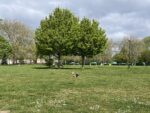
On the far side of the park close to the basketball courts I found myself surrounded by daisies. My head ached from a late night out with old friends, but I felt relaxed and happy to be in the air. The pass was a very social one- two joggers came over to me and inquired about what I was doing. They kept jogging in place for our whole conversation. Bill and Nutmeg appeared, and I learned about an app that notifies you whenever scientists detect gravitational waves- gravitational wave weather? A man on a bike, trailed by two kids, asked one question as he glided past. Finally I was visited by a small terrier who stared longingly at an older woman as she walked away over the field. She called to him but he would not follow her, and she kept going. Instead he came over to me and sat in the middle of my ground station for a couple minutes before bounding over to another dog.
2024-04-19 12:08:53
Sasha Engelmann
Hackney Downs, London, United Kingdom
United Kingdom
NOAA-18


I forgot to bring an umbrella on my way to the park today, and yet again had to use my body as a shield for my laptop when light rain started. I have been testing the water damage boundaries of my computer during satellite passes recently. As I was packing up two young men and a large curly haired dog approached and we chatted for a few minutes about how often and frequently the NOAA satellites orbit. I showed them the satellite image on my droplet-speckled screen and one said 'I am so glad I asked!'
2024-04-18 12:20:59
Sasha Engelmann
Hackney Downs, London, United Kingdom
United Kingdom
NOAA-18



Positioned in the middle of the freshly cut East field of Hackney Downs in full sun I felt like a planet with its own orbiting moon(s) and gravitational fields. Dogs – like asteroids or meteors – approached and veered away in long and fast trajectories. I studied my position and made sure to look in all directions. On my way back from the downs I passed a young, 4 foot high horse chestnut tree that I hadn't properly observed before. The tree is ringed by a small cage on which there are handwritten notes to 'Dad' and 'grandpa'.
2024-04-17 12:35:19
Sasha Engelmann
Hackney Downs, London, United Kingdom
United Kingdom
NOAA-18
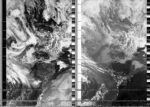


The horse chestnuts are beginning to bloom, and their leaf foliage is now so dense that they cast deep, dark shadows on the grass of the downs. There is a big difference between standing in the sun on exposed grass and standing under a horse chestnut, in its cool shadow. A small, large-eared welsh corgi bounded over to me during the satellite pass, telling me I shouldn't be there. In the long grass the dog had to leap through the green, challenging for short legs.
2024-04-17 13:33:12
Soph Dyer
In the car park Hotel Mariënhage, Eindhoven, The Netherlands
The Netherlands
NOAA-18

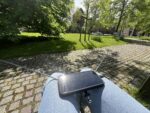
I caught the image between bursts of rain. Drowsy after the night train from Vienna, I enjoy catching rays in the hotel car park. The air is moist and fresh. The clouds few but ripe. Tomorrow my experimental and sometimes unwieldy Critical Cartographies course at Design Academy Eindhoven ends. I'm excited to see the students work, its always energising and surprising. Hopefully they've enjoyed the experience as much as me.
2024-04-16 12:46:32
Sasha Engelmann
Hackney Downs, London, United Kingdom
United Kingdom
NOAA-18

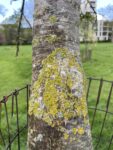

The image I collected was crafted in between sudden downpours of hail! The first time the hail started, I crouched over my laptop and used my body as a quasi-umbrella, and it passed in about a minute. A break of three to four minutes gave me time to recover. In this gap, a young person jogged over from under a nearby tree to me to ask what I was doing. I started to explain by saying 'there is a weather satellite...' but as soon as I said 'weather satellite' he interrrupted me saying, 'oh yeah, I know it, I seen it, I seen it...' and he jogged back to his friends, repeating to them 'it's a weather satellite, I seen it'. Then the second downpour of hail arrived. This time I worried it was here to stay, so I quickly shut things down and got back inside, chunks of ice still in my hair!
2024-04-16 12:08:18
Soph Dyer
Local park, Wien, Austria
Austria
NOAA-18


Can relief be an atmosphere? If so, it is enveloping me. I finally managed to speak to someone who would about my health insurance problem. I think that an end could be insight. It is dry but the clouds are low and the temperature has dropped significantly, again. These days I am alternating between shorts and tee shirts and a heavy winter coat.
2024-04-15 22:08:13
Soph Dyer
Hanging out of my window, Wien, Austria
Austria
NOAA-18


A sunny morning was followed by heavy rain in the late afternoon. At one point, I opened the window facing onto the street and smelled cut grass, which is strange as there are no parks nearby. Before leaving the flat to attend a fundraising meeting, I check the weather radar on my phone and see two large bands of rain almost upon Vienna. Geopolitics is even stormy today. Israel is threatening retaliation against Iran, and stories of dissidents being silenced in Russia and Belarus are in the news. Meanwhile, here, Austria is keeling over to the right. Today, I also learned that abortion is still illegal in Germany.
2024-04-15 12:58:25
Sasha Engelmann
Hackney Downs, London, United Kingdom
United Kingdom
NOAA-18

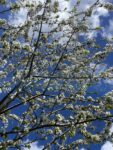

The wind roared in Hackney Downs today. I tried to figure out what the 'roar' consisted of – was it the cumulative effect of all the tree branches and leaves moving against each other? the city-wide friction of wind around buildings, streets and train lines? the scaled-up whoosh of the air across the grass? dog walkers threw sticks into the wind. They sailed high up and were pushed back to where they were released, the dogs doing circles, looking frenzied
2024-04-14 11:30:08
Sasha Engelmann
Hackney Downs, London, United Kingdom
United Kingdom
NOAA-18



Somewhat hidden amongst some young trees and tall grass, and dazed by the bright sun, I heard a joyful 'hello!'. Bill and Nutmeg were walking over. We spoke for a few minutes while the satellite pass began. Bill had looked at the open-weather website, watched our talk at Sonic Acts, and then shared the project with his colleagues (Bill is a train driver). This was amazing to hear- I had never imagined that people I met in the park would take enough interest to follow the project online (I am learning fast about the social life of the Downs). Bill said he liked to think about how, while trains are moving over the ground in our daily lives, satellites are circling and sending signals overhead. The point of his story was to tell me that he had 'stood up for me'. Some of his colleagues are skeptical about feminism.
2024-04-13 11:42:23
Sasha Engelmann
Saint Paul's Church Garden and Labyrinth, United Kingdom
United Kingdom
NOAA-18




The Stoke Newington Farmers Market was at peak activity in the courtyard of Saint Paul's Church while I set up my ground station on the edge of the garden labyrinth. I could smell the Turkish gözleme being cooked on the large round stone, and an herb that I imagined was wild garlic. A man dressed in black with a thick-wheeled, heavy duty electric bike scowled at me from the distance. Another man sat down on a bench near the wall behind me and when I looked around and smiled he exclaimed 'technology!'. That one word hung in the air as I held my antenna to the horizon.
2024-04-12 11:57:27
Sasha Engelmann
Hackney Downs, London, United Kingdom
United Kingdom
NOAA-18


The satellite image I captured today has so many striking details. There are clouds formed by orographic lift off the coast of Scotland – they look like short stripes or patterns, what are called 'gravity waves' in fluids. What I thought were ship's tracks yesterday, today look like contrails from airplanes criss-crossing France, the UK and the North Atlantic. The Alps are strikingly visible in the full sun and against the too-hot land of central Europe.
2024-04-11 10:07:28
Sasha Engelmann
Hackney Downs, London, United Kingdom
United Kingdom
NOAA-18


The sky feels heavy and low to the ground, and the atmosphere suspended, a bit surreal. There is a strange calm. We feel sleepy and low in energy. It is kind of warm and humid but it won't rain – this is where 'suspension' comes from, there won't be a release. In the satellite image, we notice the sharp intersecting lines of ships' tracks across the North Atlantic caused by aerosols released from the ships' exhaust. This morning, when we looked at iPhone weather app, the app said we are 'seven degrees above the historical average' for this time of year.
2024-04-11 10:04:37
Soph Dyer
Resting on the grass, Augarten, Wien, Austria
Austria
NOAA-19
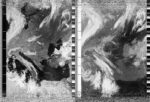

Israel-Palestine, Gulf of Suez, Cairo. Each image yeilds a different combination of landforms, coastlines, rivers and seas by which to orientate by. In land, light and dark patches index dry steppes and deserts, river basins thick with vegetation and cities. I did not capture an image yesterday because I was feeling worn down. In the morning, I had another emergency appointment to diagnose my chronic pain. To express my anger and dispair, I wrote a poem. I am submitting this word-image in place of yesterday's image: 'Try this' It's not an emergency the doctor concluded. / I become so submissive during medical appointments, it was / only when I left the hospital, and / lost another night's sleep to pain, that / I felt like crying and shouting. / Try living with this pain? / Try working after lying awake for multiple nights because / you cannot sleep because / the pain is gnawing at your insides. / Try living with this pain / for more than five years and being told by medical professionals (who you naively assumed would help) / that it is stress, / indigestion, / "your body is changing as you age", / "I have reassured Ms Dyer that the pain is nothing to worry about." / Try living with this pain and repeating those claims. / Screw your lack of emergency. / The discharge note I was sent home with yesterday said I had / blood in my "Douglas Pouch" and advised an operation / using a "DiVinci robot". / How fitting that my body part is named after a man / and the machine that will be used to to probe, cut, mince, remove the my offending flesh is named after a 'male genius'. / Try weathering this climate of sexism. / Try weathering a climate of sexism / in which women's health issues such as endometriosis are still so poorly researched and understood. / Try living with this pain, / then tell me that this not an emergency.
2024-04-10 11:00:03
Sasha Engelmann
Hackney Downs, London, United Kingdom
United Kingdom
NOAA-19


Today my heart is racing and my chest feels tense. I have been in a sprint toward several deadlines. I have several chapters and many thousands more words to review of collaborators' and students' writing today, and every minute counts. Sitting in the grass of the downs was a welcome respite, at first, until a dog fight broke out nearby. One dog owner tackled his dog to the ground, and began agressively yelling and hitting the dog in front of several other dogs and people. An older woman with a terrier tried to intervene to say he should stop hitting his dog, but he yelled at her and she walked off. In the aftermath, the owner of the dog who had been attacked remained, and said to the one who had been violent, 'I would have done the same... everyone knows you here, mate'.
2024-04-09 12:36:32
Sasha Engelmann
Downs Road, London, United Kingdom
United Kingdom
NOAA-18





As a bulb of fennel sizzled in olive oil on the stove, I leaned outside the second floor window of our flat, angling my turnstile antenna at around seventy degrees to the West. It didn't feel that long ago that doing so would have made me shiver with cold, but today I reached out the window withoat a coat or gloves. The air helped to soothe a splitting headache I developed from staring too hard at my computer screen this morning. The pain also made my perceptions fuzzy – a slight 'shimmer' in my peripheral vision.
2024-04-08 12:45:57
Sasha Engelmann
Hackney Downs, London, United Kingdom
United Kingdom
NOAA-18


Sun has been shining through the shutters of our south-facing flat's windows all morning, making ladder-like spotlights on the wood floor. The park was full of dogs and people: a body builder lifting what looked from afar like a giant, square piece of concrete, as if pulled up out of a London sidewalk; a young couple submerged and entangled in the grass; an office-attire wearing woman who spoke loudly to herself and a smartphone. The air smelled faintly of lemons and coffee.
2024-04-07 11:36:53
Sasha Engelmann
Hackney Downs, London, United Kingdom
United Kingdom
NOAA-19



Writing of the atmospheres of the South Asian monsoon, Harshavardhan Bhat describes how the wind 'carries the ocean to the sky... transforming its air and everything in its temporal wake with the possibility of life' (2021: 6). Though monsoons do not occur in the North Atlantic, the aftermath of Storm Kathleen makes me think of the wind 'carrying the ocean to the sky'. The clouds feel like wave crests in fast-moving currents, spinning away from the weakening epicentre of the cyclone. In the park, as I was hurrying to set up under fast-moving clouds, a man and his dog asked what I was doing. After my reply, he said with more than a hint of humour, 'I wonder why I didn't wake up and think of doing that today'
2024-04-06 13:10:09
Sasha Engelmann
Hackney Downs, London, United Kingdom
United Kingdom
NOAA-18


Across Europe the air is unusually warm and skies are cloudy and hazy today, but the atmosphere in London is bucolic, with picnickers spread out over the grass of Hackney Downs. I spotted an incredibly beautiful bird in the garden, I suspect a kind of Jay with very striking blue array of feathers on its wings. In my satellite image, Storm Kathleen swirls in a dramatic line over the Atlantic, and I wonder how it can be so un-stormy in London. According to one online news article, Ellie Glaisyer, a Met Office meteorologist, says: “The storm [Kathleen] is the reason we are seeing the warmer temperatures, because the location of the storm – situated out towards the west – is bringing a southerly wind across the UK.”
2024-04-05 11:42:53
Sasha Engelmann
Clapton Pond, London, United Kingdom
United Kingdom
NOAA-18



I have been thinking all morning about the wind, so I was particularly attuned to the creaks and murmurs of the wind around our flat and street this morning. The wind in my thoughts, though, was different to the one chasing clouds across the sky of London in big gusts. Instead, I was tracing my family's memories of the 'Jugo', a wind that originates in the South over Africa, and blows over North Africa and the Mediterranean. Once it reaches the Balkans, the Jugo has picked up many particles and water droplets along the way. In my family's lore, shared across many in the Balkans and former 'Jugo-slavic' peoples, the Jugo brings certain feelings and emotions to the foreground. Yet unlike the Bora, a brisk, cold wind from the Northeast, very little has been written about the Jugo's cultural value, its meanings, and how it maps onto ideas of 'the south' in ways that need attention and critique.
2024-04-04 10:29:25
Sasha Engelmann
Hackney Downs, London, United Kingdom
United Kingdom
NOAA-19


I felt happy to be back on the grass of Hackney Downs setting up my turnstile antenna this morning. After so many satellite passes in this location, I know the heights and depths of the park and its surrounding buildings like a favourite dreamscape. People in the park found me familiar, too. I man on a racing bike cycled over on the grass, and immediately recognised my Funcube Dongle, saying he had the same, as well as a full amateur radio license. We compared approaches to satellites and ADSB, I told him about open-weather, and he said this encounter had inspired him to break out his dongle again. A few minutes later, Bill and his dog Nutmeg came strolling over. Apparently Bill had been talking about me to his friends on the other side of the park, explaining what I was doing, and he approached to take a look at my image, while Nutmeg raced after a tennis ball. It was a good day to share the image, which was a long view of Europe and much of North Africa. Chott Melhrir lake is visible in Algeria, standing out as a dark spot against the lighter hues of Land. I read that this kind of lake, one characterised by Chott geology, is usually dry, but fills with water at certain times of the year. I want to keep a lookout for the lake in the coming months as it dries and most likely becomes crystelline and reflective with salt.
2024-04-03 10:42:32
Sasha Engelmann
London Bridge, over the River Thames, London, United Kingdom
United Kingdom
NOAA-19
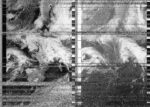


I found myself near London Bridge after an appointment at Guy's Hospital early this morning, a meeting with a specialist doctor which had me thinking a lot about the energy flows through and out of my body. Cycling out to the middle of London Bridge involved ducking and weaving through throngs of tourists and families who, despite the grey and blustery weather, were determinedly taking group photos and pointing at London landmarks. I had to hold my laptop with one hand and orient the antenna with the other, as gusts of wind wobbled both laptop and antenna dangerously close to the edge of the bridge's railing. Passing by my ground station and curiously observing my antenna, a young boy said 'Dad, what is she doing' and was answered with a flat 'dunno.. tracking something'.
2024-04-03 08:43:01
Soph Dyer
Rossauer Brücke, Wien, Austria
Austria
NOAA-15


It is beautifully clear and sunny. I woke early feeling rested after a good swim in the Stadthallenbad last night, which surely helped rid my body of stress hormones. This morning, I stopped on a bridge on the way into the studio to receive an image from NOAA-15. I've noticed that its imagery appears degraded, less detailed, compared to the other two satellites. At this time of day, the sunlight bounces off the Mediterranean, Aegean and Black Seas creating a white flare around the the coastline of Crete and other Greek islands. No Saharan Dust was visible in the image, just two large anticyclonic clouds.
2024-04-02 09:10:37
Soph Dyer
Dornerplatz, Wien, Austria
Austria
NOAA-15


It rained all night. Not "blood rain" coloured by Saharn Dust, normal rain. I sat on a bench in Dornerplatz and received the satellite image in the sun and wind. The sky is a true blue this morning. Seeing it made me realise how grey and brown it has been the last couple of days. It's amazing how quickly one can forget the colour of the sky, and then be shocked by its rediscovery. In The Memory Police by Japanese author Yōko Ogawa, a community living under a phantasmagorical authoritian leader slowly forget the existance of mundane things: hat, ribbon, bird, rose. These things disappear in the night. Once they are gone they no longer have meaning. In the community, forgetting is policed and takes three stages (1) the erasure of the thing (2) the erasure of the memory of the thing (3) the erasure of the memory of the memory of the thing. The news this morning is all about the war in Ukraine and the war in Palestine, and how Israel had killed Iranian Military Commanders in Syria. Iran has sworn to take punitive action against the United States. [Interval] Three people close to me messaged today to say that someone they knew had died. I have sent my condolences, even thought this never feels enough. Today, has grown into a day marked by learning of the passing of people who I will never know. I am writing this down as a minor act of recognition and remembrance.
2024-04-01 19:19:06
Soph Dyer
Ferienhaus Post Sozial, Wien, Austria
Austria
NOAA-15


A cold wind cuts through my flimsy Uniqlo jacket, making me shiver during the satellite pass. Only three hours earlier, I'd been sat on our balcony in shorts and a cut-off tee-shirt, reading Lucy Sabin and Jorge Olcina Cantos' article 'Weathering Saharan dust beyond the Spanish Mediterranean Basin: An interdisciplinary dialogue'. In it, they paraphrase Michael Marder writing that "to face dust is to face not the Other, but the self" (Marder, 2016: 6) Taken out of context, for me, there is something liberating in the idea that we can change state, transmutate, to the extent that we are unrecognisablle, even to ourselves. Back in inside the flat, a change in the soundscape of the street alerts to the rain. Perhaps a interin "cold drop" or the end of the dust weather. N and I take the opportunity to return to the balcony in raincoats and, under the cover of darkness, throw fists fulls of flower seeds into the empty lot next door. Last year, when the old building that had to occupied the lot was being torn down, angry, I had bought online two litres of wildflower seeds. Now we were completing the plan. The seeds rained down, hopefully accomopanied by nutrient rich Saharan Dust.
2024-03-31 12:04:22
Soph Dyer
Asperleiten (favourite place), Wienerwald, Austria
Austria
NOAA-18



We went seeking satellites and Saharan Dust. Last night, I discovered the chrome mudguards of my bicycle patterned with rust coloured droplets. N said that they look like small galaxies. Now we are walking to my favourite tree-lined field in the Wienerwald (Vienna Woods). The light levels have increased, but even when the sun is out there is a thick haze. On reaching the field, I slip on a golden vest, clip belt and tool pouch. The beautifully gender neutralising astronaut-athleisure 'look' is intended to disrupt the documentary style photos we are about to take. Stood in the centre of the field among tubular Cowslip flowers, I scan the Northern horizon with the antenna while N snaps away on my iPhone. I almost forget to adjust the antenna's Gain. When I do, NOAA-18 appears. We spend the next 10 minutes enacting a satellite hunt, much to the confusion of a couple who walk past twice with two yapping lap dogs. The results of the very real satellite hunt photoshoot are great. To have spotted the iron and mineral-rich Dust cloud in imagery two days ago, and to now be immersed in it, to be experiencing it as 'weather', is uncanny. The walk to the bus home is longer and sweatier than I expected. A warm wind is being drawn North, and presumably with it the dust – a billion small crystalline galaxies.
2024-03-31 10:38:31
Sasha Engelmann
Via Giovanni da Udine, Latisana, Italy
Italy
NOAA-19


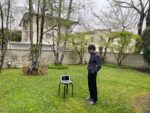
My satellite pass happened in the midst of preparations for 'pranzo di pasqua', and I could year the operations of the kitchen continuing as I set up my ground station and orientated myself in the garden. After driving directly into the saharan dust plume seen on my satellite image yesterday, and spending the night with family in Friuli, I wasn't surprised that the air was still hazy, and the clouds an obscure matte grey. There had been red spot patterns on vehicles and other stationary metal surfaces when we woke up this morning. Later in the day, while on a walk along the Tagliamento river, my throat and eyes felt the dust. As I got ready for bed, a 'tempesta' broke, causing a downfall of rain that my italian hosts called a water 'bomb', a new coloquial term for an extreme, unpredictable and heavy rain.
2024-03-30 11:19:06
Sasha Engelmann
Playground at the Area di Servizio, Novara Sud, Italy
Italy
NOAA-18



Continuing our road trip, we descended from Courmayeur through the Vallee d'Aosta and around mid-morning were surrounded by a thick, matte grey haze just north of Novara, en route to Milan. As a satellite pass was imminent we decided to stop at an 'area di servizio' and take a short break. The AdS turned out to be crowded with trucks (one with a banner reading HOPTRANS) and cars, so the only place to set up the ground station was in a tiny children's playground called PlayLand, ringed with a fence. As the image loaded it showed a promiment veil of dust crossing the Mediterranean and completely covering Italy. Later as we were driving further east, we noticed that rain drops made small red marks on the windscreen.
2024-03-30 11:17:58
Soph Dyer
Diepoldpark, Wien, Austria
Austria
NOAA-18

Why is it that I am so low energy? The sunlight that has made it through the dense semicircle-shaped cloud over Vienna is dim and omnidirectional. It's warm and humid. I woke early and could not fall back asleep. I had hoped to begin the day clear headed, ready to write. Yesterday, after uploading my satellite recording to this archive, I noticed a large plume of Saharan Dust over the Mediterranean. I wrote to Sasha who relied saying that she had not spotted the cloud in her imagery had observed a "light sprinkling" of a reddish dust on the snow. We share an interest in the ways satellite imagery is, “drawn to the dust, the particulate, which it has itself apparently become.” (Leslie, 2021: 102). I want to get better at reading particles, not just pixels.
2024-03-29 11:28:18
Soph Dyer
Usual spot, Augarten, Austria
Austria
NOAA-18

It feels like the first day of spring, again. It is windy but sunny, warm and dry. I sit on the stone flowerbed in the park and receive a long image with the satellite just under 70 degrees to my West. Stupidly, knowing that we had to get up early this morning to view two flats, I worked late last night and then doom scrolled the Internet. Now, I am tried and annoyed with myself. I have been feeling unsettle for multiple days now, I hope this feeling passes. This afternoon I must focus on writing an essay for open-weather. I think that I will write about how NOAA-15, NOAA-18 and OAA-19 may be decommissioned as soon as September 2025. It is less the "ending", more the not knowing when it will happen that is a concern for the project.
2024-03-29 10:06:28
Sasha Engelmann
Courmayeur, Aosta Valley, Italy
Italy
NOAA-19

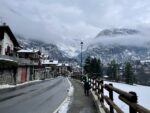
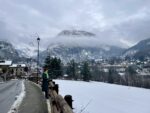
We awoke in Courmayeur, the famous Italian ski resort near Mont Blanc. The weather was a hot topic from our first conversation with the hotel manager at Stella Del Nord, who advised us that the most accurate weather info would not be in our smartphones but in the hands of the ski shop owners. The person we spoke to yesterday evening said definitively 'non e bello', but today the verdict is that the clouds are 'high' and snow won't fall. A strong wind that was rumoured to arrive yesterday, also didn't materialise. To our good fortune- we are headed to the slopes!
2024-03-28 20:06:43
Soph Dyer
Standing outside my flat, in the rain, Austria
Austria
NOAA-19

I rush home from the tram in the wind and rain, hoping to leave my things inside before the satellite arrives. I don't make it so stand buffeted by the wind on a street corner. Cars pass me, headlights on. Despite the tall apartment buildings, I catch a strong signal and am feeling happy until, for reasons I don't understand (perhaps the wet) my phone crashes, ending the recording. The experience does not help my sense of being off kilter or out of sync.
2024-03-28 11:42:10
Sasha Engelmann
Aire de Châteauvillain, France
France
NOAA-18


The rather grandly named 'Aire de Chateauvillain' is a gas station, electric car charger port and a food court with a Paul and a bistro. After waking at 6am and driving the best part of the day, my partner and I were absolutely starving, but we had trouble finding anything to eat. After being shown to a table between two other traveling couples, we were turned away from the bistro when they said they were 'out' of both the squash soup I wanted, the cheese plate we were going to share, and the goat cheese in the salad my partner ordered. As many other people were eating there, I had a sneaking suspicion that the bistro wasn't really 'out' of all of these separate dishes (how can a french bistro be out of chevre!? or cheese in general?!) but that we were turned away for other reasons. We made the best of it, and after I captured a rather noisy satellite image from NOAA-18, we went on our way.
2024-03-27 21:42:54
Soph Dyer
Malzgasse bus stop, Wien, Austria
Austria
NOAA-18



"And this is how it sees storms!" I write to Michaela, sharing a vividly coloured enhancement of the satellite image that we had received earlier, standing at the bus stop outside our shared studio space. "That’s just another name for us", she replies with the wit of the screenwriter she is. I like this thought – that we are storms. Robert, standing next to me, looking at my laptop screen, points out the Gaza Strip. I dismissed his observation because the the section of image beneath the map overlay appears to be only noise. Later, when I turned off the map overlay, to my surpsie Gaza's coastline was still visible – noisy but indisputably present in the image. How many times has Gaza been visible, only for me to not see it? I have spent the day working remotely with colleagues in London on digital platform for investigations into Gaza War. And now, somehow, without realising, from my local bus stop I have formed an indirect yet unbroken line-of-sight with the Palestinian territory.
2024-03-27 09:26:58
Sasha Engelmann
Hackney Downs, London, United Kingdom
United Kingdom
NOAA-19
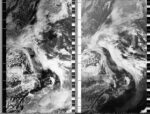

The last twenty four hours have been rainy in a nonstop, relentless kind of way. Today, shadows chase each other across the grass of the park as clouds give way to bright sun. My observations of shadows were interrupted by a squeeling bundle of dogs leaping by. One of the owners got upset that his dog had nipped another. For the next few minutes the park echoed with loud cry: 'Bruce!! that's THREE dogs today!!!'
2024-03-26 19:32:35
Sasha Engelmann
Downs Road, London, United Kingdom
United Kingdom
NOAA-19

The sound of the satellite, low and noisy over the nighttime horizon, mixed with the sizzling of a frittata and the slicing of salad leaves.
2024-03-25 22:09:44
Soph Dyer
Diepoldpark, Wien, Austria
Austria
NOAA-18


It is still but cold. I receive the image in our local park, standing by the toilets. Earlier in the day, on the train platform in Brno, I see a man dressed like a cattle herder, in full leathers, carrying tall boots. At the vegetable market, I buy a woven fruit basket from aother burly man who shows me and N a photo of him dressed as Obelix the Gaul. Tomorrow is meant to be sunny.
2024-03-25 11:17:59
Sasha Engelmann
Hackney Downs, London, United Kingdom
United Kingdom
NOAA-18


The grass in Hackney Downs has been freshly mowed either last night or this morning, and the smell is all-pervasive and enveloping, and feels even more potent given the relatively low wind. I could hear snippets of conversations across the downs (a dog walker asking another dog walker: 'poodle?!' 'no, labradoodle!'). A man walked nearby and when I smiled, he asked in an eastern european accent 'what is it'? When I replied, he asked 'are you a meteorologist'? I was surprised by my hestitation in answering, though I eventually confirmed 'no'.
2024-03-24 18:26:50
Soph Dyer
Tyršův sad, Brno, Czechia
Czechia
NOAA-15


I saw people carrying palms leaves and realised that its Palm Sunday. I am stood a well kept park at dusk. There is cut grass, old trees, and a goats in a petting zoo. Local dogs and their owners gather nearby. Its a full moon and the satellite transmission clear. The air feels moist, cool, spring-like.
2024-03-24 11:30:45
Sasha Engelmann
Springfield Park, London, United Kingdom
United Kingdom
NOAA-18


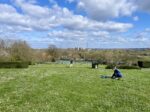

I realised as I left the flat today that I was wearing all-blue: old blue denim jeans from Uniqlo, a faded blue denim jacket with a warm lining that was my Mom's and has always smelled faintly of cigarettes, a striped navy blue jumper from my partner, royal blue socks, and a blue backpack and antenna bag. In Springfield Park in North Clapton I set up my ground station in a pool of daisies. A young couple asked me if I would take photos of them with their new baby. After I did so I asked for the favour in return, ending up with about twenty very skewed photos of me crouching over my ground station. When I explained what I was doing, the man who took the photos remembered seeing a string of Starlink satellites, which for him was 'weird' and 'frightening'. We had a brief chat about satellite resistance before they continued on their stroll.
2024-03-23 18:50:46
Soph Dyer
Pítko Letenské sady východ, Prague, Czechia
Czechia
NOAA-15


The cold wind cuts through the light clothes that I packed. N and I are staying in Prague's old town but have spent the evening in Holešovice district. There are lots of Ukrainian and Czechia flags in the windows and on buildings. I was reluctant to go on holiday and leave work but I'm glad I came. The writing block I have had is softening with conversation, reading time, and thoughts about unrelated things. I am unsticking myself.
2024-03-23 11:44:08
Sasha Engelmann
Hackney Downs, London, United Kingdom
United Kingdom
NOAA-18
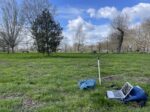
The temperature dropped by at least five degrees and a cold wind is sweeping over London. I was excited to 'see the wind' from above in the cloud fronts over the North Atlantic, but my laptop died within two minutes. In the sliver of an image that I managed to capture the white fingers of Iceland are just about visible. I remembered a conversation I overheard in a hair salon earlier this week about someone's upcoming trip to Iceland. They said 'we're going now as it's so volcanic, it might not be safe soon... then again, it's such a big destination, I'm sure 'they' will figure it out'
2024-03-22 19:38:12
Soph Dyer
Leaning out of the window at home, Wien, Austria
Austria
NOAA-19

2024-03-22 11:59:02
Sasha Engelmann
Downs Road, London, United Kingdom
United Kingdom
NOAA-18


A weather system
tremulous and noisy
between walls
2024-03-21 12:10:23
Sasha Engelmann
Russell Square, London, United Kingdom
United Kingdom
NOAA-18


On my bike ride to central London this morning, I noticed a cherry tree in full pink bloom in the courtyard of a church, and several magnolias in either late bloom or already dropping their oversized white petals. Yesterday was the spring equinox, but it feels like the singularity of spring happened some time ago. In Russell Square there were cordoned-off gatherings of bright yellow daffodils (though I wondered why it was necessary to ring these with black spokes and wire).
2024-03-21 11:26:48
Soph Dyer
Flowerbed, Augarten, Wien, Austria
Austria
NOAA-18




My phone says that it's 3C but it feels warm in the heat of the sun. I take off my coat and sit on the edge of the stone flowerbed, taking in the bulbs that have sprouted, listening to the satellite's signal, and offering a polite smile to the people who stare as they walk past. I mostly get blank looks, but one older man returns a scowl. It is not just the rise in temperature that makes it feel like spring is here, the air is scented.
2024-03-20 18:26:26
Soph Dyer
Augarten, Wien, Austria
Austria
NOAA-15



It's so peaceful in the park. The air is rich and still. Dusk has always been my favourite time of day. I need this moment of stillness after working on a project about the war in Gaza. I feel a familiar combination of profound gratitude and guilt. The sky is clear, it helps me.
2024-03-20 09:12:20
Sasha Engelmann
Hackney Downs, London, United Kingdom
United Kingdom
NOAA-19


I perched my ground station on a forked tree trunk that lies on the grass in Hackney Downs. The bark and most of the trunk is wet but, unlike fallen trees that I've seen in forests, it doesn't feel like its decomposing. I wondered whether this tree has been preserved in some way, or whether its decomposition is slowed by the relative bareness of its surroundings.
2024-03-19 21:44:25
Soph Dyer
Leaning out of the window, Wien, Austria
Austria
NOAA-18


I catch the last satellite pass of the day, dog tired. I am still waiting for a medical intervention to relive me of the pain that comes in night, preventing me from sleeping soundly. It is cold but clear out. I have given into the warmth of my flat and am leaing out of out the window. This morning on my way to the studio, I a man cycles past me carrying a full-sized bow and arrow.
2024-03-19 09:23:53
Sasha Engelmann
Hackney Downs, London, United Kingdom
United Kingdom
NOAA-19


In today's satellite image, the the rivers Garonne and Dardogne are very prominent, carving a dark line into the west coast of France and joining into a delta meeting the Atlantic. In the High North, Lake Onega is a pale white, suggesting it is entirely frozen.
2024-03-18 10:30:30
Soph Dyer
Augarten, Wien, Austria
Austria
NOAA-18


I enter the radio frequency incorrectly and only discover half way through the satellite pass. My bike is leant against a Yew bush. The park is full of children and adult carers, sat on benches in the sun. In my usual spot there was an older woman talking animately to herself, I decide not to risk interupting her. The temperature has dropped, but the sky remains clear. I will call Sasha to discuss this project.
2024-03-18 09:35:45
Sasha Engelmann
, United Kingdom
United Kingdom
NOAA-19


Last night, while sitting in the corner of the park on a bench under a streetlamp, an older, long-beareded man on a bike stopped, circled around, and told me I was 'too far into the park'. He advised me to go to the edge of Downs road to be safe, and added 'you are my daughter too'. This encounter stayed with me as I went back to the park this morning for a satellite pass, and looked at the distance between the bench and the streetcorner – a matter of metres – but in the dark, perhaps much more than that.
2024-03-17 11:17:21
Sasha Engelmann
Hackney Downs, London, United Kingdom
United Kingdom
NOAA-18


A gentle rain fell for the first half of the morning but conveniently began to let up before I headed outside to the park. The grass felt warm somehow, even though it was slick and waterlogged. As I stood with my antenna in the usual field, reflecting on the horizon, a jogger passed close by and in the space of twenty seconds we had a brief exchange. As he ran off he remarked 'the things you can do in the local park!'
2024-03-16 18:33:56
Soph Dyer
Diepoldplatz, Wien, Austria
Austria
NOAA-15


Experimental copper tube v-dipole antenna.
2024-03-16 11:29:32
Sasha Engelmann
Hackney Downs, London, United Kingdom
United Kingdom
NOAA-18


The sun came brightly through our windows this morning. Hackney Downs was brimming with activity, including the usual small persons' soccer practice on the open field. I set up a good distance away from the soccer, but still two balls came my way, kicked high into the air by players whose fluorescent jerseys came down over their knees.
2024-03-15 11:42:52
Sasha Engelmann
Greville Court Park and Playground, United Kingdom
United Kingdom
NOAA-18

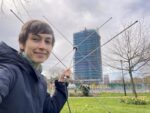
An animated wind is bending tree branches, ripping petals off magnolia trees and making waves in the deep green grass that has sprung up in parks, squares and pavement-free soil around Hackney. En route to a pharmacy, I stopped in a small park in between the Greville and Rogate estates. A tower block, wrapped in blue fabric, was being constructed (or refurbished) at the far side of the park, sending drilling and hammering sounds into the wind.
2024-03-15 09:32:12
Soph Dyer
Augarten, Wien, Austria
Austria
NOAA-19



This is the first weather note I write in almost a month. The pansies have been planted out in Augarten. I rested my bike on the stone of circular flowerbed and used a mobile phone and my v-dipole antenna to receive a long image. I took with me a cooked painted egg, which I dropped in the gravel when peeling and had to throw away. It is a clear, sunny day.
2024-03-15 09:32:12
Soph Dyer
Augarten, Wien, Austria
Austria
NOAA-19



This is the first weather note I write in almost a month. The pansies have been planted out in Augarten. I rested my bike on the stone of a circular flowerbed and used a mobile phone and my v-dipole antenna to receive a long image. I take with me a painted cooked egg, which I drop in the gravel when peeling and have to throw away. It is a clear, sunny day.
2024-03-14 11:55:01
Sasha Engelmann
Hackney Downs, London, United Kingdom
United Kingdom
NOAA-18


I wanted to field the ground today, so I laid onto the grass of Hackney Downs while capturing the satellite image. It was wet, yes, and musty too, and it smelled a little like unhealthy compost and dogs, but it was nice to feel my whole body flat against the surface of the ground. The air was cool and mild and lots of people were out in the park, some staring at me as they passed a safe distance away.
2024-03-14 11:15:08
Soph Dyer
Augarten by the flowers, Wien, Austria
Austria
NOAA-18




I did not press 'stop recording' before closing SDR++, and so corrupted the file.
2024-03-13 09:00:48
Sasha Engelmann
Royal Holloway University of London, United Kingdom
United Kingdom
NOAA-19

I went for a very low pass today – only around thirty degrees over the horizon – but thought I could get something from the top of the fire escape at the back of Queens Building where the Geography Department is situated. Unfortunately there wasn't much of a signal, and for several minutes at the height of the pass, bursts of interference blocked any chance of clear reception. Still, standing at the top of the fire escape gave me an amazing view of the residential neighbourhoods to the East of the university campus, and I could clearly see airplanes taking off and landing at Heathrow Airport, just over the reservoirs.
2024-03-12 10:43:42
Sasha Engelmann
Downs Road, London, United Kingdom
United Kingdom
NOAA-18


The darkness of yesterday has bloomed into spring rain today. Sitting by the open kitchen window, I could hear the pigeons cooing on the roof, perhaps making use of the partial cover of the chimney wall. Many people walked by on Downs Road, though their umbrellas and quick paces meant that they kept their eyes on the sidewalk, oblivious to a strange metal object being held out of a third floor window.
2024-03-11 12:40:03
Sasha Engelmann
Hackney Downs, London, United Kingdom
United Kingdom
NOAA-18

This Monday in London in early March is grey and dark. I had the living room lamp on for most of the morning while I was on zoom calls. I was several minutes late for the low-elevation NOAA-18 satellite pass at lunchtime but I'm still glad I went out to the park, as I met a young mom pushing a stroller, who stopped by to ask what I was doing. I showed her the clouds slowly forming over the South Atlantic, and we spoke briefly about the weather 'above and below'.
2024-03-10 11:08:28
Sasha Engelmann
Downs Road, London, United Kingdom
United Kingdom
NOAA-18


A light rain is forecast to fall all day today. It is coating the street, parked cars, trees, bricks and asphalt in a layer of water that is perpetually replenished from the sky. In weather like this, I wonder how the bugs and creatures of the soil are doing. As water logs the pores between grass roots and humus, do the smaller creatures begin to swim? do they breathe underwater?
2024-03-09 11:17:08
Sasha Engelmann
Hackney Downs, London, United Kingdom
United Kingdom
NOAA-18




A golden light has suffused the whole morning. The grass of the downs feels warmer, like the earth has heated up underneath. Near where I had set up my ground station, purple crocuses were pushing up through the weeds.
2024-03-08 13:10:12
Sasha Engelmann
Hackney Downs, London, United Kingdom
United Kingdom
NOAA-18


I am writing this weather note on a laptop that has been stepped on by a dog. I can almost see the outline of a paw on the lower right hand side of my laptop keyboard! While I was out in the field this afternoon, a man came up to me and asked what I was doing. He said he was following groups on Facebook doing similar things, but had never tried himself. He seemed genuinely interested in learning about open-weather and as we spoke his dog circled us several times, getting in the midst of the ground station and possibly changing the frequency I was tuned to...
2024-03-07 10:11:22
Sasha Engelmann
Hackney Downs, London, United Kingdom
United Kingdom
NOAA-19


A cold mist is hovering over Hackney today. Fewer people seemed to be out with their dogs, though it could also have been the timing of the satellite pass. However a group of people had gathered on the far side of the open field near Downs Road, bikes fallen sideways on the grass. They were stood in a wide circle doing slow movements with their arms and legs. As they were mostly dressed in long puffer coats and thick scarves, and because of the blurring fog, they looked like people made of cushions or marshmallows, moving slowly in coordination.
2024-03-07 10:59:59
Soph Dyer
Augarten by the trees, Wien, Austria
Austria
NOAA-18


2024-03-06 19:34:04
Soph Dyer
At home, Wien, Austria
Austria
NOAA-19
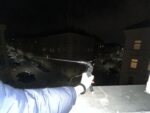
2024-03-06 10:25:49
Sasha Engelmann
Founders Field, Royal Holloway University, United Kingdom
United Kingdom
NOAA-19


The university campus is coated and swathed in fog today. I set up my ground station on the near-end of Founders Field and could barely make out a group of students smoking (or just breathing in the cold) on the picnic table on the other side of the field. I met some colleagues in the local cafe afterward and they mentioned the fog to me too: 'it must be nice to see out of the fog today'...
2024-03-05 22:09:44
Soph Dyer
Tyršův sad, Brno, Czechia
Czechia
NOAA-18


2024-03-05 18:57:46
Sasha Engelmann
Windowsill on Downs Road, London, United Kingdom
United Kingdom
NOAA-15



Today is the first day I felt a slight note of spring in the air. When I woke up at 7am there was already plenty of light in the garden. On my cycle ride to Bloomsbury, my hands didn't feel the bite of cold on my handlebars. I was overdressed for the temperature, and had to unzip my coat halfway through the ride. Later in the evening I perched on our flat's back windowsill holding my radio antenna in full exposure to the night air.
2024-03-05 11:27:55
Soph Dyer
On the balcony, Wien, Austria
Austria
NOAA-18



2024-03-04 21:28:15
Soph Dyer
At home, Wien, Austria
Austria
NOAA-18


2024-03-04 12:19:32
Sasha Engelmann
Hackney Downs, London, United Kingdom
United Kingdom
NOAA-18


My allergies have been horrible today- so bad that none of my emergency allergy medications and measures are working. While capturing the satellite pass, my eyes watered so much that I couldn't read the frequencies clearly; once back inside the symptoms didn't let up. When this happens I find myself desperately searching for the cause, but the thing about allergies is that sometimes there isn't one that is clearly defined. I am speculating about dust, springtime pollen, a low immune system, or lack of sleep- but none of these feel like the obvious source.
2024-03-03 20:39:23
Soph Dyer
Diepoldpark, Wien, Austria
Austria
NOAA-18




2024-03-03 11:00:47
Sasha Engelmann
Hackney Downs, London, United Kingdom
United Kingdom
NOAA-19



The bulbs and magnolias in Hackney Downs have been blooming in wild and 'spontaneous' groups. Across the UK, magnolias and camellias are blooming four weeks earlier than last year. As if in counterpoint to the conversations I had yesterday, today two older women and their dogs came up to me as I was kneeling by the daffodil beds in the park. One of their dogs, a terrier with huge whiskers, had come over to check out my antenna. The women were both wearing dark sunglasses and wool coats, and apologised for being 'nosey' before asking what I was doing. One of them remarked, 'there must be a whole group of people like you out here, I have seen them around'. I replied I didn't know who this group was, but that perhaps she was seeing me, as I had been in the park with my antenna almost every day (though the possibility of a secret Hackney Downs satellite group stayed with me). A younger woman then ran up to us, apparently having gotten confidence from the older women, and asked more questions with a lot of excitement- she had assumed I was tracking 'geotagged' animals, like birds.
2024-03-02 12:45:48
Sasha Engelmann
Hackney Downs, London, United Kingdom
United Kingdom
NOAA-18


This was a social day in Hackney Downs! I was approached by two men and their dogs, and speaking to them took up most of my attention during the pass. The first was an older, very large man named Bill and his dog nutmeg, a medium sized, curly haired deep brown dog, maybe a kind of terrier. The second was a younger man with a very big and wide laborador. Bill told me stories of his father who had used radio during WWII to listen to the Germans, and later erected aerials at racecourses across the UK (for reasons I didn't entirely understand). He also told me about a lecture he had attended by someone called Chris Lintott that was about microwaves and radio astronomy. The second man whose name I didn't catch had set up an antenna on the roof of his second floor flat to listen to ADSB. He mentioned he had gotten a dipole and tried capturing a satellite image but was unsuccessful. He also asked if I was into amateur radio and when I said yes, he said 'you and about five other people in the world, right?'
2024-03-01 22:06:11
Soph Dyer
At home, Wien, Austria
Austria
NOAA-18

2024-03-01 11:15:14
Sasha Engelmann
Munro Fox Lab, Royal Holloway University, United Kingdom
United Kingdom
NOAA-18


My socks and shoes were already damp from weathering my morning commute to campus, and they got even wetter as I traipsed around the university grounds trying to find a good place for the satellite pass. The field to the back of Queens Building (where the Geography department is based) was virtually spongy with water. I decided to try to set up on a picnic table in the middle of two science laboratories. In full view of biological sciences researchers fiddling with pipets and samples through a bungalo window, I set up my ground station and hand-held the V-dipole. I was lucky that the first eight minutes were rain-free, but toward the end I had to lean my body over the laptop to protect it from drowning.
2024-02-29 18:41:05
Soph Dyer
Augarten, Austria
Austria
NOAA-15

Leap day.
2024-02-29 09:57:27
Sasha Engelmann
Hackney Downs, London, United Kingdom
United Kingdom
NOAA-19

There weren't clear signs of rain when I left my house to go to the park, but as I arrived in the open I could feel a sideways blowing mist of very fine droplets. Once my laptop was out for a matter of minutes it was complete coated in water. I debated the risks of completing the pass vs laptop damage, and decided to keep going, though huddled over the computer with my body. I imagine I looked quite strange to passerby- a hooded person bent over a small screen, trying to hold an antenna with one oustretched arm.
2024-02-28 10:08:55
Sasha Engelmann
West Field, Royal Holloway University, United Kingdom
United Kingdom
NOAA-19


I was aware today that a meadow has its own weather. As I captured the satellite pass, I was conscious of the way the air in 'West Field' at Royal Holloway, surrounded by oak and plane trees, seemed denser than it had felt on my walk up the hill to campus. The open sky over the meadow seemed closer than it had when I woke up in London.
2024-02-27 11:51:48
Sasha Engelmann
Hackney Downs, London, United Kingdom
United Kingdom
NOAA-18


This is the first day that feels a little like spring in London. The air has that shimmer that happens when it is misty but also bright. The green of the grass of Hackney Downs is vivid, an invitation to lie down (which I did) though I quickly learned it was also very soggy underneath. The satellite image I captured has a small cyclone curling over the North Sea, its long tail curving and sweeping all the way to the coast of Morocco.
2024-02-26 12:05:23
Sasha Engelmann
Hackney Downs, London, United Kingdom
United Kingdom
NOAA-18


All night the wind howled around our flat. It caused unusual squeeks and whistles in different rooms. As a worked alone at my desk in the living room, the smaller, more random sounds made me imagine other people in the house, so much so that I went into the bedroom and studio to check! The wind had calmed by the time I went outside to catch the satellite pass, but I kept thinking of the wind-people.
2024-02-22 22:05:16
Soph Dyer
Reaching out of the door, Wien, Austria
Austria
NOAA-18

2024-02-21 08:10:33
Sasha Engelmann
Soph Dyer
Wave Farm, Acra, New York, United States
United States
NOAA-15



Wave Farm was quiet on this Wednesday morning in February except for the 'whoosh' of sometimes-passing cars on route 23, and the chirping of finches and other birds. The grass outside the Wave Farm building was white and crunchy with frost. We were late to set up for the NOAA 15 pass , but as both our ground stations launched, NOAA-15's signal virtually lept into the waterfall displays on our laptops. We shuddered with cold as the pass progressed. The image captured from the V-dipole antenna I was using shows the outline of the east coast of the US and the impressively large fingerprints of the great lakes.
2024-02-21 08:09:54
Sasha Engelmann
Soph Dyer
Wave Farm, Acra, New York, United States
United States
NOAA-15

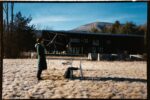

2024-02-14 17:29:33
Sasha Engelmann
Hackney Downs, London, United Kingdom
United Kingdom
NOAA-15


Ashen, cinereal, dusky, smoky, slated, drab, grey: this is how I would describe my experience of the weather today. It is in many ways unremarkable weather, as it is not very cold, nor very wet, nor stormy or very windy. It is simply grey- a matte feeling of the colour like it surrounds you everywhere, inside and outside, dampening even your thoughts.
2024-02-13 10:44:38
Soph Dyer
On my balcony, Wien, Austria
Austria
NOAA-18


QFH antenna test.
2024-02-13 09:43:50
Sasha Engelmann
Hackney Downs, London, United Kingdom
United Kingdom
NOAA-18

As I hurried out the door and toward the park, I realised that an invisible drizzle had become a light rain. I grabbed one of the broken umbrellas by the front porch and went to the park anyway. Crouching under the makeshift shelter on a park bench, I assembled my ground station and tuned to the frequency of NOAA-18. I knew the pass would be very low in elevation – only 19 degrees to the East – but I was hopeful. After a few minutes of weak signal as the satellite struggled to crest the horizon, a clear image began to appear- showing what I thought were Nordic glaciers and reflective lake surfaces. Only a minute or two later, the unmistakeable 'mound' of Meteor M N2-3 appeared surrounding and engulfing NOAA-18. Though the NOAA signal was strong, it was simply drowned out by the much wider and more powerful digital signal of the Meteor satellite, like someone trying to whisper in a crowded bar. I stopped the recording early, reasonably drenched by the rain, and returned with the glinting shapes of Nordic lakes in my mind.
2024-02-12 11:40:06
Sasha Engelmann
Hackney Downs, London, United Kingdom
United Kingdom
NOAA-18


I counted the seconds in the pass I captured this morning. Though the pass was of good elevation, and the weather is beautifully sunny and uncharacteristically warm, I truncated my recording and practically ran home with my antenna still assembled and my cables and laptop dangling. I was worried I would miss saying goodbye to my partner as she finished packing up and left for the airport.
2024-02-11 11:48:14
Sasha Engelmann
Hackney Downs, London, United Kingdom
United Kingdom
NOAA-18


After a weekend of rain and mist, this Sunday morning is glorious, with bright sun coming through very soft clouds. The local Baptist church is in full swing and fragments of choir music and raucous laughter echo into the park from the church's open door. A small group of teenagers gather on the street corner in between the church and the park, angling their faces to the sun. As I recorded the satellite pass I was visited by a small grey curly-haired dog with a red collar who then sped over the wet grass in circles around me. I think about 'dog satellites' and speculate on what they might transmit.
2024-02-10 10:26:48
Sasha Engelmann
Hackney Downs, London, United Kingdom
United Kingdom
NOAA-19



My ground station merged with the wet grass and mud of Hackney Downs field this morning. Mud was everywhere- attaching itself to my antenna bag, on the RF cables, the antenna dipoles, my coat and shoes. Nearby a young boys' soccer team was playing a morning match, egged on by a very loud coach who kept yelling at players by name and asking them 'who are you playing for?!'. I had forgotten my phone so I took photos of my ground station with my laptop camera. They were dark and gloomy but they somehow captured the atmosphere of the field, the game and the intermittent storm clouds.
2024-02-09 17:58:13
Sasha Engelmann
Hackney Downs, London, United Kingdom
United Kingdom
NOAA-15

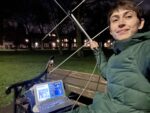
A break in the rain allowed me to duck outside to catch a NOAA-15 pass. The sun had set already, and very few people were out in the park and nearby streets. I searched for a bench near a streetlamp and assembled my ground station. I sat on the bench in the orbit of light provided by the streetlamp and extended the antenna, its metal dipoles glinting.
2024-02-09 10:46:17
Sasha Engelmann
Hackney Downs, London, United Kingdom
United Kingdom
NOAA-18
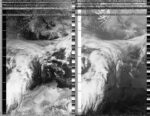

Rain pattered on the windowsills all morning. Water pooled and ran down the glass, and mist seemed to hover in between the three story houses on either side of our one-way street, like a wet cloud trapped in a crevice of our neighbourhood. I contemplated staying inside with my antenna held out the window, but ended up braving the rain with a big broken umbrella and a long insulated raincoat. Once outside, I propped the umbrella over a bench and set up my laptop and dongle under its shelter, with the antenna and cables curling out. At one point during the pass, the wind moved the umbrella and its flimsy, broken side sent pools of water splashing onto the keyboard of the computer- which I hurriedly brushed off with the sleeve of my coat, hoping no damage would be done. A man in full high-vis weather gear with a wheelbarow that looked like a recycling collection stopped next to the bench and asked what it was I was doing out here.
2024-02-07 21:47:26
Soph Dyer
On my balcony, Wien, Austria
Austria
NOAA-18



I was buffeted by mild but squally weather through the satellite pass. When I looked behind me the sky was ominously dark. For a moment, I thought that I should put down my antenna in case an electrical storm was coming, but none was forecast so I kept recording. It has been a tough day and I am feeling tired.
2024-02-07 09:22:06
Sasha Engelmann
Founders Green, Royal Holloway University of London, United Kingdom
United Kingdom
NOAA-19


Today is wet, cold, soggy and muddy. A storm swept through London last night, and pattered the windows of my flat for most of the night. Most commuters early this morning had an air of being half-asleep and were hunched down into their scarves and woolly hats, like sea urchins. Founder's field, where I collected the satellite pass, was empty except for me with my V-Dipole antenna and laptop.
2024-02-01 11:30:57
Soph Dyer
Beside the round flowerbed in Augarten, Wien, Austria
Austria
NOAA-18





Wet! I have just come back inside from the satellite pass, dripping. I stood in Augarten park, in the intensifying rain, my laptop inside a small bin bag tent. From the warmth of my shared studio, I decoded the image. A huge white arc of water sweeps across my screen from North from Spain to Norway. Is this what it feels like to be at sea – to orientate by waves of water and light? Sometimes Sasha and I joke that open-weather is a queer, feminist space agency. Right now, I feel less like an astronaut and more like an aquanaut.
2024-02-06 09:35:09
Sasha Engelmann
Russell Square, London, United Kingdom
United Kingdom
NOAA-19


The westerly wind was so strong this morning that, on my bike ride from East London to Bloomsbury, I felt at times that the strength of my body wouldn't manage to move my bike forward, and I regretted my choice to cycle in the first place. I was sweating so profusely inside my green puffer jacket that, once I arrived in the square, I risked the cold air and took off my coat to try to air myself out. I coudl tell that passerby were wondering what a person in nothing but a thin shirt and blazer was doing holding a metal object to the sky at half past nine, but no one approached me. On my cycle home in the evening, the wind, as I hoped it would, practically carried me forward, so that the roads felt glossy and smooth.
2024-02-06 10:32:11
Soph Dyer
Children's play area in Diepoldpark, Wien, Austria
Austria
NOAA-18


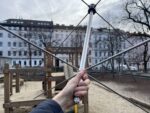
Blustery, blue and spring-like. The wind was so string this morning, it almost blew me off my bike.
2024-02-05 20:36:24
Soph Dyer
At home, on the window ledge., Austria
Austria
NOAA-19



Turbulence: outside, between me and my partner, in my body. I saw on a forecast map that the jet stream is between me and Sasha. The winds leaving London appear to arrive in Vienna. I like this thought, that we are asynchronously sharing the same air. I imagine messages, aeroplankton (Luftplankton), and water vapour moving between us.
2024-02-05 11:23:11
Sasha Engelmann
Hackney Downs, London, United Kingdom
United Kingdom
NOAA-18



There is high wind today, it feels like gusts are slicing across the surface of the city, though it is hard to tell from what precise direction. The clouds are patchy and partial, like a fast-moving lattice, and sun pierces through in very quick beams that meet earth's surface and disappear again. I imagine that from the position of the clouds, it might be like a high-speed game of shadow puppets. What shapes they must be casting!
2024-02-04 19:08:31
Soph Dyer
In a field by the motorway, somewhere outside Klagenfurt, Austria
Austria
NOAA-19


Today I swam in an alpine pool next to melting ice. I am recieving this image a dark hill, by a motorway, under the stars.
2024-02-04 11:36:07
Sasha Engelmann
Hackney Marshes, London, United Kingdom
United Kingdom
NOAA-18



A cold wind slowed me down on my cycle ride out to Hackney Marshes. Once in the marshes, I weaved between Sunday strollers, kids on bikes, canal boaters and athletes to find a corner of the marshes to set up my ground station. At first the NOAA-18 signal was drowned out by the characteristic signal of the Meteor satellite fleet, which caused a 'mound' of energy extending around 80hz to either side of the NOAA-18 signal. I started recording during this noisy occlusion, thinking NOAA-18 was about to pierce through (helped by Automatic Gain Control) but it took a couple more minutes for the signal to make it through the surrounding energy and noise. The wind continued to bluster as the pass progressed. A kind looking man with long gray curly hair and headphones stopped nearby and offered to take a photo of me. We spoke briefly about radio and satellites before he continued on his windy walk.
2024-02-03 18:10:42
Soph Dyer
Near Pontebba, Friuli, Italy
Italy
NOAA-15

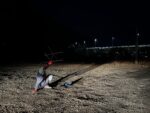
We are in the mountains but it is above freezing. A thin layer of water covered the last of the melting snow. In Vienna last night, the wind was so strong it crashed against the bedroom windows, keeping me awake. After working on open-weather during the day, I was too excited too sleep deeply anyway.
2024-02-03 13:29:01
Sasha Engelmann
Hackney Downs, London, United Kingdom
United Kingdom
NOAA-18


Today I attempted to receive a satellite image from a pass that I assumed would be 'out of the sensible range' of my ground station. The maximum elevation of the pass was 13 degrees to the West, and I hadn't previously tried to receive anything under 30 degrees. Expecting to get nothing, I found a spot in the middle of Hackney Downs and held my antenna as high as possible to catch whatever radio waves could bend around the curve of the Earth as the satellite barely crested the horizon. Surprisingly, the signal was already visible at 13:28 and I had a reasonably strong signal by 13:30. As I watched the image load line by line, I realised I was seeing cloud patterns over Greenland and the north Atlantic, so far to the west that no coastlines of Europe were visible. Meanwhile in Hackney Downs a group of dogs played around me and the gray clouds hung low. There was something incredibly strange about seeing the North Atlantic so many kilometres to the west, while Saturday morning life kept unfolding in London.
2024-02-02 10:28:19
Sasha Engelmann
Downs Road, London, United Kingdom
United Kingdom
NOAA-19


London is gray and cold today, with a haze that feels like a soft blanket. On my way to buy bread this morning, the air made street corners, cars and shops look a little fuzzy. Being inside a bakery, and back in my flat with a warm loaf of bread and a coffee, was deeply comforting. It feels like good weather to be tidying up the house, changing sheets and watering plants.
2024-02-01 10:33:13
Sasha Engelmann
College Green, Goldsmiths University of London, United Kingdom
United Kingdom
NOAA-18





I met the Centre for Research Architecture students on the top of College Green at Goldsmiths University on a brilliantly sunny morning of the 1st of February. I introduced the DIY satellite ground station we would use to capture an image from NOAA-18, and immediately there were about a dozen questions. Melodie held the antenna first, tracking the satellite from the southern horizon to a maximum elevation of 43 degrees. Excited chatter was constant throughout, and laughter rang out as Melodie and later Penelope tried different poses and antenna orientations. The atmosphere was joyful and lively, but as the pass came to a close, the group was happy to return inside to warm up and look at the image in darker / calmer conditions.
2024-01-31 20:38:08
Sasha Engelmann
Hackney Downs, London, United Kingdom
United Kingdom
NOAA-18


The weather of Hackney Downs park close to 9pm at night on a Wednesday was surprisingly calm. A whispy wind blew blades of grasses but didn't manage to move dry leaves on the ground. I caught the wrong satellite – I had intended to capture an image from NOAA-19, and tuned to NOAA-18 instead – and unexpectedly started recording a 30 degree eastward pass. This first felt inconvenient because a line of Victorian houses blocked my 'line of sight' to the east. But the signal came through anyway, and this accident meant that I captured a dramatic cyclone swirling over eastern Europe and Russia. Seeing the image startled me- a dramatic disconnect from my experience of mild weather in the park.
2024-01-31 11:45:19
Soph Dyer
Gefechtsturm Augarten, Wien, Austria
Austria
NOAA-18



Open skies and bird song – almost spring like. I did not weather my thermal leggings under my trousers today! At first I thought that I'd made a mistake but quickly I warmed up and enjoyed the free feeling of air on my legs.
2024-01-30 21:46:34
Soph Dyer
Dornerplatz, Wien, Austria
Austria
NOAA-18


I worked from home so didn't leave my flat until the evening. Today was dry, clear and cold, but not too cold – you could take your gloves off without your fingers hurting. The stars were bright.
2024-01-30 10:57:24
Sasha Engelmann
Lesoco Building, Goldsmiths University of London, United Kingdom
United Kingdom
NOAA-18




Low, gloomy clouds hung over London as we gathered in the middle of a green circular lawn outside of the LESOCO building in which Goldsmiths design students study for their masters degrees and work in their studios. Deptford creek gurgled just a few metres away, though it was closed for access by a tall metal fence. A highway overpass arced to our east and a six lane intersection around the corner made a constant soundscape of motorbikes and car engines. In this context we huddled around my turnstile radio antenna and attempted to orientate our bodies in relation to the satellite orbiting overhead and the series of urban infrastructures around us. A constant interference pattern caused audible distortion to the satellite signal and produced regular and oblique lines in the image, like counter-currents of wind or a graphical anti-pattern.
2024-01-29 20:20:46
Soph Dyer
Entrance of Augarden, Wien, Austria
Austria
NOAA-19


It's clear and cold again, when I left for work this morning the rooftops were frosted white. Frost always takes me back to childhood. When there was a heavy or hoarfrost, I would go out before school to slide down the field opposite our house on a tray. Sledging on frost felt more risky, edgy, than on snow – the frozen ground could easily inflict bruises. It was also a sport no one else seemed interested in, so I had the field to myself – bold and alone.
2024-01-29 11:14:13
Sasha Engelmann
Downs Road, London, United Kingdom
United Kingdom
NOAA-18


The weather of my body today is turbulent and choppy. Though I am usually able to remain calm on the surface, today is proving difficult. I am surprised when my bodily, emotional weather bursts out into the conversations I have with students and colleagues throughout the morning. I have begun to edit apology notes (probably unnecessary) to be sent later over text and email.
2024-01-28 20:35:07
Soph Dyer
Inside with the antenna strapped to a curtain rail, tied to my balcony in Wien, Austria
Austria
NOAA-19

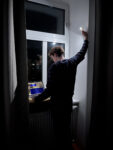
Beautifully sunny. The woods are free of snow and ice, and full of walkers. I went on a solo hike in the Wienerwald, stopping for lunch at Toiflhütte, and breathing plenty of Waldluft. The birds continue to sing. I heard blackbirds, crows, wood peckers, a jay, and small song birds. The temperature is a frosty 5 degrees centigrade, with no wind.
2024-01-28 11:20:46
Sasha Engelmann
Hackney Downs, London, United Kingdom
United Kingdom
NOAA-18


Today is an unusually warm Sunday in London in January. Although the weather has been overcast, the clouds feel veil-like and thin, and the Sun either burns them up or pushes them away by midday. As I was due to make a Sunday lunch for some friends, I spent most of the pass alternating between looking up recipes on my phone and checking the satellite signal. By the end of the pass I had both a long WAV file and a list of ingredients.
2024-01-27 22:26:10
Soph Dyer
On my balcony, freezing my ass off, Austria
Austria
NOAA-18

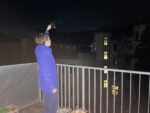
Cold, but only because I didn't expect to stand outside, so I didn't have my coat, hat and gloves on. More bird song today. I was around 7 Centigrade. Clear, clear skies. So many stars.
2024-01-27 11:34:33
Sasha Engelmann
Abney Park Cemetery, London, United Kingdom
United Kingdom
NOAA-18




Abney Park Cemetery was muddy, wet, and full of dog walkers and strollers on this Saturday Morning. The density of the winter trees and the humidity of the air created a mist that felt appropriate to the vine-covered tomb-stones, monuments and crosses. I thought of the way early radio enthusiasts heard 'something in the static' that spoke of other spaces and times of the past and future. I pointed my antenna at the moist ground, wondering if the static would pick up frequencies underneath.
2024-01-26 19:06:51
Soph Dyer
Augarten, near the gun towers, Wien, Austria
Austria
NOAA-18


Today, the bird song was louder than the beep-beep of the satellite. Gardeners in the park were clearing the dead leaves into piles. I heard that it's better to leave them to decompose and return their nutrients to the trees from which they fell – they don't kill the grass. The temperature is mild and there is no wind, but there is a heavy blanket of cloud. Although it is nearly midday, the cars have their headlights on. This evening I willl go to the 'Defend democracy' protest outside the Austria Parliment.
2024-01-26 10:10:04
Sasha Engelmann
Hackney Downs, London, United Kingdom
United Kingdom
NOAA-19


The sky is a deep cerulean blue today – cloudless, and slightly purple in hue. I spent part of the satellite pass lying on my back looking up. The grass was so wet and cold that I didn't stay on the ground long, but the feeling of being engulfed in a January blue has stayed with me.
2024-01-25 21:31:00
Soph Dyer
My bedroom, Wien, Austria
Austria

Silent migraine.
2024-01-25 10:21:30
Sasha Engelmann
Hackney Downs, London, United Kingdom
United Kingdom
NOAA-19


Today the park was spontaneously drizzly and I hunched over my laptop to keep it dry for the ten minutes of the pass. As I was crouched so low to the ground for most of the time, I experienced the weather of the park at the height of a small child or animal.
2024-01-24 19:06:51
Soph Dyer
Augarten, Wiem, Austria
Austria
NOAA-15


It almost feel warm today. In the afternoon, it rained but I was inside the studio so didn't notice until I saw the wet pavement. My body also feel springy-ier, the migraine and stiffness I've had since Saturday is receding.
2024-01-24 10:32:45
Sasha Engelmann
Royal Holloway University of London, United Kingdom
United Kingdom
NOAA-18


In comparison to the windy and wet weather of Storms Isha and Jocelyn over the last few days, today feels calm, even balmy. I walked to 'Founder's Field', the highest point on the university campus, to set up my spare V-Dipole and test a new dongle (RTL-SDR V4). The atmosphere of the university is also calm, as if the machines of departments, university managers and administrators are hibernating.
2024-01-23 21:33:09
Soph Dyer
On the North West corner of Diepold Park, Wien, Austria
Austria
NOAA-18

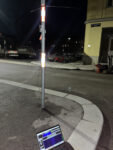
I think heard a Great Tit calling this morning. It rained today and feels milder. I was meant to be on a night train to the Netherlands this evening but German train drivers have walked out. They will be on strike until Monday. I have cancelled my trip. Life feels turbulent at the moment.
2024-01-22 20:08:39
Soph Dyer
Leaning out of the Northeast facing window of my flat, Wien, Austria
Austria
NOAA-19


I have been inside most of today. The weather inside is stuffy.
2024-01-22 10:57:26
Sasha Engelmann
Hackney Downs, London, United Kingdom
United Kingdom
NOAA-18


Wind has changed the surface of the park and neighbourhood overnight, leaving large piles of torn leaves, knocking down branches, ripping coverings off parked motorcycles and bending 'for rent' signs on their axes. Whistles and howls echo through the streets and across the downs, joined by the sirens of ambulances and fire trucks. On local radio this morning there was mention of wifi and phone service cuts. This is London in the aftermath of Storm Isha, which has swept across the southeast overnight. Its long arm is dramatically visible in the satellite image I captured today – curving over France, Germany and the continent, and spiralling toward Sweden and Norway.
2024-01-21 20:19:49
Soph Dyer
The balcony of my flat, Wien, Austria
Austria
NOAA-19


Frosty, slowly defrosting. This morning, I woke to a blackbird singing. There is still snow on the ground in the woods. Sasha and I have been receiving NOAA satellite imagery everyday for one month!
2024-01-21 11:08:40
Sasha Engelmann
Downs Road, London, United Kingdom
United Kingdom
NOAA-18


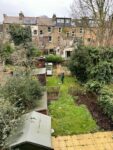
Storm Isha has been sweeping across the UK this weekend, with amber weather warnings issued by the Met Office in many parts of Wales, Scotland and Western England. Though the conditions weren't that bad in London, I stayed in the back garden of our flat to keep sheltered from wind. A curious cat named Dylan came padding quietly up behind me to check out what I was doing.
2024-01-20 20:32:35
Soph Dyer
Inside my bedroom! Wien, Austria
Austria
NOAA-19


It's clear but cold. I'm still feeling unwell (again!) that I think it feels colder to me than it actually is. I stayed inside during the satellite pass.
2024-01-20 11:20:08
Sasha Engelmann
Hackney Downs, London, United Kingdom
United Kingdom
NOAA-18


It was a gray blustery morning in Hackney Downs. A man with a dog stopped nearby and asked 'what's that mate?' to which I replied 'a radio antenna, I'm trying to catch the signal of a weather satellite'. He gave a thumbs up and said 'so it's a weather thing? a weather thing?' I nodded, and he walked off without further questions. I had apparently given a satisfactory answer. Yet I wondered what kind of 'weather thing' he was convinced I was operating.
2024-01-19 11:32:55
Sasha Engelmann
Downs Road, London, United Kingdom
United Kingdom
NOAA-18
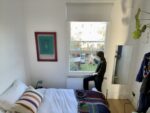
I was in between two meetings on Microsoft Teams – one finishing and another one starting at 11:30. NOAA-18 was due to start its orbit over London at 11:31. I wondered – was there time for the weather? I tried to 'create time' by writing a 'I'm five minutes late' message to the person I was due to meet, and took my laptop to the bedroom to the nearest possible window to receive the satellite pass. As I was counting the minutes of the pass I was also counting how late I would be. I wished I could stay in the 'weather' of the bedroom and sunny back garden, and avoid the 'weather' of the Teams meeting room!
2024-01-18 08:13:21
Soph Dyer
The balcony of my flat, Wien, Austria
Austria
NOAA-19


So icy underfoot! My body felt sluggish this morning from a lack of sunlight and and my period. I ventured outside only to grip the v-dipole antenna to the balcony railing and then stayed inside for the duration of the satellite pass.
2024-01-18 11:44:26
Sasha Engelmann
Hackney Downs, London, United Kingdom
United Kingdom
NOAA-18


The weather was bright and gusty, and bitingly cold. Hackney Downs was wide open and clear, so clear it made me wonder what it was before there was London. There were so many dogs being walked in Hackney Downs – I saw one person holding eight dogs – and a short-haired Australian Shepherd ran up to my laptop during the satellite pass. I stopped to pet her, and I wondered if her energy was having an influence on the satellite image.
2024-01-18 09:26:57
Soph Dyer
The balcony of my flat, Wien, Austria
Austria
NOAA-19



I tried the loop antenna again, this time squashing it into a folded dipole. The result was not good. Despite the near overhead position of the satellite, I could barely hear its transmission. I experimented with orientating the antenna vertically and horizontally.
The temperature feels a warm 2–5 degrees this morning. It is raining lightly.
Over WhatsApp, my brother sent a photo of the sun rise off the coast of Cornwall. In return, my mum shared a photo of her frosty garden. In both photos, the sky was clear. Yet an hour later my sister’s partner sent a video of large snow flakes falling in Truro. The weather in the UK is so much more changeable than in Austria. Here we have steady, continental weather. British weather is sea weather.
2024-01-17 21:49:09
Sasha Engelmann
Downs Road, London, United Kingdom
United Kingdom
NOAA-18


I had finally made it home after a fourteen hour day at work at the university and on many commuting trains. It's been so cold in the UK with a current of Arctic air reaching down across northern Europe this week, but it has also been very clear and bright- I could see the stars as I reached my antenna off the kitchen windowsill.
2024-01-17 09:39:48
Soph Dyer
The balcony of my flat, Wien, Austria
Austria
NOAA-19



Cold, small, icy snow flakes. I had to keep my laptop inside. I used the loop antenna, elevated by a curtain pole to 1.5 metres. The antenna was highly directional, and so was challenging to keep tuned to the satellite.
There is still pockets of snow on the rooftops. It feels around –3C outside. It wasn't forecast to snow today but the clouds are a pale white-grey and city has the deadened acoustic quality of a snow day. The light level is low.
2024-01-10 08:48:00
Soph Dyer
Carnegieplein, Peace Palace, The Netherlands
The Netherlands


Lizzie and I stood outside the Peace Palace. Its public square was the closest the open space to our apartment. But we had also retuned out of curiosity to record the atmosphere before tomorrow’s court hearing. “The world will be watching The Hague,” several Dutch people had told me. On arrived, the square was empty except for people going to work or walking dogs. At the palace gates, security guards were using LED-lit mirrors to check the underbellies of vehicles. Perhaps this level of caution at the Court was normal? Lizzie and I assembled the antenna and tuned to the satellite's frequency. At first, a security man walked over and asked us to leave. We negotiated 10 more minutes. Annoyingly, we had not yet picked up a signal. I was about to begin troubleshooting when the a police car pulled-up. A police man asked for our IDs and took them into the patrol car, while his colleague stood, leaning on its open door. Still no satellite signal. Lizzie experimented with the position of the antenna, when she rotated it, I was sure that I briefly saw the telltale lines of the transmission. Cold, we gave-up, packed down, and waited for our IDs to be returned. Lizzie lamented having not pressing record: at least then we would have documented radio environment. As it was, we left twitchy from police check and without an image. From inside a nearby cafe, I tuned to the tension in my muscles and their alertness. Perhaps we hadn’t needed the radio antenna. Our bodies had picked up a tension in the air that I had failed to see.
2024-01-16 12:09:16
Sasha Engelmann
Hackney Downs, London, United Kingdom
United Kingdom
NOAA-18

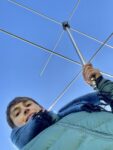
The weather today is gorgeous – bright blue skies and golden sunlight. All morning the DJs on NTS radio have been remarking on the beautiful (if cold) weather conditions. To soak up the weather as much as I could, I found a spot in the middle of the widest field in Hackney Downs and set up my ground station. I was exposed in other ways too- many people stared and pointed at me from a distance, but none came near.
2024-01-16 11:29:29
Soph Dyer
Augarten, Wien, Austria
Austria
NOAA-18


A piercingly clear day. Fresh. Chilly! I was glad to feel the sun on my face.
2024-01-15 21:29:44
Soph Dyer
Wien, Austria
Austria
NOAA-18




Cold, dark, damp. I feel "under the weather". Today, I stayed home and experimented with the loop antenna. To adapt the antenna to receive Very High Frequency transmissions, I squashed it into folded dipole. Despite what the online instructions recommended, this seemed to make things worse. I reverted to the open loop – the circumference of which is just under a half wavelength of 137 MHz. It okay but was highly directional. I will try again soon.
2024-01-15 10:41:52
Sasha Engelmann
Clapton Pond, London, United Kingdom
United Kingdom
NOAA-18
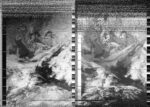

Half of Clapton Pond was frozen on the surface, the other half (receiving the sun over the tops of buildings) was not. Pigeons stayed out of the shade, milling about the edge of the pond and periodically bursting into the sky. In the decoded satellite image, I noticed that the mainland UK appears sandwiched between two bodies of east-moving cloud, receiving its own intermittent winter sun.
2024-01-14 20:03:14
Soph Dyer
Wien, Austria
Austria
NOAA-19



I wore too many wooly layers! It was milder than I expected, around zero Celsius. My ground station was between the bins and the Austrian Post Academie. A few stars were visible between the clouds and light pollution. People hurried past: a dog walker, a parent and child, a runner. I have felt restless today. I asked Nicola about the weather: he says people are ice skating on the nearby pond in Türkenschanzpark.
2024-01-14 11:02:15
Sasha Engelmann
Downs Road, London, United Kingdom
United Kingdom
NOAA-18

I stayed almost entirely inside during this satellite pass, in sweatpants, slippers and an oversized jumper I had found in a vintage store in Buenos Aires. Even before I stuck my arm outside the kitchen window to catch the last half of the satellite pass, the antenna was picking up NOAA-18 inside the flat. This made me wonder about the porousness of our flat to the 'weather' of radio. Nicola took a look at my satellite image, he pointed out a cluster of white pixels where Mt Etna should be: the volcano is snow covered!
2024-01-13 17:53:11
Sasha Engelmann
Hackney Downs, London, United Kingdom
United Kingdom
NOAA-15


I assembled my antenna on a bench in a dim pool of lamplight after sunset in the local park. I had just come back from the march for Palestine and still had my placard with me. As I was already so cold and tired from being out at the march all day, and the park was even colder than the streets, I struggled to concentrate, almost dropping my antenna and laptop.
2024-01-13 18:50:29
Soph Dyer
Wien, Austria
Austria
NOAA-15

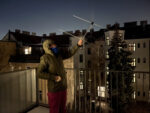
Cold but clear. I enjoyed being in the weather because I have a new coat and I have been inside all day. Amazingly, the snow on the balcony is the same as when I left a week ago. I take pleasure in this stability because I am feeling disorientated: I did not sleep on the night train and I stayed in bed all today.
2024-01-12 19:22:06
Soph Dyer
Between Amsterdam and 's-Hertogenbosch, The Netherlands
The Netherlands
NOAA-15

I am on the night train. The weather inside is controlled by a continuous cold draft from an overhead ventilation duct. I rigged my v-dipole antenna to the ladder for the beds, and tuned to NOAA-15 mid-pass. As the train sped between lit buildings, I could see the satellite dip in and out of reception. I finish the recording just before we reach the next station. I am thinking about how the current political climate renders some lives disposible, ungrievable. "An ungrievable life is one that cannot be mourned because it has never lived, that is, it has never counted as a life at all", wrote Judith Butler. Is this fascism? Golrokh messaged from Tehran. There is so much weather between us. At 's-Hertogenbosch, a woman paediatrician boards the train. She is wearing a blue surgical mask and says that she’s got the flu (later, she corrects, she thinks that she has Covid). Our shared compartment feels tense as we exchange gases, aerosols, and possibly virus. She is going on a skiing holiday.
2024-01-12 11:26:31
Sasha Engelmann
Downs Road, London, United Kingdom
United Kingdom
NOAA-18

I tried to stay away from the weather today as my asthma had kept me up the previous night and I was worried about too much time in the cold. I leaned out my second story window to catch the segment of the satellite pass that managed to creep in between the Victorian buildings on my street.
2024-01-11 09:51:05
Sasha Engelmann
Hackney Downs, London, United Kingdom
United Kingdom
NOAA-19


I wanted to catch the satellite pass in my back garden, but the gate was so cold the lock had frozen or stuck, and I couldn't open it. I hurried to Hackney Downs and found a spot very close to the entrance in the long shadows of the plane trees. As I was listening to the satellite a woman with bright pink gloves came up behind me and asked what I was doing. When I told her about the satellite and my radio antenna, she immediately asked – are you a creative? This is the second time a person in Hackney Downs has asked me whether I am a 'creative' while I am holding my antenna. She kindly took the photo I uploaded.
2024-01-11 10:46:05
Soph Dyer
Eline Vere Park, Den Haag, The Netherlands
The Netherlands
NOAA-19




"GLOBAL SOLIDARITY CALL WITH SOUTH AFRICA. JUSTICE FOR GAZA, MANIFESTATION AND LIVESTREAM OF COURT HEARING. Bring banners and signs with text: 'No genocide, No ethnic cleansing, Anywhere', 'Justice for the Palestinians', IsraelOnTrial for its #GazaGenocide'" @free.palestine.nl
Today, I am unable to organise my experience of the weather into the coherent report.
At lunch, I stood in the park behind the ICJ and watched a live stream of South Africa's lawyers argue that Israel is intended to commit genocide.
Outside it is still below freezing.
A street away, the students are build antennas:
Ice-tennas,
Tree branch-tennas,
Finger-tennas.
2024-01-10 10:02:11
Sasha Engelmann
Hackney Downs, London, United Kingdom
United Kingdom
NOAA-19
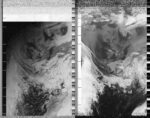

The grass crunched with frost this morning, and the air was so cold that my hands felt clumsy while assembling the antenna. Midway through the pass, a beautiful Italian greyhound in a pink sweater came over to investigate.
2024-01-09 11:56:24
Sasha Engelmann
Hackney Downs, London, United Kingdom
United Kingdom
NOAA-18


I made a poor choice not to bring a hat and gloves when I went out for the pass today, as Hackney Downs was sunny but extremely cold and windy. Even the dogs running in the park had sweaters and multicoloured outfits on. A man stopped and asked what I was doing, and a woman and a dog happily took some photos of me.
2024-01-09 11:13:34
Soph Dyer
Malieveld, Den Haag, The Netherlands
The Netherlands
NOAA-18



It’s bloody freezing!
Today’s image is from the workshop demonstration.
I am too brain-fried from teaching to write more.
2024-01-08 19:18:03
Soph Dyer
Peace Palace, Den Haag, The Netherlands
The Netherlands
NOAA-15


Brrrr. It is bitterly cold! I almost stopped the recording early because I couldn't feel my fingers despite my gloves. The sky was icy clear so I tried to spot NOAA-15, without luck I arrived in the Netherlands this morning after taking the the night train from Wien. I woke to thick snow flakes floating outside the train window. Inside the weather was toasty. It's no long snowing, but a wide current of cold air, coming down from Russia, is chilling Central and Western the Europe to the bone! Tomorrow I will wear my thermal leggings.
2024-01-08 12:08:23
Sasha Engelmann
Hackney Downs, London, United Kingdom
United Kingdom
NOAA-18

Snowflakes started to fall on my laptop during the satellite pass. They were very small and fragile, fluttery fragments of crystalline ice, not heavy like hail or water.
2024-01-07 08:21:24
Soph Dyer
Wien, Austria
Austria
NOAA-15


White-grey sky. Not too cold. It began to snow just before the satellite pass, so I had to change plans and stay on my balcony, where my laptop could stay dry, instead of going to the park. I used a stretchy piece of plastic to weatherise my dongle.
2024-01-06 11:26:55
Sasha Engelmann
The Bluffs at Pacific Palisades, California, USA
USA
NOAA-18





From the 'point on the bluffs' in Pacific Palisades, Los Angeles, I could see as far as Palos Verdes and Catalina Island. It was a bright, warm day, and many people were out walking. The satellite 'set' over the Pacific Ocean- I felt I could hear it for much longer than I normally can from a place in the city, as there was only air between me and the horizon.
2024-01-06 20:00:00
Soph Dyer
Wien, Austria
Austria
NOAA-19


Cold. It's been raining all day. I held my antenna out of the window.
2024-01-05 20:16:07
Soph Dyer
Wien, Austria
Austria
NOAA-19



Chilly and noisy (cars, mopeds, buses)
2024-01-05 09:59:43
Sasha Engelmann
Heather Village, Fox Hills, California, USA
USA
NOAA-19

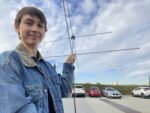


Standing in an elevated parking lot attached to the Heather Village condominium complex in Culver City, Los Angeles, I could hear engines starting and wheels tentatively moving as commuters started their day. The nearby 405 Freeway made a constant whoosh-hum, and airplanes took off and landed at LAX.
2024-01-04 08:26:26
Sasha Engelmann
Yucca Valley, California, USA
USA
NOAA-19



A pack of coyotes howled in the distance as I captured this satellite image. I was on the edge of Yucca Valley bordering Joshua Tree National Park, and while the air was cold, the sun was very strong, reaching into the crevices of the hills and boulders. The wind whistled among the Joshua Trees and Cholla Cacti. I felt very 'close' to the satellite too- there was so little radio noise, the moment I picked up my antenna, the satellite signal came through clearly, even though it had barely crested the northern horizon. I didn't need to look at the compass on my phone because the north star had shone so brightly the previous evening and it was easy to remember where 'north' was.
2024-01-04 07:54:36
Soph Dyer
Venice, Italy
Italy
NOAA-15




Chilly, damp morning air. It is misty on the lagoon. Cloudy, soft light, pastel colours. There is lots of radio frequency noise. The satellite's signal is weak, perhaps because of the noise or because my turnstile antenna is missing a pole.
2024-01-03 20:34:37
Soph Dyer
Fondamente Nove, Venice, Italy
Italy
NOAA-19





It is a beautifully still night on the Venice lagoon; overcast, but with good visibility. I captured the image from a floating pontoon on the Fondamente Nove. As the satellite passed overhead, the pontoon was rocked by passing Vaporetti. I made a sound recording of water and radio waves mixing with the and clinking metal of the pontoon and a man singing.
2024-01-03 07:51:57
Sasha Engelmann
Heather Village, Fox Hills, California, USA
USA
NOAA-15



A storm has passed through southern California overnight, and there are still impressive clouds in the sky. The air is brisk and full of water. I captured an image from NOAA-15 which turned out without glitches but unusually dark – as if the satellite was somehow sensing the atmosphere on the ground.
2024-01-02 22:17:00
Soph Dyer
Fondamente Nove, Venice, Italy
Italy
NOAA-18

Damp cold, overcast and dark. My second failed satellite pass! Nicola was helping but dropped one of my antenna poles onto the marble of Fondamente Nove, crushing the screw thread. I also for my USB adapter. I am very tired.
2024-01-02 10:35:18
Sasha Engelmann
Heather Village, Culver City, California, USA
USA
NOAA-18



I experienced the weather of a private children's playground on a bright morning in January in LA. I could hear small children's voices echoing out of the Montessori School nearby, and the creaking of the playground equipment as swings and ladders moved.
2024-01-01 10:48:44
Sasha Engelmann
Regent Street, Culver City, California, USA
USA
NOAA-18


I was on a palm tree-lined neighbourhood street in Culver City, around the corner from the Diorama-Museum of Bhagavad-gita, where I had booked a tour for the morning of January 1st. I balanced my laptop on the hood of my brother's car and held the antenna to the clear blue sky. The weather was bucolic, as if even the light had slowed down.
2024-01-01 11:15:10
Soph Dyer
Carezza, Italy
Italy
NOAA-18



There was heavy snowfall yesterday afternoon and overnight. This morning it is sunny and clear with no wind. I was able to take my winter coat off.
2023-12-31 11:02:00
Sasha Engelmann
Fox Hills, Culver City, California, USA
USA
NOAA-18

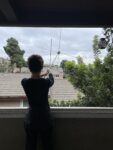
The air is so clean today- the rain has washed and blown away the particles that caused the air pollution spike at the end of last week.
2023-12-31 11:38:40
Soph Dyer
Carezza, Italy
Italy
NOAA-18

Very cold, a few snowflakes in the air. I failed to press record!
2023-12-30 09:32:43
Sasha Engelmann
Fox Hills, Culver City, California, USA
USA
NOAA-19


On my way to LAX airport to drop off my brother this morning, the air was so misty and wet, and the rain was so "strong", that people were driving at almost half the normal speed limit- a sign that the rain is affecting how people feel in LA. I didn't think the same would be true of people or drivers in the Pacific Northwest or Europe. By the time I caught the satellite pass, the clouds had parted and the sun was hot on the balcony.
2023-12-30 11:46:17
Soph Dyer
Lago Inferiore, Mantova, Italy
Italy
NOAA-18


Still, damp air, mild. Beautifully misty. Mottled sky.
2023-12-29 09:43:41
Sasha Engelmann
Fox Hills, Culver City, California, USA
USA
NOAA-19

The air has been warm but the visibility is low- a light fog has settled over the Los Angeles basin. Throughout the day the fog became more dense, and was likely trapped by the marine layer of cold air coming in from the Pacific.
2023-12-29 11:51:45
Soph Dyer
Near Mantova, Italy
Italy
NOAA-18


Low, thick cloud cover. The air was warm and moist. Low light despite it being nearly midday.
Standing between the fields, there were no obstructions other than telegraph and electricity pylons. It was amazing to as “see” the southern boarder of Algeria.
2023-12-28 19:00:15
Soph Dyer
Bergamo, Italy
Italy
NOAA-15


It is my second night in Bergamo at same location but with my v-dipole antenna instead of the turnstile. Yesterday I learned that that the radio environment was noisy, however I was still surprising to receive no image.
During the day Nicola and I observed an opaque haze hugging the alluvial plains of Lombardy. At dusk, a narrow slip of sky, frame by the haze below and clouds above, glowed blood red. Having heard how the Alps trap air pollution from the small factories on the plain, the red glow felt menacing.
2023-12-28 09:58:30
Sasha Engelmann
Heather Village, Culver City, California, USA
USA
NOAA-19



A very warm, bright balcony
2023-12-27 22:05:20
Soph Dyer
Bergamo, Italy
Italy
NOAA-18


Hazy, damp cold. First night in Bergamo.
2023-12-27 10:08:41
Sasha Engelmann
Culver City, California, USA
USA
NOAA-18
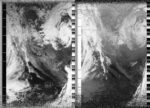

It is a sunny and bright morning. As many people are working today after a few days holiday break, the air is filled with sounds of vacuum cleaners, washer/dryers, leaf blowers and home DIY equipment.
2023-12-26 10:20:51
Sasha Engelmann
Culver City, California, USA
USA
NOAA-18




The humidity is unusually high today- around 88% The local park was very vibrant and active, with a young soccer team and a group of people throwing frisbees. On my way back home I noticed several policemen checking parked cars along Green Valley Circle. One group had what looked like a kit with a brush- I wondered if this was for fingerprints. Had the humidity of the air affected which fingerprints could be lifted off car doors, handles and windows?
2023-12-26 18:10:44
Soph Dyer
Wien, Austria
Austria
NOAA-15

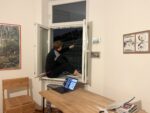
Dark, mild.
2023-12-25 10:36:26
Sasha Engelmann
Culver City, California, USA
USA
NOAA-18


There is a soft light today, like the air is filled with small reflecting particles, whether water droplets or dust.
2023-12-25 09:20:08
Soph Dyer
Wien, Austria
Austria
NOAA-19


Grey and so warm. It's Christmas (and my birthday). The horrors being reported from Gaza seem to be worsening: Heavy weather, lethal weather. Clouds maps are always moving. Clouds make visible our shared breath.
2023-12-24 10:46:10
Sasha Engelmann
Culver City, California, USA
USA
NOAA-18



The sun was very bright and the air so warm today, I ended up in a t-shirt while capturing the satellite pass. The park was lively as a soccer team started warming up and a group of walking womxn did laps on the sand trail. I was on a video call during the whole satellite pass, and this made me reflect on the ways the signal from my phone was relaying through a nearby cell tower and onward to the other side of the planet, while the NOAA satellite above me sent radio waves to the ground – I wondered, did the signals touch?
2023-12-24 09:29:15
Soph Dyer
Wien, Austria
Austria
NOAA-19


windy, mild, a small amount of blue sky, it's Christmas eve!
2023-12-23 21:14:06
Soph Dyer
Wien, Austria
Austria
NOAA-18

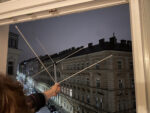
Mild, very windy, raining
2023-12-23 09:12:47
Sasha Engelmann
Culver City, California, USA
USA
NOAA-19


Today the light is a pale yellow and the air shimmers with leftover water evaporating from puddles and storm drains in LA. The city smells more intensely, as if all the materials on concrete surfaces, roads and sprawling buildings have sublimated. Throughout the satellite pass, the roar of airplanes taking off from runways at nearby LAX was palpable, though the misty clouds meant none of the planes could be seen.
2023-12-22 09:25:50
Sasha Engelmann
Culver City, California, USA
USA
NOAA-19




There were flood risks in Southern California over the last few days as the region received storm cell bursts. I recorded my image during a clear break in the rain, though the air, ground, trees and sidewalks were still soggy. A woman was throwing a branch to her Australian Shepherd in the park while I was recording the image. The dog was kicking up so much mud its multicoloured fur was completely mud-coloured after a few minutes. As I returned inside after the satellite pass, another burst of rain began pounding the roof of my Mom's condo.
2023-12-22 09:53:21
Soph Dyer
Wien, Austria
Austria
NOAA-19

clear skies after a storm, solstice sun, strong warm wind, wet wood of the balcony